Australian
and international
exploratory
performance and
media arts
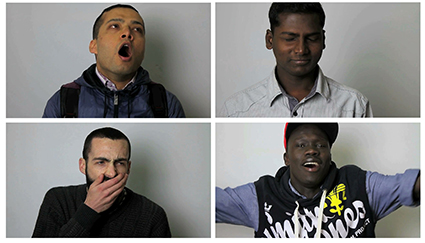
Yawn, Renae Shadler and collaborators
Designer Anna Tregloan is curating the Australian component of the 2015 Prague Quadrennial of Space & Design (PQ), the largest scenography event in the world. Attending the event in 2011—while on an Australia Council Fellowship–and PQ symposia in intervening years, Tregloan was inspired, “particularly by designers and artists working with sound and spatial dynamics—real space and real time rather than pretty costumes or fabulous scenic painting. I found it really interesting in terms of what’s happening in contemporary performance as a world overview. Seventy countries come together and they show works in a variety of ways. Some are snippets, some full-length works.”
What Tregloan finds fascinating is the way PQ is looking at design as something that happens in the here and now and examining live performance from that perspective, making it special and different from recorded culture.
Tregloan will principally show documentation using video, books and interactive websites representing works that are “participatory and in-location,” like the film of Renae Shadler’s Yawn (2015), part of her In Ya Ear series, made with commuters in a railway station. “It’s a beautiful work because it’s very simply shot in a single frame with a whole range of human beings yawning for the camera. It’s participatory for the volunteers but when you’re watching it also becomes a participatory experience. Renae will collect Prague yawns on location and transfer them into the exhibit room each day.”
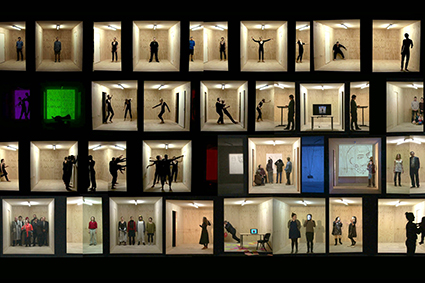
Democratic Set, Back to Back Theatre
Tregloan’s also showing Back to Back’s magical Democratic Set which is “non-traditional in its design frame and has been created with volunteers in 28 locations around the world. To me [these kind of works] are some of the strongest and most exciting around and I felt that the participatory aspect is (1) something that Australians do quite well and (2) it’s a really interesting take on performance in the context of PQ—kind of experimentation within the theatrical form and a bit of it is teasing out what theatre is today.”
Other works in Tregloan’s program that occupy public space are Super Critical Mass and PVI Collective’s Resist. The former is the MCA version involving 40 volunteers humming—“it was on the collections floor with works that we know quite well. The room, the whole space was refreshed by the action of the mass. We’re going to show documentation of Resist and make a new version of it—a collaboration between Prague and Perth. PVI’s Kate Neylon will be in Prague canvassing citizens for the hot issues that they want debated.” A tug-of-war will take place in Perth with locals representing the citizens of Prague; “it will be documented and sent to Prague.”
These works attracted Tregloan because of “their participatory nature and the other semantic I’m working with, the power of mass. [PQ’s other themes are music, politics, space]” Titling her curation The Mass, she says she is “working around the idea of weather as the outcome of mass action. A single raindrop is not rain; a mass of raindrops becomes rain.” Similarly, people put politicians in power, a mass effect, and they deal with the weather. To further the metaphorical connection, says Tregloan “we are going to have giant meteorological balloons in the room. Some days the room might be quite full and on others have just a single balloon. Because of the theme I wanted something participatory in the room that would be very simple. The air currents you create will shift the balloons around or you might need to push them out of the way.”
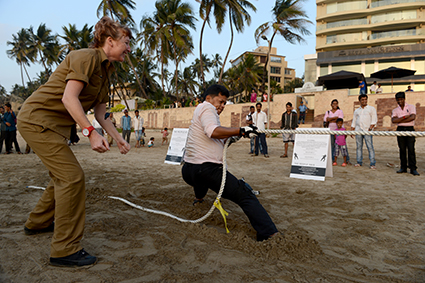
Resist, Mumbai, PVI Collective
photo Punit Paranjpe
Resist, Mumbai, PVI Collective
Also featured in an adjunct exhibition are Melbourne sound artists Madeleine Flynn and Tim Humphrey with their Melbourne Ports work Five Short Blasts as part of the City Walks program in The Space exhibition, which is about design but comes from an architectural background…more focused on relationships between temporary events and permanent architectural spaces. Scripted with a local writer, it’s going to be presented on the Vltava, the beautiful river that runs through Prague.”
Although more conventional theatre, The Malthouse production The Shadow King will be represented for its innovative design, especially the use of participatory filmmaking for its projections and for its dialogue between “a very old play and an extremely old culture.” The spiritually potent dilly bag from the production will be exhibited in the Object section of PQ.
Other exhibits include NORPA’s The Home Project which focused on the Winsome Hotel’s history as alternate cabaret scene, band venue and now homeless shelter and soup kitchen in Lismore. NORPA put several artists in place, working with the residents, collecting stories and creating, says Tregloan, “a one-off Hospitality event” for people welcomed back to the venue.
Tregloan emphasises that PQ “is not a market. It’s a tasting, a feast. It’s not like many biennales where everything is clean and neat and in its place. It’s quite an anarchic event. This is another of its strengths. It means everyone is there on an investigative path and you make your own way.” RT
PQ 2015, 13th Prague Quadrennial of Performance Design and Space, Prague, 18-28 June; PQAU is an initiative of the IETM-Australia Council for the Arts Collaboration Project and with support from Arts Victoria.
RealTime issue #126 April-May 2015 pg. 40
© RT ; for permission to reproduce apply to realtime@realtimearts.net
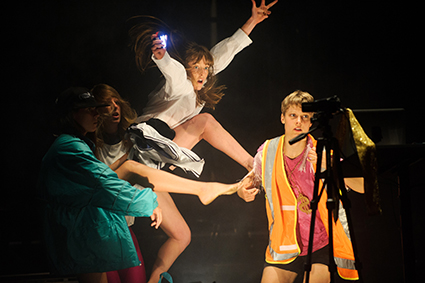
Overworld
photo Sarah Walker
Overworld
At Dance Massive Varia Karipoff encounters works from emerging and established artists that engage with the relationships between the body and its manifestations on screen, in ethnicity and the everyday as well as with ritual and the anxieties of mortality.
Rebecca Jensen & Sarah Aiken, Overworld
There are two scenes that capture the audience in Overworld, an interchangeably blithe and scathing take on popular culture and alternative spirituality. The first is the opening scene when the four performers are tightly enshrined in a pentagram constructed from a rainbow of op shop detritus. From a foetal position they become activated, awakening physically and mystically in a primal, pulsing and (seemingly) un-ironic fashion before unleashing chants that sound like three-second sound grabs from YouTube videos.
The second scene is the climax, where playful chasing and orgiastic discarding of costumes gives way to a frenzied altercation between two performers. The defeated is left lying naked and wounded—I saw welts on her skin. The sounds of the scuffle are recorded on mobile phones and played back—the phones placed at rest in coloured glass vases like oil lamps in a temple, distressed female cries wafting out instead of smoke. The effect is just as voyeuristic and uncomfortable as seeing the crumpled body lying prone. Incongruously, the victim then rises to eat an ice cream offered from a crystal plate. With the performer playing goddess and victim, the feminine is explored in the context of religious ceremony and pop culture. This idea is returned to in the closing scene, where the quartet ham it up to rap music, notorious for both objectifying and empowering women.
There was a jerky transition when the note-perfect ceremonial-type chanting cut to a lengthy and odd audience participation exercise. Despite this touch of chaos, Aiken and Jensen hit gold when examining the right to access mythic traditions in contemporary terms.
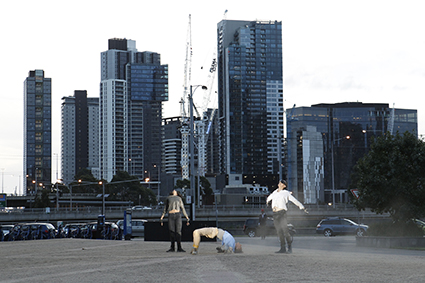
Depth of Field, Chunky Move, Dance Massive
photo Jeff Busby
Depth of Field, Chunky Move, Dance Massive
Chunky Move, Depth Of Field
On the Malthouse Forecourt, a dancer puts on a pair of gloves and strides through gravel and sand, her boots raising dust. We could be on the set of a post-apocalyptic outback film, although even with headphones on, the city seeps in, becoming the backdrop in landscape and soundscape, our view framed by it. Pedestrians making their way home in early autumnal dusk stop to look in on the action. Our hands are raised to shield our eyes from the setting sun, which slides behind skyscrapers. The effect is slick and cinematic. Across the road, a man in yellow is dancing, his jagged moves like an inexperienced hip hop busker.
Depth of Field commences; it’s a bone shuddering, breakneck, frenetic action drama that spills beyond the Malthouse forecourt. Three dancers swirl violently, landing in the dust, rolling as though thrown from a vehicle, their bodies propelled by external forces. Sometimes they seem to be in control, as though in a fight only to be knocked down again, their movement slowed down. They run as if being pursued, dazed, wide-eyed. One dancer uses her skull to balance in improbable poses. Pedestrians stop and stare; two women on bicycles go by. As the dancers begin to come together, making contact with dramatic lifts, we suspect that small scenes going on at the edges of the dance just might be orchestrated too. On cue, pedestrian extras and dancers alike fall to the ground as one.
Victoria Chiu, Do you speak Chinese?
A line from the score to Do you speak Chinese? refers to “white Australia’s hungry ghost.” Like that ghost, we often willingly consume multiculturalism, as long as it comes in a take-away box. Choreographer and dancer Victoria Chiu and collaborator and dancer, Kristina Chan, elegantly turn over questions about post-colonial identity and the connection between language and roots just as deftly as they fold giant sheets of paper. First the paper obscures their faces (and by default, race and identity) then in a contemplative roll and twist their bodies manipulate the paper to form a sailboat, a nod to Chiu’s native Hong Kong. Chiu doesn’t speak Chinese. We hear a language lesson where it is discovered that what was assumed to mean “Happy New Year” is actually a blessing for financial success.
We embrace Chiu’s awkwardness; she enters the space feet first, sliding on her back, writhing in, feeling with her hands the corners and liminal spaces of the room. It’s a visibly painful way to move. When the dancers stand, they continue to obscure their faces, mashing them with their hands, pulling their eyes into thin openings. Finally, we see that their faces are indeed ‘Chinese’ and the reveal is loaded. Moments of flowing movement give way to confrontation. Chiu and Chan fight their way into long knit dresses—simplified cheongsams; their limbs form angular, uncomfortable shapes as they wrestle in the restrictive fabric. With striking paper props and light humour, Chiu questions her wrestling and ours too. When a musician plays the guzheng, the sound is so achingly haunting we also miss a China we don’t know.
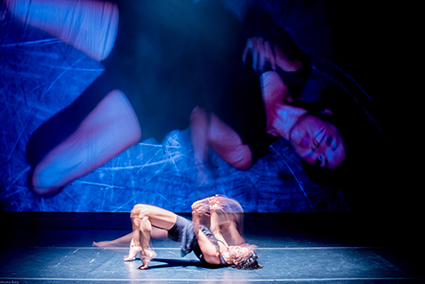
Paula Lay, Ten thousand small deaths
photo Mischa Baka
Paula Lay, Ten thousand small deaths
Paula Lay, 10,000 small deaths
Walking into the theatre through an aperture-like opening of black curtains sets the tone for Paula Lay’s polished dance-cinema work. The title makes one think of the French idiom for orgasm, la petite mort (the little death) and sure enough, Lay appears from the darkness, on her back, pulsing and straining, lifting herself up on her hands. A camera captures her sinew and strength, dramatising it as cinema does, projecting it onto a screen (video Martyn Coutts). In comparison Lay’s body seems slight, less dramatic. The camera exaggerates and tricks, stealing from reality to create something more desirable. Where the opening scenes recall birth, or at least an earthy act, the piece ends with a death. In a video projection, Lay, naked and in a foetal position, is slowly buried on a forest floor.
The interaction between film and dance provides moments of telling interplay. In a black and white short film, Lay is topless, apparently on a beach, the shot tightly framing her body. She waves her arms deflectively, or it could be a practised action, like tai chi. The movement is slowed to motion blur. In darkness Lay stands next to her screen self; as the giant shadow of her arm descends it momentarily illuminates her as if cutting her down until the arm in the film repeats the motion.
The notion of a ‘small death’ also brings to mind Flaubert’s A Simple Heart, where the protagonist—an uneducated country maid—leads an unexamined life and dies her small death in a crumbling house. Repetition and fluidity are cornerstones of Lay’s 10,000 small deaths, one motion running into the next as days do. The repeated movement looks a lot like a training montage—though graceful and ritualistic at first, continual repetition implies that it lacks significance as though time has sped up and reduced existence to the movements the body makes in the everyday.
Sue Healey, On View: Quintet
Five characters each ‘own’ a screen, as they later each own a kind of spirit animal. The screens hang in a semi-circle. The characters are built from moments on screen and from their movements in front of us, a visual archive of their individuality. We get to know Raghav Handa’s wide-eyed stare and the way his hip dips as he performs a turn. Shona Erskine, a tall, regal presence who dances with a stuffed fox, I quietly dub, Julie Andrews. The quintet is painted in generous cinematic strokes, with extra layers provided by luxurious costumes and lush cinematography. In towering platform stilettoes Benjamin Hancock is especially splendid; he doesn’t seem to possess bones as he displays super human flexibility in what can only be described as a gimp rabbit suit, complete with stocking ears ending in tufts of fur. Likewise, Nalina Wait, exhibiting emotional range as a voluptuous starlet in a silver shift dress, interacts with her film shadow, first letting it correspond to her movements then running counter. Eventually the line between screen and live action is blurred with projections onto muslin held by the dancers and then on skin, and once I am certain there is a projection of a projection—a visual and semantic tangle.
On View is most effective when it is confronting. After we have idly, judgmentally watched them on screen, the performers are released into the live space to stare into the audience. Otherwise this is a contemplative and introverted work, not so much revealing the dancers as ruminating on the way we see others.
Dance Massive 2015: Overworld, Rebecca Jensen & Sarah Aiken, Arts House, North Melbourne Town Hall, 10-14 March; Depth Of Field, Chunky Move, concept, choreography, direction: Anouk van Dijk, Malthouse Forecourt, 6-14 March; Do you speak Chinese? choreographer, performer Victoria Chiu with Kristina Chan, Malthouse, Tower Theatre, 18-21 March; 10,000 small deaths, choreographer, performer Paula Lay, Dance House, 20-22 March; On View: Quintet, film, choreography (with the dancers) Sue Healey, Dancehouse, 20-22 March
RealTime issue #126 April-May 2015 pg. 24
© Varia Karipoff; for permission to reproduce apply to realtime@realtimearts.net
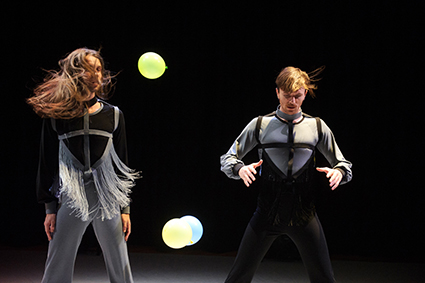
James Andrews, James Welsby, Dreamlogic, Phantom Limbs, Dance Massive
photo Sarah Walker
James Andrews, James Welsby, Dreamlogic, Phantom Limbs, Dance Massive
“I liked the fact that I could not keep track of my dancing whilst talking and vice-versa.” Trisha Brown, talking during Accumulation plus talking plus Watermotor (1979);(recorded New York, September 1986).
As I lean forwards in my chair, I feel that my conscious intention is what animates this movement, that I am the one who initiates the move. While some of my actions are habitual and unthinking, I still have the sense that they are my actions, brought about by my implicit intentions. How do I know this? What do we really know about the way thought functions in the body?
Dreamlogic begins with a similar conundrum. A man (physicist Leonard Mlodinow) is heard speaking about science, neurons, experiments and the unconscious. Not the Freudian unconscious but an unconscious associated with brain activity. The suggestion is that there is a field of neural activity, perhaps very large, of which ‘we’ are not aware.
Dancers are, it seems to me, more inclined to accept the proposition that there is a bodily unconscious. Speaking about dancing Yvonne Rainer’s Trio A, Sara Rudner claimed, “When it came right down to it, you were there to do the dance; the best thing that happened was the body took over and the dance happened.” Improvisers likewise try to make space for new material to arise, beyond their conscious deliberation. Dance training also heavily depends upon habit-formation, which, once established, operates without the assistance of conscious supervision.
Dreamlogic locates itself within this bodily realm of movement sans consciousness. Two dancers (James Welsby and James Andrews) enter a space ringed by electric fans. They blow up balloons which they roll around their bodies. Perhaps the balloon represents a neuron or a networked form of agency that lies beyond the dancer’s awareness? The dancers adapt their movements to the dictates of the balloon. To that extent, their movement is not controlled by some sovereign consciousness.
Of all the different aspects of the human body, consciousness is the most elusive to explain in scientific terms. We are acquainted with our own conscious thoughts, but what do we know from a third person point of view, that is to say, objectively? MRI brain imaging has produced a lot of information about the brain, raising the status of neuropsychology within the field of psychology.
Dreamlogic takes up this question from a kinaesthetic point of view, raising the possibility of a movement unconscious or, as they put it, “can consciousness exist outside our brain’s concept of the body?” As the music begins, the two dancers execute a series of movements in mirror formation. This slowly shifts into another kind of repetition, towards subtle aspects of difference. One dancer executes a leg circle one way, the other the reverse. Perhaps this is an attempt to displace the linear logic of movement, to question our sense that time moves forwards. Lines are drawn across the body, movement patterns established, varied, doubled or decentred. Perhaps there is an abstract element to the dancing, the creation of movement patterns outside human expressivity. The balloons return, changing the quality of movement to the dictates of the spherical object.
Welsby and Andrews move towards the circle of electric fans onstage, turning them on in turn. The air movement from the fans circulates, keeping the balloons in a kind of Brownian motion. Many more balloons are added to the mix, creating beautiful and mesmerising swirls of activity. Ending with this poetics of neural activity, the dancers quietly leave.
To what extent can we say that human actions occur at an unconscious level? There was I think an opportunity to investigate these ideas at a choreographic, performative level, in terms of the dancing itself. By and large, the set movements in Dreamlogic were performed in a knowing manner: choreographically, the dancers knew what was coming, what they were doing and basically did it. The balloons formed a kind of exception, in that the body had to adapt to their motion. There are ways to make work where the choreographic demands necessarily exceed the dancer’s conscious intentionality, for example Trisha Brown’s Accumulation with Talking plus Watermotor (quoted above). It would have been interesting to watch the dancers in Dreamlogic grapple with these issues in performative terms, towards a sense of the unconscious in motion.
Phantom Limbs, DREAMLOGIC, creators James Welsby, Amy Macpherson; performers James Welsby, James Andrews, Darebin Speakeasy, Northcote Town Hall, 6-10 March
RealTime issue #126 April-May 2015 pg. 25
© Philipa Rothfield; for permission to reproduce apply to realtime@realtimearts.net
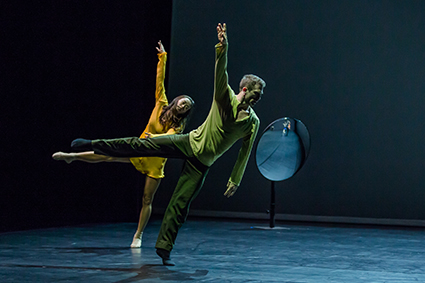
Sydney Dance Company, Chloe Leong, David Mack, Quintett, William Forsythe
photo Peter Greig
Sydney Dance Company, Chloe Leong, David Mack, Quintett, William Forsythe
Mysterious objects: a large, antique projector to the right; a reflector disk facing it on the diagonal in the back corner. From out of silence: the sublime plangency of Gavin Bryars’ “Jesus’ Blood Never Failed Me Yet,” the looped delicately quavering voice of the aged singer gradually underscored with melancholy strings and brass—a musical perpetuum mobile, ordinary and profound.
In harmony with and radical counterpoint to this humble evocation of infinity and faith, five young bodies solo, intersect and duet across the space in various permutations, their movement the language of classical ballet seamlessly interwoven or interpolated with stalking crawls, elegant crabwalks, casual strolls, atypical lifts (a dancer hoisted by her horizontally extended forearm), precarious leaps and catches. Bodies and floor are slapped, a bottom forcefully bumped by another, arabesques flawlessly executed and the space shared by contrastive duets and solos that make architectural sense—as ever in the choreography of William Forsythe. Of course, the legacy of Forsythe is written through today’s contemporary dance and its hybridisation with popular dance forms, martial arts, media arts and the theatre of simultaneity, but Quintett remains strikingly original, a cogent ballet performed with great precision, remarkable abandon and realised with a surreal theatrical sensibility. Late in the work’s 25 minutes as light fades, the projector flickers on, enabling brief passages of elusive shadow play before the dancer slides head first beneath a side curtain only to find herself dragged back centre-stage where she readies to dance again. Blackout. It’s a not-quite resolution. The dance and song live long in us.
The opening night’s impressive, responsive and necessarily highly flexible dancers were Chloe Leong, Jesse Scales, David Mack, Cass Mortimer Eipper and Sam Young-Wright under the direction of Forsythe’s assistant stagers Thomas McManus (one of the original dancers of the work) and Ana Catalina Roman Horcajo (who appeared in it subsequently). Quintett abounds with sheer formality, unexpected angularity, calculated off-centredness, exquisite head and arm work (two hands grip a head to turn a body), humour and watchfulness. These were realised by the dancers with precision and evident passion.
It’s long been reported that Forsythe composed the work in 1993 as “a love letter” to his 32-year-old dying wife, leading to much speculation about the work’s meanings. McManus has said in an interview, “Bill never said that Quintett was about anything in particular…for us it was a very joyful experience.” Certainly, Quintett’s mere 25 minutes are dense with possible meanings, heightened by the awe with which we regard the dancing and its inherent joyfulness despite the apparent melancholy of the serene music that suffuses it.
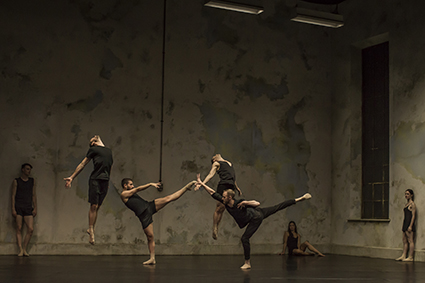
Sydney Dance Company Ensemble, Frame of Mind, Rafael Bonachela
photo Peter Greig
Sydney Dance Company Ensemble, Frame of Mind, Rafael Bonachela
Bryce Dessner’s Aheym, played by the Kronos Quartet, is the score for Rafael Bonachela’s Frame of Mind. Next to Gavin Bryar’s melodic minimalism Dessner’s writing in Aheym (“homeward” in Yiddish), if characterful, is in the vein of the familiar chugging minimalism of Philip Glass. Bonachela works relentlessly close to its pulse with rare moments of counterpoint, focusing on speed whether in solos, ensembles or the company en masse. Consequently the busy-ness makes it difficult to focus on motifs or to grasp the work at once, in contrast with being drawn into Forsythe’s engrossing fast-slow oscillations in Quintett.
Bonachela’s motivation for Frame of Mind is the split he experiences in having two homes, one in Europe, the other in Australia and the resulting desire to inhabit both places at once. Consequently, the design for the 34-minute Frame of Mind by Ralph Myer is a vast, expressionistic room, towering vertiginously high. Its mottled walls suggest age (separation as an eternal curse? A “melancholy memory room,” writes Myer), its huge window (the frame of mind) lets in the light of day, night and change of seasons, and darkens for interiority. Performers linger along the walls, slip in and out of the dancing or exit and re-emerge in displays of tight unison with 16 bodies suddenly soloing at once before re-uniting. The image is powerful if not greatly revealing beyond emphasising the together and apartness that seems to pervade the company and ensemble passages, while the forceful solos express emotional pain. One unusual gesture stands out—a hand held across the eyes and then shifted away to lead the next movement: a motif suggesting a closed-in, displaced self breaking out? In a final, vigorous solo Cass Mortimer Eipper opens with this motif but in the end sinks to the floor with an arm across his eyes. Can the strange exile of being at home but not at home be endured? The work’s tormented propulsion and its intense solos suggest not; nor is reprieve found in pulsing crowds.
Bonachela sees Frame of Mind as “an acknowledgement of our emotional lives” without the need for words (program note). Although powerful in part, it’s not clear that Bonachela’s choreography, however deft and finely articulated, says more than is obvious about his plight. Juxtaposing Frame of Mind with Quintett was doubtless a challenge—the sheer scale of the Bonachela, dense with numbers and an uncomplicated premise, up against the small ensemble lucidity of the Forsythe, dense with meaning.
Sydney Dance Company, Frame of Mind: Quintett, choreography William Forsythe and original dancers, design, lighting William Forsythe, costumes Stephen Galloway; Frame of Mind, choreography Rafael Bonachela in collaboration with dancers, set, costumes Ralph Myer, lighting Benjamin Cisterne; Sydney Theatre, 6-21 March
RealTime issue #126 April-May 2015 pg. 26
© Keith Gallasch; for permission to reproduce apply to realtime@realtimearts.net
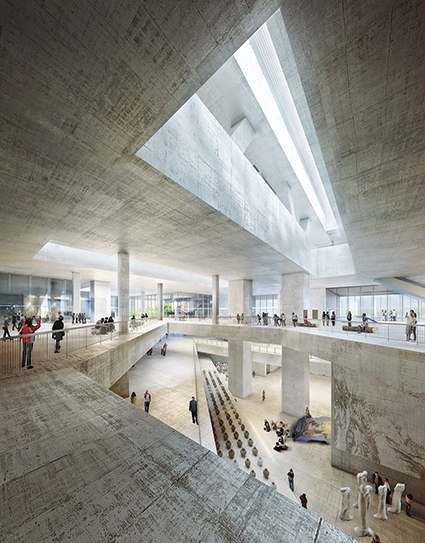
Section from architects’ plans, M+ Museum, Hong Kong
image courtesy Brunswick Arts
Section from architects’ plans, M+ Museum, Hong Kong
Last year’s National Association for the Visual Arts (NAVA) summit Future/Forward (Carriageworks, 6-7 Nov, 2014) opened with a fine keynote address from Nikos Papastergiadis on the theme of art in a borderless world. In what sense, he asked, does art cross borders? Art does not do this ‘in and of itself,’ so what enables this new order of global mobility? These questions led to a consideration of changing cultural and aesthetic frameworks, and the potential for arts institutions to have a transformative influence.
A focus on new kinds of institutional presence was further developed in the second keynote lecture, from Hong-hee Kim, Director of the Seoul Museum of Art (SeMA). Her vision of the post-museum was articulated as a shift from order and control towards interpretation and flexibility, from an emphasis on collection to a foregrounding of curatorial enterprise extending beyond the confines of the building. SeMa brands itself as “a post-conventional, post-institutional art museum that comes after the time of neoliberalism.”
Carriageworks as the new
At Carriageworks, she was speaking to an audience of the converted. And Carriageworks itself, with its community markets and hybrid mix of exhibitions and performances is already a prototype for the kind of reinvention she was advocating. In Korea, the cultural shift associated with the idea of the post-museum has very different resonances from those we are familiar with in Australia.
Carriageworks is a massive industrial construction, a conversion of the former Eveleigh Rail Yards in which the space is still defined by massive iron girders and rail tracks that remain embedded in the floor. The art events presented here adapt themselves to the building, not the other way about. During the days of the NAVA conference, works by the Torres Strait Islander artist Ken Thaiday were exhibited in the main hall. These sculptural interpretations of traditional masks and sea creatures spoke of a deeper history and a cultural heritage divorced from that of Australian industrial modernity, yet the polarised aesthetic registers were a remarkably effective co-presence (see our video interview with Thaiday and images of his work).
SeMA, Seoul
Architecturally, SeMA reflects a more complex and politically stressed urban history. The main museum is now located in the Jeong-dong area, where the foundations of a cosmopolitan culture in Seoul were laid in the 1880s, with the opening of the US Legation, the British Embassy and diplomatic residences for delegates from France, Germany and Russia. But the building itself belongs to a subsequent political era. It is the former Keijo Court House, constructed in 1928 during the period of Japanese colonisation. Its architecture reflects the aesthetic control imposed by the Japanese administration, under which traditional Korean craftsmanship and building techniques were suppressed in favour of neo-classical western design. The building was repossessed as the Supreme Court of Korea after the liberation in 1945.
SeMA’s occupancy dates back to 2002, when the Supreme Court was moved to another district. The building was substantially remodelled for the museum, but as the stigma of its origins has faded from public awareness, its intrinsic qualities have come to be widely appreciated, and it is now an important landmark in the city’s architectural heritage. As a building, it is the marker of a series of massive cultural and political transitions, through periods of cosmopolitan enterprise, colonisation, war, independence and back to a new phase of global enterprise. Its self-declared identity as a post-museum, defined in antithesis to that of the colonial or classical museum, is part of this most recent transition.
Since 2000, SeMA has hosted the Mediacity Seoul Biennale, which reflects the city’s ethos of ‘media-frenzy’ and celebrates its internationalism. The 2014 festival began with a shamanistic ritual performed in traditional ceremonial robes “to cleanse any history of agony or tragedy left behind at the site of Seoul Museum of Art,” and then spread around the city with works from 17 countries. The celebration of a contemporary electronic environment infused with deep histories of conflict and trauma displays the post-museum agenda as something much more significant than a branding exercise in a competitive tourist market.
Heritage and nationalism as business
But the competitive tourist market is one of the realities to be negotiated in the 21st century museum world. Income has to come from somewhere, and league tables of visitor numbers, tourist ratings and internet hits creates a feedback loop: everyone wants to go where everyone wants to go. Inevitably, there is a nationalist edge to this competition. Paris, London, New York and Washington dominate the league tables for visitor numbers in 2014, though South East Asian museums are strengthening their hold in the top 20. Scale and spectacle are primary attractions, but the dominance of the Louvre, the National Museum of China, the Vatican Museum, the British Museum and the National Palace Museum in Taiwan indicates that antiquity is a major drawcard.
Does this mean that the post-museum is defining itself perversely in opposition to historic cultural institutions that remain at the forefront of the public imagination? Perhaps there have been some rather glib presumptions about what is ‘elite.’ The Louvre is a quintessentially aristocratic foundation, but cultural hierarchies are not constant, and part of its allure now is that anyone who can afford the admission price (about $13 AUS) can traipse through. At any hour of the day, the crowd staring at the Mona Lisa will be looking from many points of view. Some will have scholarly knowledge, and some will want to acquire it from expert guides. Some will be Dan Brown fans. Some will just be concerned to capture it in their cellphones. Whatever the anxieties and enthusiasms of the institutional staff who congregate at international forums about the reinvention of the museum, there is no getting away from the fact that heritage is core business. Visions of the future projected onto screens and evoked in hologram do not exert the same potent influence on the human psyche as the works of past visionaries, massively etched in stone and cast in bronze. There is no getting away, either, from the history of the museum as national symbol.
Hong Kong’s M+ rethinks the museum
The establishment of a major museum can be a bid to shift the epicentre of cultural capital, and this is clearly the case with Hong Kong’s M+ project. According to Executive Director Lars Nittve, M+ “means museum and more, museum and beyond.” The plans presented to him by the Hong Kong government, he says, were “very ambitious,” both in scale—the footprint was to be some 45,000 square metres —and in concept. He was charged with a mission “to rethink what the museum is in the 21st century and challenge the given models.”
With a six-year construction period and a completion date in 2017, architects Herzog and de Meuron are working to a tight time frame, but since the plan is for the museum to spill out of the building with exhibitions in the surrounding area, its opening does not have to be commensurate with the opening of the building itself. In contrast to SeMA, M+ will be a building without a past. The site is a stretch of reclaimed land bordering Victoria Harbor, on the edge of the West Kowloon cultural precinct. So even the ground is, in the words of the architects, “somehow innocent, virgin.” They envisage the structure as a “semi-transparent vertical plane,” the sides of which will serve as massive LED screens for the projection of images.
Arts into a single edifice
Conceptually, this expresses a bid to erase borders and boundaries of all kinds. Original plans for the site divided the space to accommodate four separate museums, dedicated to visual arts, popular culture, cinema and design, but this approach was abandoned in favour of merging them into a single edifice. Erasing the discipline boundaries, according to curator Tobias Berger, is “very Hong Kong,” as this is a place where people often excel in more than one profession and pride themselves on acquiring several channels of expertise and experience. Inside the building, visitors will be able to watch the experts at work, through transparent walls, so that every aspect of the process of preparing and planning an exhibition will go public.
All this amounts to a comprehensive fulfillment of the criteria by which the post-museum defines itself. The design and planning processes at M+ are led by people of extraordinary vision and talent, who are of course engaged in something more sophisticated than any box-ticking exercise. But one of the risks of the post-museum agenda is that it could too easily become a generic package, and a monolithic one at that.
While everyone loves the great turbine hall at the Tate Modern (also the work of Herzog and de Meuron), big isn’t always better. The lure of the monolith is part of the international museum tradition but upscaling can kill the appeal. Museums also serve to remind us that we humans are animals, and part of their appeal is to present us with an array of forms that are like and not like us.
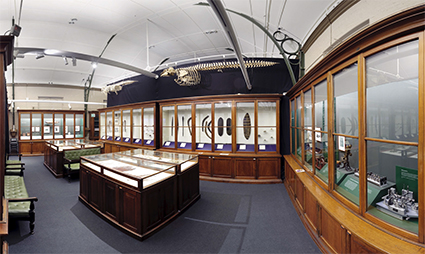
Macleay Museum Gallery, Sydney, 2006
photo Michael Myers
Macleay Museum Gallery, Sydney, 2006
On a human scale
One of my favourite museums is the Macleay (see part 1 of this essay in RT125, p 10), housed in the Victorian Tudor building of that name in the grounds of Sydney University. Preserving the unique collection of specimens bequeathed by the Scottish naturalist Alexander Macleay (1767-1848) is an unashamed priority. Bottled reptiles, pinned insects and stuffed animals are displayed under glass, in polished cedar cabinets. Exhibitions are managed on a shoestring budget, occasionally augmented by funding for those that are part of a PhD program. This year the museum has hosted presentations from candidates in a variety of disciplines including history, archeology and the visual arts.
Places that relate to the scale of the human body can resonate deep in the psyche. Entering the Macleay is like going into a time-warp. With its aura of antiquarian science, the closely stocked interior also evokes a world of childhood dream and fantasy. Harry Potter—and any of his readers—would be on familiar ground here, and so would Lewis Carroll’s Alice, because they are denizens of a world whose boundaries shift and warp.
RealTime issue #126 April-May 2015 pg. 27-28
© Jane Goodall; for permission to reproduce apply to realtime@realtimearts.net
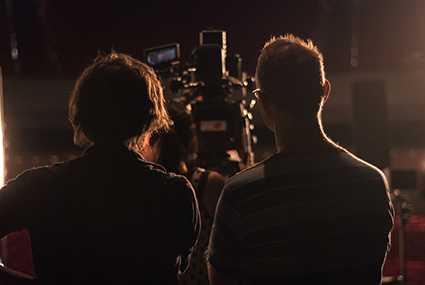
Dan Koerner, Sam Haren, creative directors of Sandpit in rehearsal
photo Jordan Mutton
Dan Koerner, Sam Haren, creative directors of Sandpit in rehearsal
In recognising the ever-increasing ubiquity of digital technologies in everyday life, the Australia Council for the Arts has offered support from the federal government’s Culture Fund towards two organisations for three-year initiatives to explore what this can mean for theatre practices and audiences.
The fund’s recipients, Melbourne’s Arts House and Country Arts SA have implemented programs spanning 2014-16 that invite artists to use digital technologies to enable new ways of working. Technology is not necessarily the subject, but rather provides the tools for artists to engage with in their creative processes.
The Creative Producers of Arts House, Angharad Wynne-Jones, and Country Arts SA, Steve Mayhew, recognise the rich history of contemporary practices utilising digital technologies and they are quick to distance themselves from any reckoning that this is a vanguard moment. Wynne-Jones notes that digital technologies are no longer a novelty in theatre or in the everyday, they are a central part of life and that this initiative is about putting them at the centre of artistic practice. The artists involved do not necessarily see themselves as having a ‘digital’ practice, but through their projects will problematise both their own methodologies and the societal relationship to technology. Mayhew concurs, seeing the initiative as “not about the discovery of the new but utilising what exists, utilising what you can do with what you can hold in your hand, because we hold it quite often.” For Mayhew it is also about a focused development of work “in a fascinating way that is full of exciting possibilities,” particularly for the regional audiences and communities he works with.
Arts House, In Your Hands
Although likeminded, the two organisations have structured their programs in different ways. The Arts House initiative, in collaboration with artist and researcher Robert Walton, is to shape the commissioning of a cluster of works under the title In Your Hands. The digital component is specifically aimed at making work with mobile technology. Wynne-Jones sees this as “not about the capacity of the digital in performance but how we experience the world through these devices that act as an extension of ourselves.” Artists have been paired to collaborate, exposing how a breadth of practices might approach the constraints of the brief in the making of new work. The artists are Tamara Saulwick working with Martyn Coutts and musician/composer Peter Knight; playwright Michelle Lee with director Tanya Dickson; writer, theatre-maker David Finnigan with media artist Keith Armstrong; and Walton himself with live artist Jason Mailing.
For Walton exploring the potential of theatre works on mobile devices is about understanding and encouraging work that can prosper outside existing institutional support structures, advocating for contemporary work that is for anyone, anywhere, anytime. So it’s slightly ironic that this exploration comes on the back of an Australia Council grant and through Arts House, but as Walton notes, we must always work within the known towards the unknown and new discoveries. He uses the term “itinerant art works” to describe the projects being made by the four teams in the program, where each work will “require audience members to physically move in order to performatively enliven or initiate the work.” In this endeavour artists will aim at viability for their practices outside of existing arts institutions and energise their engagement with sites and audiences. For Walton’s collaborator, Jason Mailing, the place of the digital technology in this making process is something they aim to make invisible in the end product, whereby the work “can’t happen without the device, but the device isn’t actually noticed. Like listening to a podcast on your mobile, it is simply the portal into a narrative.” In Your Hands is scheduled for presentation as part of the Festival of Live Art in 2016.
Country Arts SA
The Country Arts SA strategy has been to link artists with “technologists” to realise the use of digital technologies in their projects. The program has been conceived in partnership with the interdisciplinary creative studio Sandpit. Sandpit’s Sam Haren and Daniel Koerner are Artistic Directors of the program, with Country Arts SA acting as producer. The aim is to engage regional SA communities in the making of contemporary theatre that incorporates digital technologies in three different works. Creation Creation is the devising of a brand new world by artist Fleur Elise Noble (see p40) with designer Jonathan Oxlade and Windmill Theatre director Rosemary Myers. The Post Internet is a communal Internet to be made from face-to-face conversations conducted by performance collective post. Eyes is a musing on the end of days by Sandpit themselves. The works were not originally curated as a trilogy but nonetheless Steve Mayhew notes an uncanny similarity in terms of a beginning, middle and end of life. The concern right now is not presentation but development and community-engaged research. Mayhew stresses the importance of embedding the technologist in these processes from the beginning to ensure a holistic treatment of digital elements, to avoid the tacking on of technology as “screensaver wallpaper.” In this way the Country Arts SA program is about cross-pollination between artists and ‘geeks-in-residence’ towards making theatre work with an integrated digital element but always through the community-driven making processes for which Country Arts SA has established its reputation with a previous digital theatre project, If there was a colour darker than black I would wear it (RT 112 p.12), which utilised mobile phone technology. Mayhew is interested in how these new projects will take shape in regional settings and what can be gained for both artists and communities from a process of ‘beta testing’ in 2015, towards presentations next year.
Digital technologies are no substitute for the liveness of theatre, but concern that they might be regarded as such is necessary for Wynne-Jones because “our relationship to technology is so fraught, not in art but in life. To not engage is not a good survival strategy for the relevance of theatre.” In the dramaturgy of these programs the interest is in employing digital technologies but retaining liveness as a way of extending audience-performer relations. The conviviality of theatre is still inherent, it is just appropriated and re-framed. The live theatrical experience is being pushed to encompass the addictive relationships we have with technology, to question it, and Wynne-Jones hopes, “maybe even to change it.”
RealTime issue #126 April-May 2015 pg. 29
© Malcolm Whittaker; for permission to reproduce apply to realtime@realtimearts.net

Harley Stumm (back row 4th from L) with the team from “Hanuman Spaceman” including The Cambodian Space Project, director Carlos Gomes, Master Kong Nay, and staff and students of Kampot Traditional Music School (Khmer Cultural Development Insti
photo David A. Rosenberger
Harley Stumm (back row 4th from L) with the team from “Hanuman Spaceman” including The Cambodian Space Project, director Carlos Gomes, Master Kong Nay, and staff and students of Kampot Traditional Music School (Khmer Cultural Development Insti
Sydney-based Harley Stumm has been a producer since 1994, Executive Producer and joint CEO at Urban Theatre Projects 1995-2003 and Producer at Performing Lines 2005-11, managing the Mobile States contemporary touring program and producing 15 national tours by artists such as Splintergroup, Tanja Liedtke, Branch Nebula, Chamber Made Opera, version 1.0, Dancenorth, Marrugeku and Back to Back Theatre’s Democratic Set. As Intimate Spectacle, Stumm is now in his third year as an independent performing arts producer with a list of notable productions including, most recently, the co-production with Performance Space of Vicki Van Hout’s Long Grass (RT125, p.19-20).
Stumm is a passionate producer. A certain characterful gruffness signals directness rather than distance and fails to disguise his amiability. When we meet he chooses his words carefully; long thoughtful pauses are followed by lucid declarations of intent and conviction that leave you in no doubt about his principled commitment to innovative artists, contemporary practices and, not least, audiences.
Stumm dislikes the term ‘creative producer.’ “The position is inherently creative. I live at the intersection between being creative and problem-solving, making things happen. It’s a creative relationship with artists—not that I want to be in the rehearsal room saying change this and that, but I do want to be in touch with making the work, and that’s partly because I see myself not so much as an outside eye as a stand-in for the audience. I can say, ‘I don’t get it.’
“Much more important is that when artists say they have an idea for a show I want to be thinking from the beginning where the show’s going and who it’s for, what space and what presenter, who will fall in love with it—who will bring to the work more than just money? I want to work with presenters and producers we respect in a collaborative way and invite them into the making. I’m not going to dumb it down or commercialise it for a presenter; rather, they should bring some insight into how the work can respond to their space and the social context.”
Stumm is wary of “the transactional sell-off model with its tendency to say, ‘We’re not in this together; I’m selling this project to you and I’m not showing you my budget.’ Equally I want the producer and the artist to trust each other; the artist can ask, ‘Why would we play in a 600-seater; we thought of this work for a small theatre?’”
Relationships are central to Stumm’s approach to producing: “all of the artists are different—it’s to do with their art form demands, with individuals and how they work—Vicki Van Hout with her collaborators, and Team MESS a four-hander collective, each member with specific roles, responsibilities and equal status. Plus there’s history.” Vicki Van Hout and the members of Branch Nebula each have some 20 years of practice, while Team MESS is young company with seven.
“I don’t have a formal set of artistic selection criteria; that’s the beauty of being a sole proprietor—I never thought I’d be a business person! My approach is a little bit intuitive—about the work, the process, the personal relationship—and I’m not wedded to a particular art form, as long as it’s contemporary practice. As an unfunded independent producer I have to raise every dollar and the work has to be critical but also popular. Another inspiration for this ‘walking the line’ is to have the work go beyond generators like Performance Space and Arts House to Belvoir, Malthouse and major venues and major festivals. This was always (former director) Wendy Blacklock’s vision at Performing Lines.”
Stumm’s productions have included Erth’s Murder (Sydney and Adelaide Festivals and Ten Days on the Island), the live art installation I Think I Can by Sam Routledge & Martyn Coutts (Sydney, Perth and FOLA Festivals); a tour of Team MESS’ Bingo Unit and Lenine Bourke’s live art residencies featuring guided tours by children, The Walking Neighbourhood (Sydney in Art & About, the ANTI Festival, Kuopio, Finland).
“All the work that attracts me,” says Stumm, “is about the relationship between audience, art and the world. None of the artists I work with are auteurs who lock themselves away and come out with a finished piece. They think of the audience as collaborators: Team MESS might have the audience perform in a ‘cop show’; Branch Nebula, Matt Prest and Clare Britton put the audience inside the set of Whelping Box.”
Stumm also puts great store by continuity. His relationship with his newest client, Branch Nebula, goes back 10 years when Lee Wilson worked with Urban Theatre Projects where Stumm was Executive Producer and then at Performing Lines, taking their Paradise City after its Performance Space premiere to the Sydney Opera House and Brazil and, via Mobile States, across Australia.
Looking back to the RealTime-Performance Space Forum “Wanted: Creative Producers” in 2008 (RT 69, p40) at the time when touring networks were forming, the notion of ‘creative producer’ was being discussed and direct funding to producers being considered by the Australia Council, Stumm comments that at the time it was contentious to attach a producer fee to your grant application and that Wendy Blacklock had long cobbled together “temporary communities” to get works touring. Now, he says, “Selling contemporary work nationally is easier than it’s ever been.” This is partly because of a responsive new generation of presenters. Stumm cites Country Arts SA which runs regional venues, touring and the community cultural development regional program. “Under the directorship of Steve Mayhew and management of Craig Harrison the organisation’s Performance Development Program (formerly Local Stages) is not just touring but also producing work. They want contemporary artists to engage with the community, recognising that contemporary and community practices are doing similar things, if coming at them from very different positions, and meeting in the middle.”
Stumm describes the logistics of the Team MESS Bingo Unit tour to Renmark and Mt Gambier. The company arrives in Renmark for location shooting, drives to Mt Gambier, shoots scenes, bumps into the theatre, builds the installation, performs and then returns to Renmark to perform. The plot conveniently has the killer come from Renmark, his victim from Mt Gambier. “Country Arts SA put money and energy into the residency; Australia Council Theatre provided a Community Engagement Residency Grant for this new touring model; and Market Development offered a Hopscotch Travelling Grant for touring Live Art.”
As Intimate Spectacle, Stumm has been producing for two and a half years. He says he wouldn’t be good at commercial selling, “but I can sell contemporary work and make a living.” The big challenge in working with individuals and small companies is that they don’t have the financial resources to invest in a producer with whom they can strategise development, touring, reaching co-producers and presenters and applying for grants. This kind of work can go unpaid for a producer if possibly recouped from sales, 60% earned income in Stumm’s case to date.
Stumm is emphatic, “I love what I’m doing,” not least working on his project with a rock’n’roll band, the Cambodian Space Project, founded by Julien Poulson, a musician formerly from Tasmania, and Srey Channthy Kak, a singer originally from a village in Cambodia. Julien heard Channthy in a karaoke bar singing “Johnny Guitar,” thought ‘Wow!’ and formed the core of the band with her. “Channthy now lives in Sydney. I saw the band at the Basement three years ago with an Australian rhythm section. Channthy’s a charismatic singer and performer with a great voice.”
Channthy sings traditional songs and those of the Cambodian pop kings and divas of the liberal 60s before the arrival of the Khmer Rouge. An unusual choice is “House of the Rising Sun” covered by pop star Sinn Sisi Samouth in 1964; it has to be understood, says Stumm, in terms of genocide and all the artists executed. Most of the band’s repertoire is written by Channthy and band members.
What specifically attracted you? “I love music, I love history, I love intercultural practice. I saw in this band something so theatrical—the ideas, the story, the quality of the performance. I made contact on Facebook. It’s the only time I’ve approached an artist out of the blue. I asked them if they’d like to do something more theatrical, not a play. Then Julien had an idea for Hanuman Spaceman, a music theatre piece based on Channthy’s life in terms of Hanuman the trickster Monkey God in the Ramayana. She wants to go to the moon, looking for something more than a culture where there’s tension between individualism and collectivism with its memories of the Maoist regime and the Hun Sun government imposed by the Vietnamese. It excited me straight away.”
Plans were interrupted by Stumm’s emergency heart surgery in 2013 but subsequently an opportunity came up to participate in a laboratory run by Stephen Armstrong, the programmer of Asian performance at Melbourne’s Arts Centre. The lab brought together Australian and Asian artists. Casula Powerhouse in Sydney’s south-west quickly came on board as presenter of the Hanuman Spaceman project because of the work’s potential for community engagement (there are 12,000 Cambodians in the area). Then the project received Australia Creative Partnerships with Asia funding.
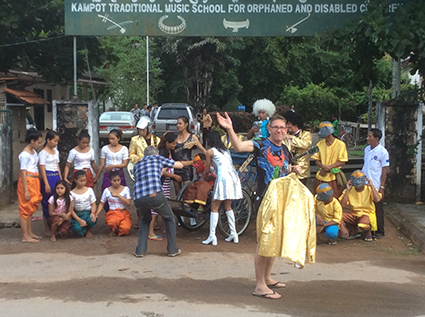
Harley Stumm with the team from Hanuman Spaceman
photo Carlos Gomes
Harley Stumm with the team from Hanuman Spaceman
Although the evolution of Hanuman Spaceman has involved considerable happenstance, Stumm puts it largely down to 20 years of networking and “pitching to the right place.” There’ll be a “casual residency and first draft performance ” this May at Casula Powerhouse. One of the demanding requirements of the grant is that there be an outcome in each country. The first was staged three hours out of Phnom Pen in Kampot, “a cool, hippy town with lots of expats.”’ Work took place at the Khmer Cultural Development Institute, founded in 1994 by a young English concert violinist Catherine Geach who was appalled by the legacy of the Khmer Rouge and the loss of traditional culture. Music and dance are taught to orphaned and disabled children.
Carlos Gomes from Sydney’s Theatre Kantanka joined the project as director for two weeks of rehearsal and a presentation, aided by a German documentary filmmaker, a UK giant paper-puppet maker, the band’s two young traditional dancers who can rock’n’roll and Kong Nay singing and playing his witty “Mekong Delta blues” on a traditional long-necked, two-string guitar. In his 60s he’s the Cambodian Ray Charles, blind since childhood and one of the few pre-Khmer Rouge artists to survive after being captured and forced to sing songs of praise to KR and about to be executed before being saved by the Vietnamese. Kong Nay is one of 17 Cambodian Intangible National Treasures.
Just what the work will become is yet to be seen: a rock opera or as Julien Poulson put it, says Stumm, “a concept album performed live”? Which is what it looks like in the photos and videos Stumm shows me of the highly successful outdoor performance. The focus of the Casula Powerhouse residency will be on collaboration with local Khmer musicians and dancers and the staging of three public performances.
For Stumm, Hanuman Spaceman is one of the most exciting projects he’s been involved in—“totally challenging, working in a poor country and with a band. It crystallises more and more for me the work I want to do. It’s out of the box, like nothing I’ve seen. We all want memorable experiences. We talk about formal innovation but it’s not abstract—the old ways don’t work. Some contemporary performance now is as old hat as heritage art for me. There’s a real energy about this collaboration. I feel it’s the future.”
www.intimatespectacle.com.au
Cosmic Cambodia, Casula Powerhouse, 15, 16 May; Harley Stumm, Intimate Spectacle
RealTime issue #126 April-May 2015 pg. 30
© Keith Gallasch; for permission to reproduce apply to realtime@realtimearts.net
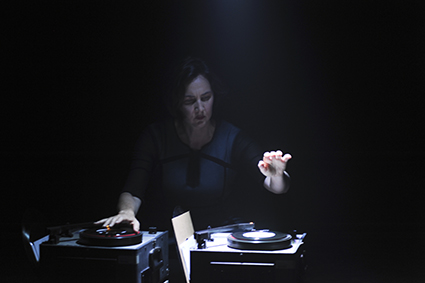
Tamara Saulwick, Endings (2015)
photo Heidrun Löhr
Tamara Saulwick, Endings (2015)
The more I converse with Tamara Saulwick about her work, the more we seem to be exploring sinuous lines of content mapped onto an unchanging axis of form—wavering through a variety of ‘threshold spaces’ that remain firmly fastened to her abiding concern with the mediatised body.
From her first major independent piece, Pin Drop (RT99, p43; RT111, p40), through an audio walk, Seddon Archives, to PUBLIC’s re-imagining of the Highpoint shopping centre food court (RT119, p42), and most recently, Endings (RT125, p15), Saulwick’s work moves across borders between fleshy and technical, intimate and public, interior and exterior: highlighting edges and end-points that are ultimately framed in terms not of opposition, but connection.
Before turning our attention to the works, though, we check voice recorder levels and glance back at Saulwick’s early career, grounded in studies at both Victoria College—and the John Bolton Theatre School. Collaboration was crucial to her training, Saulwick says, and at both institutions she worked with groups of women:
“When I first saw My Darling Patricia it reminded me of us—women who were interested in multiple disciplines because we’d been trained in multiple disciplines, and in [exploring] those languages together. Both of those training institutions were really about devising, and devising is essentially a collaborative activity.”
After many years working on independent collaborations and with companies including Born in a Taxi and Not Yet It’s Difficult, a VCA Master’s degree in animateuring allowed Saulwick to explore “what I would make if I wasn’t working in a cooperative or a company.” The resulting performance, Map Folding for Beginners, was her first solo exploration of the interplay between live and mediated body and voice:
“I was working with a lot of video, but I was also working with sound…there were multiples of me—these video and audio versions of me—and I became interested in how they could start to inhabit the space together.”
With Pin Drop Saulwick moved away from herself as subject, focusing on real-life stories of fear, and weaving 11 recorded voices with her own verbatim retelling and splintering of narratives. Technically and dramaturgically precise—Saulwick tells me it was timed to the second—Pin Drop was “the first time I decided to take a clear theme and work with it…and do the thing that I love doing, which is about how to refract that and bust it up through the way the themes are rendered formally.” All of the voices in Pin Drop were female—a creative decision that helped focus the work, rather than a feminist choice.
“I subsequently thought I could make a Pin Drop 2 with male voices; that would be really interesting as a companion piece, because I think those issues are as relevant to men, but the threat resides in a slightly different psychological space.”
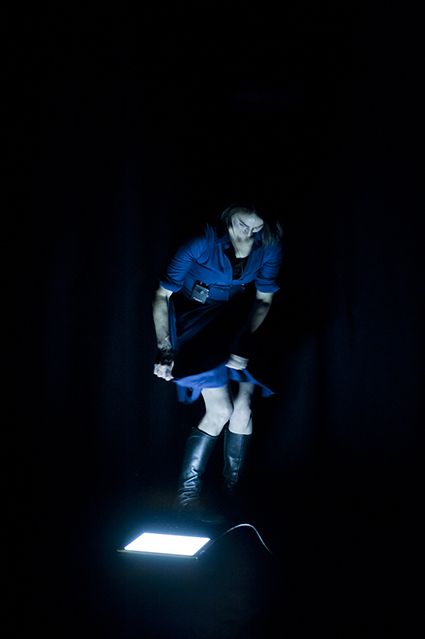
Tamara Saulwick, Pin Drop
photo Patrick Rodriguez
Tamara Saulwick, Pin Drop
We move from Pin Drop to Seddon Archives: Saulwick explains how her interest in human/media interaction continued in that work, even as the thematic trajectory shifted from interior/personal to social/outward. An audio walk for one, Seddon Archives took participants around suburban streets, listening to local stories while also encountering a blend of “the real and the not real.”
“We intentionally used the kind of headphones that allow quite a lot of sound to bleed in, so there was this constant slippage in what you were hearing…the pre-recorded and the live can bounce up against one another and enliven each other in that place of slippage. All the incidental things are potentially sitting within the artistic frame, so people start to read things into it. They would say things like, ‘How did you get those people doing all that stuff with bubbles at that time?’”
The impact of such random moments reached a peak, for me, with PUBLIC, in which the real-live food court setting bled continuously, and magically, into a scripted performance by four actors. Saulwick consciously utilised this capacity of the space to contribute to the work—she calls it “planning for serendipity.” “There are things that you know could possibly happen, because the work has grown out of that site—but it’s also the beautiful power of audiences…the connections are happening in them, in their imaginations. They’re constructing it.”
PUBLIC also crafted a heightened awareness of the environment; Saulwick elaborates on how she views technology’s potential in this regard:
“Sometimes technologies can be seen as alienating devices, and headphones as antisocial, separating us from the world; but technology can facilitate or mediate experiences of people becoming really present and connected to the moment and the place they find themselves in, and the people in that place.”
Through all these works, collaboration has remained key to Saulwick’s process: she stresses the need to acknowledge creative contributors including Peter Knight, Ben Cobham, Luke Smiles and others. “Light and sound are really deeply embedded into the construction of each work—so those collaborators are really involved in building things with me from the ground up.”
One of the things we grapple with in our conversation is the notion of Women+Performance: I feel keenly that female creators (or women in any field) walk a fine line in discussing their work from a feminist standpoint, always risking the shift in focus from their achievements to their status as women, or their politics. For Saulwick, addressing gender or feminist themes directly has not been a driver of her work, but in a sense “managing to keep making work as an independent artist, as a woman, leading my own projects—is a positive thing to put out there… I certainly know that I’ve always looked to the small handful of women who manage to continue to do that.”
If anything, the position of outsider, as an independent artist, is one that Saulwick identifies with more strongly. I hear echoes of Kate Davis and Emma Valente’s comments (Women+Performance 4: The Rabble; RT117, p28), when she points out that “as an outsider you can make whatever you want really, no one cares what you do. If they think it’s good then you’re given the opportunity to show it to some people, and that leads to other opportunities and conversations, and then you come into those on your own terms.”
With Saulwick’s latest work, Endings, the winding through-line from Pin Drop’s personal focus to PUBLIC’s outward gaze turns back towards intimate space, skirting the most unknowable of thresholds: that between life and death. “Even more of a sound piece than Pin Drop,” Endings explores death and the notion of the afterlife in a performance built around recorded voices and Saulwick’s own reflections and questionings. It is dependent on a cast of ageing analogue devices: record players and reel-to-reel tape machines. “It’s a bit like a calling to the dead, really, and so it resonates with all the metaphors that sound evokes, of transmission and signals and antennae and reception and decay.”
We bring our conversation to a close with Endings. I am yet to see it, but sense it as an accumulation of Saulwick’s interest in humans and our technological mediators, brought to the brink in more ways than one.
“I think the thing that became of interest to me is the way that this extraordinarily pragmatic and physical world of bodies and life support and sinews and lungs pushes up against these bizarre poetic or mystical or spiritual spaces around that time [of death]. And in terms of a theme in my work, it’s about connection, and so it’s conjuring it through these redundant technologies that are all kind of wheezing their way. You know, they’re all on the verge of death, the tape machines and the record players we use. Every night it’s like, ‘Will they turn on?’, ‘Will the tape just get chewed up?’ it’s very unnerving, but it feels like it’s so resonant with the material itself.”
Tamara Saulwick, Endings, Arts House, Melbourne, 13–17 May
RealTime issue #126 April-May 2015 pg. 31
© Urszula Dawkins; for permission to reproduce apply to realtime@realtimearts.net
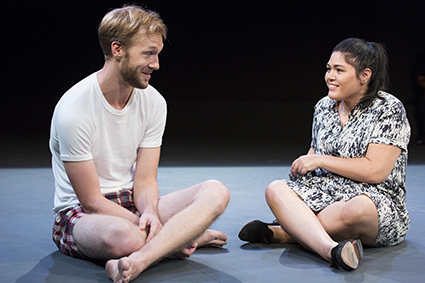
Sam O’Sullivan, Nakkiah Lui, Kill the Messenger
photo Brett Boardman
Sam O’Sullivan, Nakkiah Lui, Kill the Messenger
From the 90s on we rejoiced in remarkable solo stage performances by Aboriginal women—Ningali Lawford (Ningali, co-writers Angela Chaplin, Robyn Archer;1994); Leah Purcell (Box the Pony, co-writer Scott Rankin,1997); Deborah Cheetham (White Baptist Abba Fan, 1997); and Tammy Anderson (I Don’t Wanna Play House, 2001). These works variously recounted tales of dispossession, prejudice, the Stolen Generation, personal trauma and prejudice against which they struggled for personal and collective freedom and the realisation of their ambitions—which these performances in part represented as well as confirming a proud sense of cultural heritage. Their sense of hope was strong. For a writer from a new generation, hope is beset by despair.
Nakkiah Lui, Kill the Messenger
Black walls, black floor, the ultimate black box—a void into which is cast a square of light for solo declarations and combative interactions. This is Indigenous playwright Nakkiah Lui’s Kill the Messenger. It’s short, spare and terse, angry, confessional and funny. It’s self-deprecating. It laughs with and at its primarily white audience. But it’s not hopeful.
In Kill the Messenger, Lui has combined the autobiographical directness of her precursors (not to tell a life story, but a fragment) with vigorous playwriting. She speaks to us directly in monologue and appears as herself, a character in her own play interacting with invented characters in a scenario which speculates about what might have lead to the death of a young Aboriginal drug addict.
Kill the Messenger’s central conceit is that the play is unfinished, because, says Lui, she doesn’t know what it says or if anything can be said in the face of the continuing horrors dealt Indigenous people by Australian society. She struggles with the writing of the play, refusing to allow her characters (an addict, his sister and a white male nurse) much in the way of hope despite the urging of another character, Lui’s onstage white boyfriend.
Directly addressing the audience Lui explains she was motivated to write by hearing that the addict, in severe pain, suicided after being neglected by a hospital that hadn’t detected his advanced cancer. More significant was the death of Lui’s grandmother, who too suffered greatly after falling through a termite-damaged floor, the result of Aboriginal Housing Office maladministration. Lui traces her grandmother’s fate back through a cruel series of dispossessions to the arrival of the First Fleet: “We are always stuck with the mistakes of the past … there is no escaping history and the ways it affects you.” The mistreatment of Aboriginal people is unfinished business, so therefore is the play.
Lui concludes the first of her two monologues by referring to an earlier scene during which she and her lover, amid lovemaking, fractiously sort out their sexual politics while she ignores repeated phone calls. She confides to us, “Maybe I missed my chance to say goodbye [to my grandmother]. I didn’t want to tell you I did that.” She admits to not having the courage to dramatise the grandmother’s life. Instead she creates a series of tense scenes between sister and brother, sister and nurse, brother and Lui (imagining herself meeting him), and Lui and lover.
Although much of the anger of the play is directed at white society, its power resides in the constantly shifting moral ground of the dialogues. Arguments rarely resolve, although the ongoing one between the nurse and the sister comes closest when he faces her with the sheer complexity of the circumstances of her brother’s death. There are further complexities, like the agony felt by the addict at the prospect of having to die in Lui’s scenario.
At the play’s end, we don’t kill the messenger; we know, as she tells us, “…I’m not just the messenger, this is me.” She is the substance of the message. “I wrote this for you…You wanted this. You paid for this. And I’m giving it to you. Now, please. Take it.”
For all the verve of the writing, the excellence of the performances and the clever weaving of self and fiction, Kill the Messenger felt like a play in its early days. It’s not that it’s ‘unfinished.’ It can stand as a work about unfinished business in a form that resonates with its content. What felt unexplored was the nature and the depth of the anger expressed by the sister, Harley (Katie Beckett), and Nakkiah. Beckett and Lui unleash it with an eloquence and power with which their characters frequently block their capacity to listen. Their anger is justified, if sometimes distorting, sometimes briefly quelled, but wielded caustically or with a blunt logic leaving relationships incomplete and creating potentially tragic impasses.
Sadly, the tales of the addict and the grandmother are further tragedies to add to a too long list. For the playwright to step into the picture—“all I have is the truth and this is the most I can give you”—is compelling, but is it enough? We can empathise with loss, but how do we comprehend, and accept, anger directed at us—in our minds as if at some other whites, outside the theatre? Lui says, for having to offer the truth, “I hate you all a little bit for it. That it would come to this.” But she is gentle with us, her confidants, asking us to accept her gift of the truth. Kill the Messenger suggests that, given Nakkiah Lui’s obvious talent, there is some larger dimension or some other play in her that might address the workings of this anger and have us face it fair and square.
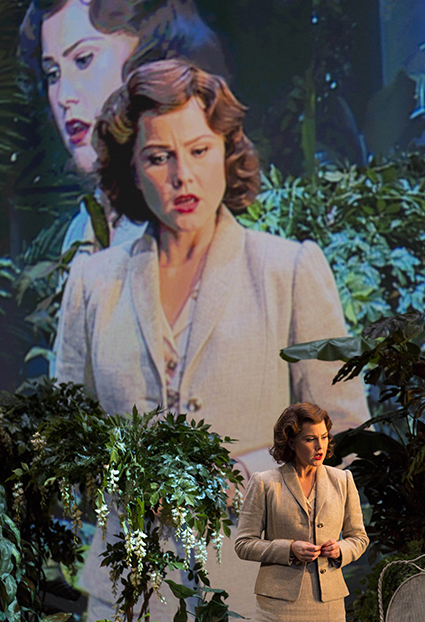
Eryn Jean Norvill, Suddenly Last Summer, Sydney Theatre Company
photo Brett Boardman
Eryn Jean Norvill, Suddenly Last Summer, Sydney Theatre Company
Tennessee Williams, Suddenly Last Summer
The Drama Theatre proscenium is a vast white screen. A man crosses the forestage and enters it via a hidden door. We glimpse greenery. The screen fills with images of lush plants in immersive high definition filmed by a camera coursing through a garden. For half an hour or so we only see the actors writ large onscreen—pure cinema, if provisionally so. The stage revolves taking us from garden to asylum, the screen rising up behind the now human-scale actors, capturing them in close-ups, intimate pairs (seated in the wings amid theatre machinery), wider shots and heady circlings provided by three cameras and some astute live editing. Images of the tormented Catharine (Eryn Jean Norvill), institutionalised by her aunt, Mrs Venables (Robyn Nevin) for defaming her dead son, are hugely multiplied amplifying a sense of delirium. The inventiveness persists throughout the production although introducing the son on stage in flashback involves awkward doubling and, with an overheated ramping up of effects, reducing the sheer chill of the final revelation.
The mix of stage and screen presences, physically and vocally, in Kip Williams’ finely realised production of Tennessee Williams’ 1958, 90-minute one-act play, is carefully balanced, the actors making the most of the head-miking and camera opportunities for highly nuanced performances. Nevin’s Mrs Venables, living off vanity and denial, simmers with righteous anger. Norville’s delicate, tremulous Catherine reveals, in a performance of great range, just enough strength to suggest she’s a survivor.
Kip Williams overcomes the challenges of Suddenly Last Summer’s calculatedness, surprising us with a fine melding of intense cinematic realism, equally cinematic surrealism and distanciation provided by visible production technology, and actors on a stage.
Belvoir, Kill the Messenger, writer Nakkiah Lui, director Anthea Williams, Belvoir Upstairs, Sydney, 18 Feb-8 March; STC, Suddenly Last Summer, writer Tennessee Williams, director Kip Williams, Drama Theatre, Sydney Opera House, 13 Feb-21 March
RealTime issue #126 April-May 2015 pg. 32
© Keith Gallasch; for permission to reproduce apply to realtime@realtimearts.net
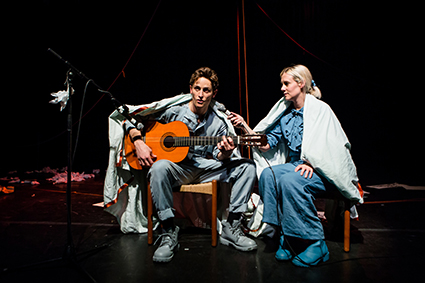
Tim Grayburn, Bryony Kimmings, Fake it ‘til you Make it, Theatreworks
photo Richard Davenport
Tim Grayburn, Bryony Kimmings, Fake it ‘til you Make it, Theatreworks
Much ink has been spilled lamenting the rise of the memoir in contemporary publishing, and while it’s debatable whether this turn reflects a culture of narcissism that interprets all experience by turning inwards, it seems without doubt most examples subscribe to a rather conservative notion of the self. The nature of identity and the individual are rarely problematised by writing that reproduces a particular narrow mode of realism and whose only formal playfulness might at best be some concession to the fallibility of memory. Perhaps I shouldn’t have been so surprised, then, when three recent theatre productions in Melbourne all turned out to possess elements of autobiography; however, it was thoroughly heartening to see that each took a rigorous and critical stance towards the performance of the self.
Fake It ‘Til you Make It
Bryony Kimmings and Tim Grayburn’s Fake It ‘Til You Make It might be the most naïve of these on the surface, but that simplicity has a function that is subtler than it appears. The work is a collaboration between performer Kimmings and her real life partner Grayburn, who has never appeared on a stage before. It takes as its subject his long-term experiences with depression and anxiety and Kimmings’ discovery of this well into their relationship. Structured around a series of discussions the pair recorded in their living room, it is composed of vignettes that spin off these conversations and explore the signs and symptoms of mental illness, its stigmatisation in public discourse and the models of masculinity that encourage a young man such as Grayburn to keep secret such a debilitating illness. The sequences incorporate dance, song, shadow-play and comedy in routines that are sometimes accomplished and sometimes lovably awkward; Grayburn spends almost the duration in a succession of headpieces sharply designed to shield the gaze of the audience from his, again reminding us of his nervous status as an artist.
There’s a contradiction at the heart of the work: performing a particular role of masculinity that denies vulnerability—the ‘faking it’ of the title—is precisely the problem at stake, and so producing a performance that addresses such a problem might only compound things. In order not to fake it, Kimmings and Grayburn must offer some alternative that can claim some authenticity, but what would that look like?
The duo make clear early on that this is foremost a love story, and Fake It is certainly not a comprehensive investigation of mental illness. It’s a portrait of a relationship, but it also becomes a part of that relationship, and through this the work manages to avoid that binary of artifice versus artlessness which a work about a ‘real’ issue might find itself in. The live-ness of Fake It is where we see the clear-eyed affection the two performers hold for one another, the fierceness of Kimmings’ need to wrestle social demons and Grayburn’s willingness to put himself in the dangerous spotlight so that others might find something of their own experience illuminated there.
It’s not as tightly constructed as some of Kimmings’ earlier work, and there’s a certain flatness to some scenes that is put in relief when more arresting moments arise—Grayburn’s thoughts of suicide when passing a favourite tree, or Kimmings’ panic when he lingers too long near an open window. But this contrast itself, whether intentional or not, has its own air of honesty. Any relationship moves through such phase shifts, and if Fake It doesn’t encompass the spectrum of male mental health it at least reminds us of the third voice that can be produced when two perform in harmony.
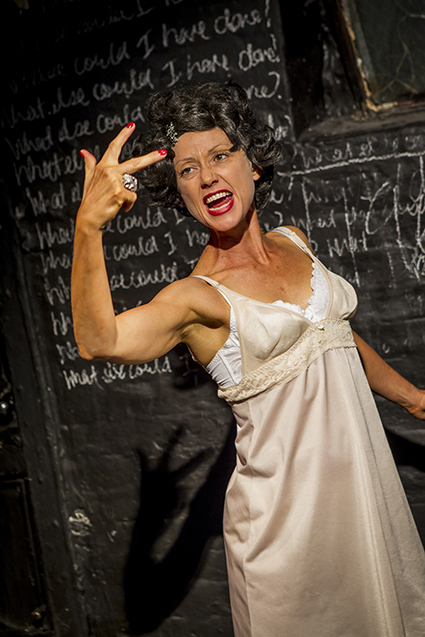
Suzie Hardgrave, Elizabeth Taylor is my Mother
photo Sav Schulman
Suzie Hardgrave, Elizabeth Taylor is my Mother
Elizabeth Taylor is my Mother
Suzie Hardgrave’s Elizabeth Taylor is my Mother approaches lived experience from more oblique angles. This solo work has been developed as part of Hardgrave’s Masters degree on authenticity in acting, but authenticity is not synonymous with sincerity. It’s a playful and ironic piece that interweaves fantasy and reality to such a fine degree that neither is really distinguishable; in her notes, Hardgrave describes research into psycho-physical theatre practices as they relate to “the personal and the ‘pretend’,” and the way that the self is produced through a mediation of these is where the production proves most compelling.
Hardgrave plays Cleopatra Velvet Rosemond Taylor-Burton, a figure who has clearly threaded together an elaborate private mythos in which Elizabeth Taylor gave her up for adoption in 1974, leaving her in the arms of an addict mother and abusive father. Hardgrave’s own experiences with adoption have played some part in the work’s formation, but are never given the position of privilege typically accorded the real. The narrating voice here is forever shifting register, from compulsive wit to a terrified reliving of trauma to sardonic speculation on what any of this really reveals. This isn’t a mystery of identity—’who is really speaking?’—so much as a rumination on the different scripts we use to write the self.
The Blueform
James Pratt’s The Blueform is an even denser layering of different modes of signification. Its ostensible story is familiar enough—a hapless schlub works in a Kafkaesque office from which there is no escape until he accidentally comes into possession of a blue form that can allow him access to prohibited areas, a glimpse into the dark machinations behind the totalitarian bureaucracy and, perhaps, even a window into another reality.
All of this could be just another rerun of the Orwellian dystopia that has played out in fiction ad nauseam, but Pratt’s facility as a comic and physical performer consistently undercuts the narrative to remind his audience of the blatant silliness of his premise. He’s an accomplished mime but there are sequences here that verge on meta-mime as characters undo one another’s actions by pointing out their artificiality. Pratt engages audience members directly and discusses how the show could proceed differently, and even brings the lights up for a false interval.
Somewhere in here, however, snatches of something that may be autobiographical emerge—moments in which a boy urged to try impro wins laughs from his schoolmates, or stages The Mikado with a young friend. These recollections are made misty by the surrounding frame of self-reflexivity, equally unreal but carrying with them the weight of a melancholy only time and age can bestow. Where Pratt’s hilariously unpredictable stagecraft works in opposition to the apparent confines his central character is supposed to be stifled by, the real tyranny might turn out to be the way that all life, all experience, sooner or later takes on the immateriality of fiction.
Fake It ‘Til You Make It, Bryony Kimmings, Tim Grayburn, director Bryony Kimmings, Theatre Works, 18 March–5 April; Elizabeth Taylor is my Mother, writer, director, performer Suzie Hardgrave, La Mama Theatre, March 18-29; The Blueform, writer, director, performer James Pratt, La Mama Theatre, Melbourne, 19-29 March
RealTime issue #126 April-May 2015 pg. 36
© John Bailey; for permission to reproduce apply to realtime@realtimearts.net
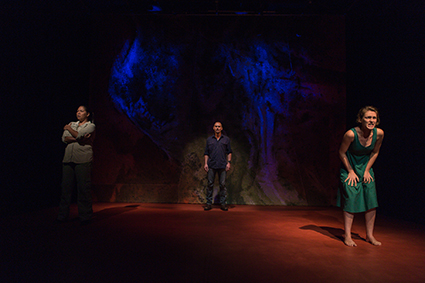
Broken, Brown’s Mart
photo Glenn Campbell
Broken, Brown’s Mart
Broken is poetic storytelling that evokes the innermost experience of falling in and out of love and the attendant hope and despair of three lives in collision. Well-structured, it moves fluidly between individual perspectives with language rich in imagery.
Three separately toplit actors on an empty stage, disconnected from each other, speak sparse, fragmented thoughts. The precipitating event is a car crash on a remote desert road. The driver Ash (Rosealee Pearson) repeatedly describes the crash roll—side, roof, other side, roof, other side—swaying gently, echoing the rolling of the car. The action switches between characters, moving to a young woman, Mia (Ciella Williams), who details acute physical pain. Initially we think she is in the crashed car but it becomes clear as the play progresses that she is alone at home, waiting for her lover and birthing her baby, tragically too soon.
Linking the two women is Ham (Matt Edgerton) who discovers the accident and goes to help. The helper and injured woman become emotionally embroiled; their path appears set. Night falls around the new lovers as they wait for paramedics to arrive and the action switches to Mia giving birth to her dead baby and still waiting for her husband—Ham.
Broken’s intricate structure engages the audience by gradually revealing moments from different time and spatial zones that, once linked, unfold the characters’ histories, their dilemmas and possible choices. Writer Mary Anne Butler further enriches the structure with repeated scenes. With each repetition choices are both clarified and become exponentially tortuous. The stakes are high, the writing heightened as the two stories are revealed simultaneously.
Balancing the intensity of language and story is the restrained, un-cluttered direction by Gail Evans. Shifting from motionless characters voicing their thoughts to the minimally interactive dialogue scenes, Evans employs a withheld physicality that suggests rather than depicts. The scenes of the couples falling in love and having sex are compelling because they refrain from awkward grappling and go instead for clean choreography that plays with light touch and no touch. Similarly, Ham giving Ash the kiss of life is deftly choreographed; watching over him as he tries hard to save her, she describes her slow move towards death.
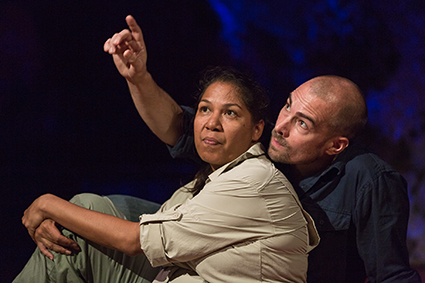
Broken, Brown’s Mart
photo Glenn Campbell
Broken, Brown’s Mart
Characters voice their perceptions of themselves, the others and the situation. These are often lightly humorous, indicating in a wry, ironic tone how people see one another. Mia is quietly impressed when she first meets Ham, noting to herself that, in this remote two-weeks-on-one-week-off mining environment, he knows what ‘panini’ is. Elsewhere Ash fights hard to keep her boots when Ham needs to cut one off to save her foot. “They’re my Docs!” she shouts before telling her rescuer to “fuck off.” Towards the end, as Ash tries to find Ham after several months, she waits outside Coles in Alice Springs hoping he’ll appear. “Nothing.” So then she waits “outside Woolworths for a week and finally sees him.” Anyone from a regional or remote area can recognise the inevitability of finding someone in a small town by staking out the two supermarket giants.
The setting of the play, the vast Australian desert, is beautifully realised by Kris Bird’s simple set of reddened floor cloth and painted hanging backdrop that dominates the space. It’s a commanding art piece in itself, boldly abstract, textured, dynamic and expressively lit by Sean Pardy, transforming it from moody to gentle, dangerous to soft, day to night and reflecting the action and the actors’ conjuring of the landscape. Angus Robson’s sound design echoes the writing as he creates another layer of poetic minimalism—soft curlew cries, ambient and suspenseful undertones and intense silences.
With its deliberate disconnection between actors and characters and lack of immediate action, Broken is initially challenging, but once the first moments of connection between stories and characters are made and the actors find their rhythm the production begins its compelling roller coaster ride to a whodunit-style revelation. Broken is a powerfully immersive production which deserves to be seen nationally.
Knock-em-Down Theatre & Brown’s Mart Productions, Broken, writer Mary Anne Butler, dramaturg Chris Mead, director Gail Evans, performers Matt Edgerton, Rosealee Pearson, Ciella Williams, set Kris Bird, lighting Sean Pardy, sound design Angus Robson, Brown Mart Theatre, Darwin, 17-29 March
RealTime issue #126 April-May 2015 pg. 38
© Nicola Fearn; for permission to reproduce apply to realtime@realtimearts.net
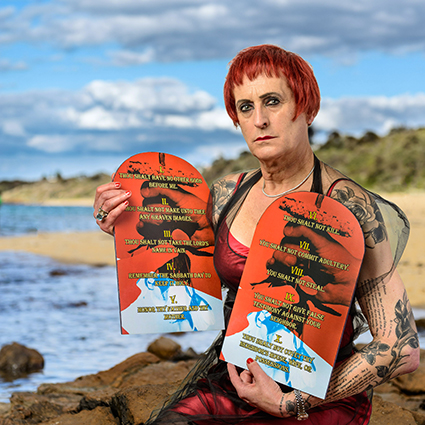
Kylie Supski, 10CS, Metanoia Festival
photo Deryk McAlpin
Kylie Supski, 10CS, Metanoia Festival
Last year, the Mechanics Institute in Melbourne’s Brunswick became a contemporary art space—home to Metanoia Theatre which also manages and programs the venue. Gorkem Acaroglu tells RealTime, “We’re a core team of three artists (Gorkem, Greg Ulfan, Shane Grant) along with associated artists who came together around June 2013 with the opportunity of working as programming managers of the council-owned Mechanics Institute.
“The council wanted a real contemporary arts space and we won the tender. It had been operating as a community arts centre and hall for hire for about 30 years. It has a retractable raked seating bank for an audience of 100, full lighting rig and two other spaces we’ve put to use. We’ve also refurbished it so it’s got a great contemporary vibe. It’s all about providing space for independent and interdisciplinary artists to create work. We hold dinners for artists to consult with us about the program.” Metanoia are eager for work that is “form-bending and immersive.” An expression of interest is put out twice a year and applicants are assessed “in terms of their art,” not funding they may or may not have.
Performing two to three times a year, Metanoia will complete the first Live Works Program with its own 10CS, an immersive work about the Ten Commandments that will occupy every space in the building and close the season. “Ten artists are each working on a commandment in a designated space. The audience will go on a self-directed journey through a variety of styles and forms—sound-based, one-on-one etc—inclusive of ethnicities and genders. Acaroglu says her experience as Executive Creative Director of The 24 Hour Experience (“24 live works on the hour, every hour, over 24 hours”) in 2014’s Festival of Live Art (FOLA) has prepared her well for shaping the audience’s experience of 10CS.
The Live Works Program opens with Hallie Shellam’s Is This Somewhere You’ve Been Before?, a one-on-one performance taking “each audience member on a sensory journey to remember an event that never happened” (press release). MKA: Theatre of New Writing will follow with EXPEN$$$IVE, “an experimental live art project” in which a fictional video clip is made with the audience on hand and a faux Q&A.
Third in the season is another work utilising the whole building, In the Dark, by writer Georgia Symons, director Iris Gallard and collaborators. Symons tells RealTime it’s a work about faith and belief. “The project started for me when I noticed people who consider themselves quite open-minded and liberal about race, gender and culture giving themselves a free pass to criticise and mock people of religious faith.” Inspired by a Sunday school game from her childhood involving a maze and the solving of a mystery, Symons decided to invent her own interactive game, “but with no fixed ending, embracing complexity and allowing for multiple truths to co-exist. The audience decide where their beliefs lie.” Although the name of the founder of In the Dark’s belief system is named Poseidon Maelstrom and his role is in part based on tele-evangelists, Symons is adamant that the work is not a parody. Maelstrom is awed by the magnificent colours and complexity of the remarkable mantis shrimp, seeing its beauty as redemptive. Video of him preaching will be released in the month leading up to the performance and the audience will be able to test the validity of his beliefs as they enter the work, guided by the leaders of the master’s fellowship. Symons doesn’t expect anyone “to have a crisis of faith during the show or to be indoctrinated; they will test ideas and beliefs in a playful way.” The cast are being trained by Gallard to accommodate “many different outcomes and ones unforeseen.”
With a background in media arts production and an MA from the VCA in Writing for Performance in any medium, Georgia Symons has created the live interactive game design for In the Dark and sees her future in making “responsive story environments.” 10CS and In the Dark look set to expand the possibilities of the immersive performance. It’s fascinating that both productions address matters of faith, if from very different angles, as has David Williams in Quiet Faith (RT124, p47) which premiered at Adelaide’s Vitalstatistix last year and will be seen at Albury-Wodonga’s HotHouse Theatre in October. Sign of the times? RT
www.metanoiatheatre.com
EOIs open for July-December Live Work Program, metanoiatheatre.com/eoi
Metanoia 2015, Live Works Program, Mechanics Institute, Brunswick, Melbourne, 28 April-27 June
RealTime issue #126 April-May 2015 pg. 38
© RT ; for permission to reproduce apply to realtime@realtimearts.net
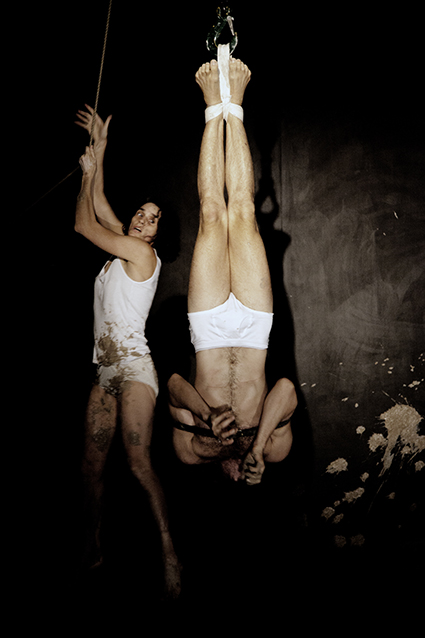
acrobat, It’s not for everyone, Hothouse Theatre
photo Karen Donnelly
acrobat, It’s not for everyone, Hothouse Theatre
Jo Lancaster carries Simon Yates around the stage on her shoulders while somehow simultaneously dressing him in a suit. She then deposits him atop a podium. Before speaking he looks at her askance then says, equally dismissive and disgusted, “God, you’ve really let yourself go.” This is acrobat at its best, where feats of remarkable, almost impossible physicality combine with minimal dialogue to shine a small beam of truth onto the dark side of the status quo.
Lancaster and Yates are acrobat, who have performed their raw, idiosyncratic take on physical theatre around the world for 20 years. The title of the show, It’s Not for Everyone, reflects their unapologetic honesty and gritty approach to theatre. They reject outright the notion of providing passive entertainment and instead want their audience to be “sucked into their universe and spat out the other side.” It’s quite a ride through this highly expressionistic, at times Dada-esque, exploration of gender, identity and ageing.
The show opens with an outlandish clowning sequence where Yates and Lancaster do the most extraordinary things on a humble bicycle. We glimpse their intense acrobatic skill and gnarly discipline, but from here on there’s a gradual shedding of all things circus as the performers, and their performance, are gradually stripped back. There’s the rather bleak experience of watching Yates hoist a lifeless Lancaster upwards by an arm, a leg and then by her neck beneath a single bulb of light. There is a clever, rapid-fire sequence where Lancaster presents ‘this is me’ aspects of herself with props and actions frozen in flashes of light, like a series of photographs illuminating her multifaceted life. Mud is flung and smeared. The performers run in muddy circles slipping hard on the stage again and again, an exhausting metaphor of failing, skilfully executed. A finely choreographed tangling of bodies follows, complex yet deeply primal, completing the final erosion of superficial clowns into the earth itself. The show is both bold and abstract with a collection of powerful messages delivered in this patchwork-style.
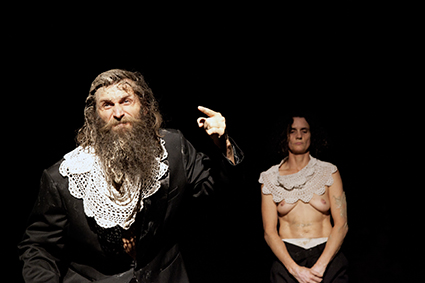
acrobat, It’s not for everyone, Hothouse Theatre
photo Karen Donnelly
acrobat, It’s not for everyone, Hothouse Theatre
In the traditional circus journey, old acrobats become clowns. Yates and Lancaster, now 42 and 48 respectively, are navigating a new trajectory from highly acrobatic performers to middle-aged performance artists. This show was particularly devised not to rely on impressive acrobatic feats alone (Yates has been recovering from a back injury) but rather to bring other theatrical and musical skills, previously used in secondary roles, into focus. The set design is very much in keeping with their anti-aesthetic approach, with a single strand of coloured light bulbs forming a pyramid. The quirky sound works (composed by Tim Barrass) include everything from zany circus music to chickens clucking and a beautifully crisp Australian bush soundscape in the closing scene.
Watching scenes of fiercely original, unpredictably abstract theatre, an Oscar Wilde aphorism came to mind: “A true artist takes no notice whatever of the public. The public to him are non-existent.” From the cartoonish opening through to primal mud wrestling, Yates and Lancaster are staunchly true to their anti-cliché selves. Expressionistic, narrative-free theatre runs the risk of being more confusing than coherent, but as acrobat themselves clearly warn right from the outset, brazen physical theatre is not for everyone.
——
You can also read our interview with Jo Lancaster from RT Profiler 9.
acrobat and Marguerite Pepper Productions, It’s Not For Everyone, devisors, performers, Jo Lancaster, Simon Yates, composer, sound designer Tim Barrass, HotHouse, Butter Factory Theatre, Albury, 19-29 March
RealTime issue #126 April-May 2015 pg. 39
© Kate Rotherham; for permission to reproduce apply to realtime@realtimearts.net
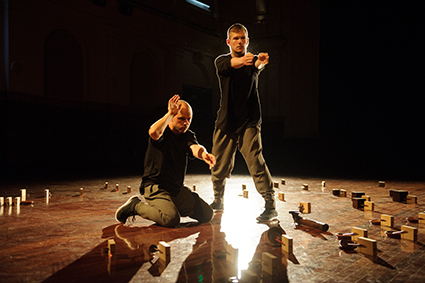
Antony Hamilton, Alisdair Macindoe, Meeting, Dance Massive
photo Sarah Walker
Antony Hamilton, Alisdair Macindoe, Meeting, Dance Massive
The fourth incarnation of Dance Massive felt stronger than ever, with sold-out houses across the city, a highly organised approach to bring international presenters to showcase all of the works and a significant increase in the non-specialised audience. It is still one of the best-defined and most pragmatically useful festivals in the country—it gives visibility to an often neglected form, showcases the best-of to both the dance community and the general public, and brings the industry together.
One only hopes that the merit of this format will be recognised, because Dance Massive still functions in a slightly renegade way, as a joint programming effort by three Melbourne performance spaces. As such, it is less of a showcase of Australian dance, than dance in Melbourne, with its particular idiosyncrasies.
Without a strong curatorial statement, it is hard to know if an outsider understood that they were hopping between local ‘dance families’ as they were hopping between shows. To someone who has been following dance in Melbourne, the vast distances in interest, aesthetics and process were clearly visible. Whether they serve to contextualise each other’s work, or pass one another like ships in the night, was harder to see.
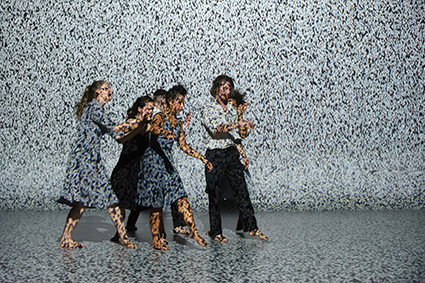
Stephanie Lake, Briarna Longville, Alisdair Macindoe, Jessie Oshodi, Kyle Page and Lilian Steiner, Motion Picture, Dance Massive
photo Sarah Walker
Stephanie Lake, Briarna Longville, Alisdair Macindoe, Jessie Oshodi, Kyle Page and Lilian Steiner, Motion Picture, Dance Massive
Lucy Guerin Inc, Motion Picture
Lucy Guerin’s Motion Picture presented another excursion in strongly verbal performance after the lauded Conversation Piece (RT 111, p37, 2012; Dance Massive, 2013). The film noir D.O.A. (Rudolph Maté, 1950) is used as the external framework both for the structure of the piece and for generating movement. It starts with dancers miming the film’s gestures, synced to the dialogue, and then progressing into ever greater abstraction. The entire film, with which the dance performance is in perfect sync, is played on the screen right behind the audience—this is a very clever set-up, allowing us to selectively observe the source and the homage.
Like a number of Guerin’s recent works, Motion Picture is structured as a list of variations on a theme. The variations develop in complexity, but never break from the list, which means that the work never amounts to a strong statement, just a series of smaller ones. I found the most interesting to be the early scenes, which expose the rhythms, the gestural vocabulary, and the gender stereotypes of film noir in a Brechtian stroke—it seemed like a more entertaining and substantial version of Rosas’ Golden Hours (RT125, p31). However, there are not enough formal ideas in Motion Picture to fill the 89 minutes of D.O.A. and attention falters.
Antony Hamilton, MEETING
Antony Hamilton also works with the list structure in MEETING, a work for two male dancers and 64 metronome-like, pre-programmed robot percussionists. However, MEETING is conceptualised formally, not thematically, around the interaction of duet dancing and random percussion patterns, and digs deeply into the possibilities of this set-up. The piece progresses from the simple choreography of one movement at a time (Hamilton and Alistair Macindoe moving in astoundingly quick, zig-zaggy turns) to a single irregular beat, to include upper body, whole body, feet and voice. The percussion patterns grow in complexity, the neat circle of robots is rearranged to interact with various random objects—wooden blocks, floor, tiny cymbals. Even though the piece develops predictably to finish with the robots taking over and the dancers gone, the movement itself is so precise, irregularly paced and randomly organised, that watching it is never less than mesmerising.
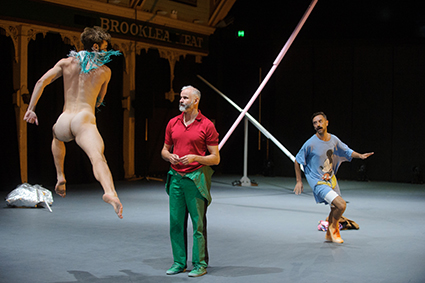
Kingdom, BalletLab, Dance Massive
photo Sarah Walker
Kingdom, BalletLab, Dance Massive
Phillip Adams’ BalletLab, Kingdom
Phillip Adams’ BalletLab is related to Guerin through a shared postmodern sensibility, use of culturally and socially situated objects on stage and a penchant for narrative, but has for years now been moving away from conventional choreography and towards static, highly iconographic movement, and eliciting highly ecstatic states of stage presence. Like recent works (Miracle, 2009; All things return to nature, 2013), Kingdom’s charged delivery seems to imply that the foremost concern is not representation so much as forming a cult. The audience did not enjoy it, but I suspect it may be because of this fundamental misunderstanding. Adams is an extremely cool-headed and intellectual artist, whose thematic interests do include community, passion and indulgence, but who has mercilessly questioned these concepts in his work.
Kingdom is so thick with societal references that it can be read as an essay. It charts the formation of queer male sexual identity from individual to collective, the home-building efforts to organise a community and the transformations that the individual undergoes once he joins the collective. Through extremely evocative imagery, it charts the transformation of a private kingdom of outcasts as its emotional coherence shifts from safety and acceptance into organised narcissism, competition and self-congratulation. It looks at games of favouritism and humiliation, and finally wonders if its orgiastic aspects—which seem to flow from its narcissism, but also from its transgressiveness—are seeds of salvation or doom.
Kingdom is steeped in the gay aesthetic of glitter and gold, but is not at all a trivial piece. There is much here to unpick and enjoy. Adams’ co-performers—Luke George, Matthew Day and Rennie McDougall—are not only queer men, but also promising choreographic minds, each making an intelligent, individual contribution. I was frustrated by the impatience of the Melbourne audience with a work equally rich emotionally and intellectually.
Finally, Atlanta Eke and Tim Darbyshire represent the most substantial of the younger generation of Melbourne choreographers. Atypically, they have not been mentored by the local greats, but have received their first artistic formation in Europe—Eke, notably, with Marten Spangberg. And yet, instead of building overseas careers as performers, they have returned quite young in order to make their first choreographies in Australia. Darbyshire’s More or Less Concrete was highly praised at Dance Massive 2013 (see an interview here) while Eke received good notices for her Monster Body (Next Wave 2012; Dance Massive 2013, RT114).
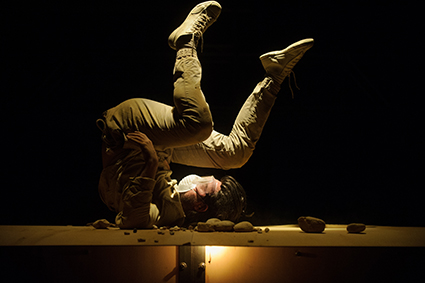
Tim Darbyshire in Stampede the Stampede, Dance Massive at Arts House
photo Sarah Walker
Tim Darbyshire in Stampede the Stampede, Dance Massive at Arts House
Tim Darbyshire, Stampede the Stampede
In Stampede the Stampede, Darbyshire is interested in the sensuous experience of choreography, but choreography understood as including the performer’s body, sound, light and stage objects. It is a visceral piece in three acts. In act one, Darbyshire head-bangs on a high platform to a deep pulsating beat, while a sequence of lights projects his silhouette across two white walls as in stop-animation. In a most impressive act two, Darbyshire performs a headstand on a gravel-covered platform shaken by the thundering of a powerful subwoofer, falling and returning to the headstand until the gravel has completely slid off. In act three, he spins in a harness suspended from the ceiling.
In all three, Darbyshire’s body is trying to weather turbulence like a crash-test dummy, but Stampede the Stampede is not a performance of tortured body, but rather of a multi-material choreography. The point is obviously to create a sensuous stage-scape, provoking a tactile and affective experience—which strikes me as a very Australian approach to performance, but also conceptually flat.
Atlanta Eke, Body of Work
Atlanta Eke’s Body of Work is an extension of the 10-minute solo that won her the inaugural Keir Choreographic Award, and it is quite an exceptional work—probably the finest from what I saw of this Dance Massive. The centrepoint is the use of a camera to multiply Eke’s presence on stage into a series of ever-so-slightly delayed video projections, which appear to be in gentle acknowledgement of each other’s presence. Layering the digital body behind (always behind) the physical, Eke accentuates our perception of stage time (each movement has a fading echo), building poignant harmonies. It is a very clever questioning of oeuvre, legacy, perception, interpretation and that old truism that performance’s only life is in the present.
Dance Massive: Lucy Guerin Inc Motion Picture, concept, direction Lucy Guerin, Arts House, North Melbourne Town Hall, 17-22 March; MEETING, director, choreographer, performer Antony Hamilton, instrument design & construction, composer, performer Alisdair Macindoe, Arts House North Melbourne Town Hall, 10-14 March; Kingdom, concept, curation Phillip Adams BalletLab, Arts House Meat Market, 18-22 March; Stampede the Stampede, choreography, performance, voice, art work Tim Darbyshire, Arts House Meat Market, 18-22 March; Body of Work, concept, choreography Atlanta Eke, video Hana Miller, Jacob Perkins, Dancehouse, Melbourne, 16-18 March
RealTime issue #126 April-May 2015 pg. 23
© Jana Perkovic; for permission to reproduce apply to realtime@realtimearts.net
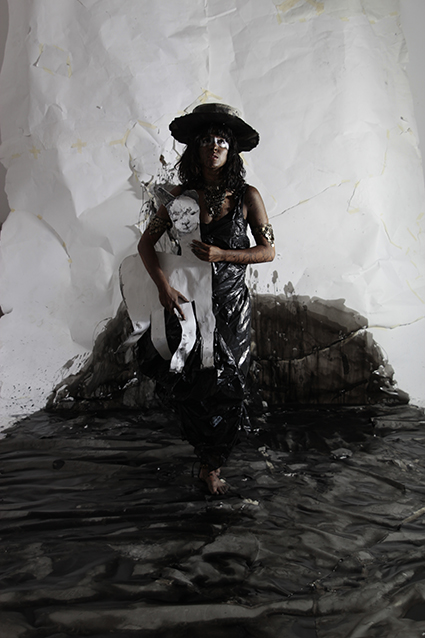
Tina Torabi, From the Rubble, Perth Theatre Company and PICA
photo Fleur Elise Noble
Tina Torabi, From the Rubble, Perth Theatre Company and PICA
From the Rubble is a multi-disciplinary work that coheres around a confronting theme to produce a considered, touching whole. Inspired by stories of Australian journalist Sophie McNeill, director Melissa Cantwell eschews any traditional theatrical narrative arc to piece together a montage performance that echoes the tales and lives “from the rubble” of human conflict. Performers take their places alongside puppets of different scales, video footage, silhouettes and delicate tricks of lighting to portray the fractured nature of existence and memory when personal routines are devastated by warfare.
Mei Saraswati, Tina Torabi and Mikala Westall impress with their ability to convey the reactions of children and young people to the events around them—playing games in the rubbish in the streets while their parents are bombed as they shop. In larger than life projections of the characters being interviewed, the actors deliver compelling thoughts on memory, survival and hope. These interviews feel far too close to home—unmediated by interpreter, subtitles or unfamiliar accents; such a simple shift yields a strong impact.
Puppetry is prominent, the youngsters creating figures from the paper-strewn, derelict landscape—a simple bird, a toy house, a boat with a magical glowing sail or a disconcerting ‘baby’ that becomes a missile. While already impressive, the puppetry combines with video projections created by Fleur Elise Noble to take us further into the horrors of devastation. With projected architectural imagery aligning with paper stage structures to create a multi-dimensional landscape, Noble takes us inside the claustrophobic nightmare experienced by a family group of 52 people who silently hid in a house before fashioning a white flag and walking through the conflict in search of safe haven. She presents us with a silent old woman picking through rubble, finding fragments of images—the faces of loved ones—providing director Cantwell with the means to communicate feelings beyond everyday expression.
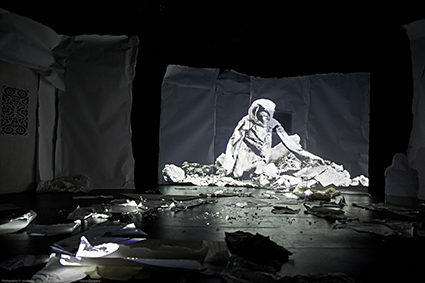
From the Rubble, Perth Theatre Company and PICA
photo Jon Green
From the Rubble, Perth Theatre Company and PICA
A range of musical styles carries some of the more challenging moments. Saraswati’s singing is employed strategically; combined with occasional simple string accompaniment it is heartrending in the sweetest way. Delivering situation updates, the voice of a reporter (Tracey Vo) in the war zone carries weight, the familiar authoritative tone enhancing a sense of verisimilitude. Lighting takes on many tasks, transforming the simple set with use of silhouettes, shadow play and subtler tones in between the many demands for clear video projection.
Suddenly the set partly collapses to reveal a cosy lounge-room with a television set on which the man who took responsibility for his family members and placed his hope in a makeshift white flag, speaks. The shock of seeing an image of the actual person is exacerbated by his fatherly concern for his children’s reactions to losing their home and their hopes for the future. All the technical niceties of this incredible production come back to this sharing of human experience, the shock realisation of the depth of commonality that emerges from the rubble.
Perth Theatre Company with PICA, From the Rubble, concept, director Melissa Cantwell, visual designer Fleur Elise Noble, story inspiration Sophie McNeill, PICA Performance Space, Perth Cultural Centre, Northbridge, 16-28 March
RealTime issue #126 April-May 2015 pg. 40
© Nerida Dickinson; for permission to reproduce apply to realtime@realtimearts.net
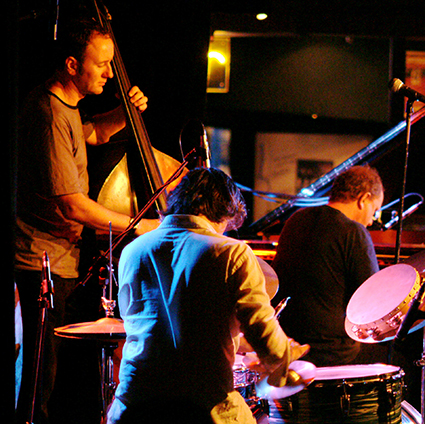
The Necks
photo Tim Williams
The Necks
Describing The Necks as ‘an improvising band’ is plainly accurate, but does not tell the whole story of what this unique trio has developed over their 25-year-plus history. Chris Abrahams (piano), Lloyd Swanton (double bass) and Tony Buck (drums/percussion) have distilled a particular improvisatory practice uniquely their own. The Necks go onstage with no pre-conceived plans, yet the result is instantly recognisable as the music of The Necks. There are no solos per se; they work together as a single unit, serving a music that takes on a life and energy of its own. The compositional choices the trio makes have an aura of inevitability. In the world of The Necks, the will of the individual bows to the requirements of the music.
Playing for the first time in the pristine acoustic environment of the Melbourne Recital Centre, it was obvious to the packed house from the beginning that this was going to be an ideal sonic setting to revel in all the minute musical textures that The Necks conjured into life. For Buck in particular, each muted scrape of a drum skin or cymbal was afforded its own clear place in the hall’s broad acoustic. His textural elements are critical to the band’s studio recordings, but many of his subtler gestures have been lost in the bombastic PAs of venues frequented on previous tours.
The first set was a study of classic ‘Neckisms.’ Abrahams began with lush runs down the grand piano, before settling into a repetitive two-note figure, high on the keyboard and mostly only a semitone apart. The figure rose and fell away again in tempo and intensity, altering ever-so-slightly in each bar. Swanton and Buck followed his lead, adding depth and colour, Swanton alternating between pizzicato and arco, and Buck somehow mirroring Abrahams’ pitch intervals with drum and cymbal. Already they had created a familiar Necks motif of rich, slowly evolving music that had the character of waves washing in and out on the shore.
Each of their hour-long sets featured dark, vaguely discordant middle episodes, whose richness shone again in the hall’s acoustics. Many have written that The Necks sound like more than just three people, and often during these middle parts I wondered where a particular sound was coming from. Inevitably, Buck was the culprit. He is that rare combination of an endlessly inventive musician with an accomplished technique that makes musical imagination a reality. Whether he’s grinding a hand cymbal into his snare drum, rolling bells on the ground underfoot, or creating thunderous exclamations with a handbell on his floor tom, Buck’s contribution to The Necks’ sound world is enormous.
Abrahams often leads The Necks into another mood. This was beautifully demonstrated at the conclusion of the dirge-like middle episode of the second set. We had been revelling for around 10 minutes in the rich subterranean frequencies Swanton and Buck had created when Abrahams shifted from bass notes to a sequence of bright chords at the piano’s high end. Of course, his band mates followed and the ecstasy was palpable in the hall as the music’s mood swung from darkness to joy. Few of Abrahams’ piano phrases are technically complex; like Buck and Swanton, his priorities are texture and mood. His genius is an unfailing awareness of when the change must come, and impeccable timing and poise in making it happen.
American band, Swans, had played the previous month at The Necks’ former Melbourne haunt, the Corner Hotel. Swans ostensibly play ‘songs,’ yet improvisation is a big part of their performances and manifests in not dissimilar ways to The Necks. The songs serve as relatively simple yet elastic structures the musicians use to build almost unbearable tensions that—through repetitive crashing slabs of guitar/bass/drum volume and crescendos that seem to go forever—are rarely resolved. Frontman Michael Gira presides, reading the tension and directing the band appropriately; one part conductor, one part crazed preacher.
Swans and The Necks are continents apart in aesthetics and aggression, but both approach texture and improvisation like surfers. It is foolish to think the ocean can be influenced; instead they read the waters, watch for rips and ride waves of monolithic sound, achieving something both beautiful and terrifying.
The Necks, Melbourne Recital Centre, 12 Feb; Swans, Corner Hotel, Melbourne, 20 January
RealTime issue #126 April-May 2015 pg. 42
© Clinton Green; for permission to reproduce apply to realtime@realtimearts.net
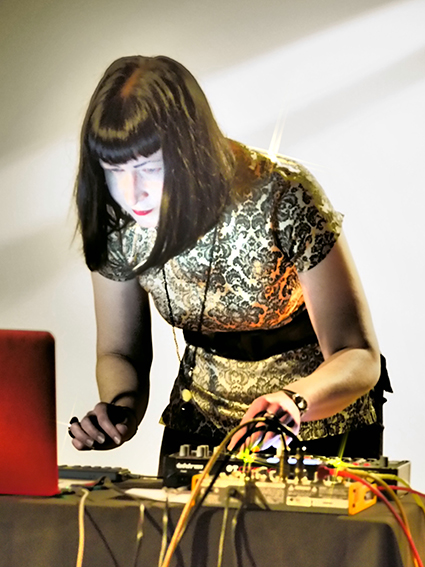
Stanier Black Five (Jo Burzynska) performs Oenosthesia, Lines of Flight, Dunedin Public Art Gallery
photo Motoko Kikkawa
Stanier Black Five (Jo Burzynska) performs Oenosthesia, Lines of Flight, Dunedin Public Art Gallery
Lines of flight (LOF) is a longstanding experimental music festival in South Island New Zealand. It continues to reflect its origins in the musical crossovers following on from punk, co-founder Peter Stapleton observing that the festival uses experimental as a “very loose, generalised term.” LOF 2015 included high-end laptop processing, free-jazz improvisation and a healthy dose of noise and dirge rock or electronica.
Since the 1990s, Dunedin and its surrounds have been home to a healthy grunge and lo-fi experimental scene, largely centred in the satellite town of Port Chalmers. The festival is split across Port Chalmers and Dunedin, offering comfortable, establishment venues for sound arts—the Dunedin Public Art Gallery (DPAG), which, though acoustically problematic, hosts excellent, buzz-free sound systems—the more intimate if sonically imprecise converted Masonic Hall of the Anteroom and the dark, cave-like Chicks Hotel.
On day one at DPAG, Stanier Black Five (Jo Burzynska) presented a sound-and-wine-matching experiment, Oenosthesia, in which a sparkling wine, pinot gris and pinot noir—all from local winery Quartz Reef—were proffered to audiences listening to the high frequency, crinkly noise of viticultural effervescence, before the mix thickened into the gris and we followed the grapes into the acoustically resonant space of the fermentation vats, finally transitioning into dense blocks of mobile noise for the noir, and closing with the sound of bottling. While the correlation of sound and taste was opaque to most, the pairing stimulated a wonderfully self-reflective experience in which one pondered possible parallels between coincident sensory inputs. It was perhaps the high-end acoustic crafting of the piece, like that of the wine, which most impressed, rather than any specific compositional structures.
Burzynska’s setting into motion multilayered sheets of noise marked a trend for the 2015 festival. Eye, featuring guitarist Peter Porteous, drummer Stapleton and electronics by Jon Chapman and guest guitarist Nathan Thompson, may nod towards John Cale and the Velvet Underground in their relentless, angry epics. They do not however share their complex song structures and are possibly closer to minimalistic dirge and sludge metal, or perhaps La Monte Young and the Dream Syndicate. Eye’s performance followed a relatively straightforward rise from micro-elements into thunderous jungle drumming and guitar wails, relieved by a slight return and then a second crescendo.
Such tough noise was echoed in the more expansive but equally minimal-to-maximal approach of Teen Haters. Peter Wright coaxed bright, sparkly, electronic sounds out of processors while accompanied by Helen Greenfield’s long, droning bows on cello. Characteristic sounds of guitar distortion gradually emerged before Wright raised the instrument above his head, and then rested it neck down on the wooden floor, downward pressure producing minimalistic alterations in cycling feedback. Though loud, their performance was if anything more meditative than Eye’s.
An international headliner for 2015 was LA guitar virtuoso Peter Kolovos, his solo moving from isolated, fragmented flourishes and sharp string-bending leaps across the fretboard through to almost Moog-like processed noises, as well as more conventionally distorted strumming which offered a devastating irruption from, and annihilation of, preceding materials. Kolovos’ performance might be considered a processed-guitar analogue to Bach’s Well-Tempered Clavier (1722), sequentially exhausting the instrument’s permutations within a compressed space of time.
Also notable was Kolovos’ filmic accompaniment, Flight Dream (2014), by New Zealand’s Joyce Campbell. Presenting filaments of white against an inky void, slow motion tendrils of smoke curled around indistinct, possibly wooden objects, before evaporating to blackness. A sense of dark but beautiful potentialities, the full force of which was alluded to but not released in any single gesture, was echoed by Kolovos, producing the most engaging of several sound-image pairings within the festival.
Prepared piano improviser Hermione Johnson and free jazz saxophonist Jeff Henderson were also a LOF highlight. They began with Johnson bowing the strings with fishing line, producing rich, extended drones which she punctuated with wobbling thunk from forks and short lengths of wood jutting out of the stringboard. Henderson’s short improvisations danced about us as he meandered through the space. Discovering an elevator, he briefly disappeared, his squealing solos recommencing far beneath us. After he returned with a particularly violent onslaught of brassy, tongued noise, Johnson turned to the keys and commenced a virtuosic set of rippling variations across dead and live notes. A double-hand position towards the bass end acted as a point of intermittent return and teasing stabilisation from which the pair’s shared musical exclamations emerged.
Over and above the impressive skills the pair displayed, it was their attentiveness to nuance and hinted potential in each other’s material which made them so compelling, offering a set of constantly evolving intuitive relations. Their foregrounding of musical complexity acted as a fillip to the droney, feedback-rich cyclic minimalism of other acts, demonstrating the diversity which LOF continues to embody.
http://lof2015.blogspot.co.nz/
9th Lines of Flight Festival of Experimental Music 2015, Dunedin Public Art Gallery, Chicks Hotel, Dunedin; Anteroom, Port Chalmers, NZ, Mar 19–21
RealTime issue #126 April-May 2015 pg. 43
© Jonathan Marshall; for permission to reproduce apply to realtime@realtimearts.net
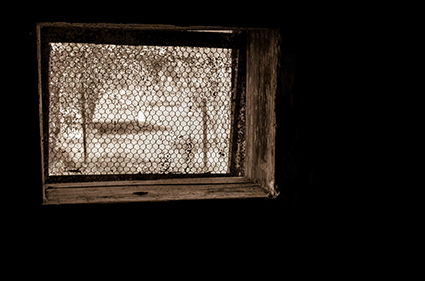
Promotional image, Window
photo Emma Woolcock
Promotional image, Window
In the manner of an album that takes its title from one of its tracks, Halcyon chamber ensemble named this concert Stolen. Some of the music fits, but not all of it is tied to a single theme. In fact only one of the compositions performed had an obvious relationship with the concert’s title, David Harris’ Yurrebilla Climbing, a quartet of instruments, without Haylcon’s voices.
Yurrebilla Climbing’s three movements presented the composer’s take on a place, the Mount Lofty Ranges; a fragment from the Bringing Them Home Report; and ‘modern multicultural society.’ Each of the movements was distinct, though perhaps not distinct enough to cover the vast territories between three very different ideas. The music could also have embraced conflict and disruption, to better capture something of the complexity and politics of its themes. Nevertheless, this was no distraction from well-performed music that was both modest and engaging.
The opening work was by David Kotlowy who, working with Kaurna people based at the University of Adelaide, set a text in the Kaurna language. With four instrumentalists on stage and two singers off, the slow unfolding of the text emphasised the vowels floating into the space. The instruments played unpitched sounds—key clicks, pedal noise, quiet whistles—as if all the consonants had been gathered—the combination dramatising the precariousness of the language itself.
Between some of the compositions, stories from Bringing Them Home were read and images by South Australian Aboriginal visual artist Allan Sumner were displayed throughout. In very different ways both elicited strong reactions. I would have liked a clearer sense of the music’s programming to make sense of these additions.
Gerard Brophy’s new work, When Peacocks Dance,was for two texts by the mystical Indian poet Kabir. The music for both was simple in the best sense, gently giving music to two very rich poems. The first, “Hansi”, an ecstatic tale of a swan and a place where “the heart wants no other joy,” is for very high soprano. The second, “Shadows” is a dark complement (though by no means downcast) with Brophy’s music in the tradition of folksong, non-dramatic, letting the text unfold.
The most successful work was Andrew Ford’s Willow Songs. Like Brophy’s, Ford’s approach to his text is sympathetic and straightforward. Unlike Brophy’s approach however, Ford is responsive to American-British poet Anne Stevenson’s line by line changes, setting the text, rather than letting the text speak against a musical background.
The songs form a continuous set, though the poetry covers a wide range of ages, from the perspectives of a 12-year old or someone recalling childbirth or contemplating death. All speak of personal experience, so it is appropriate that Ford’s music is equally direct and vivid. For a concert that also contained a good deal of silence, it was a pleasure to hear the songs run into each other. None of the other compositions in the concert made much of transitions, but Ford crafted music to flow from poem to poem. In the moments where voices fall silent, Ford’s own character comes to the fore, no longer needing to attend to a text—the result is a counterpoint of voices: singing, poetic and authorial.
Some of these transitions are particularly striking, such as the move from “Fool’s Gold,” which tells of “a girls’ night out on the town,” followed by “Incident”—the sudden self-awareness of adolescence. The musical transition is from deconstructed raucous jazz band to stark simplicity, and it comes with calculated awkwardness.
The last of the poems is a ballad, “Willow Songs,” which gives the set its name, and I was not the only person who left the hall with the melody fixed in my memory. Stevenson trained as a musician; much of her poetry in this set is musical, often the kind of poetry that composers are keen to avoid. But one has the impression that Ford is comfortable with this, speaking in an entirely sympathetic dialogue with the poet’s words. It is a conversation also open to the audience.
Halcyon and Soundstream Collective, Stolen, Sydney Conservatorium of Music, Sydney, 6 Sept, 2014
RealTime issue #126 April-May 2015 pg. 43
© Michael Hooper; for permission to reproduce apply to realtime@realtimearts.net
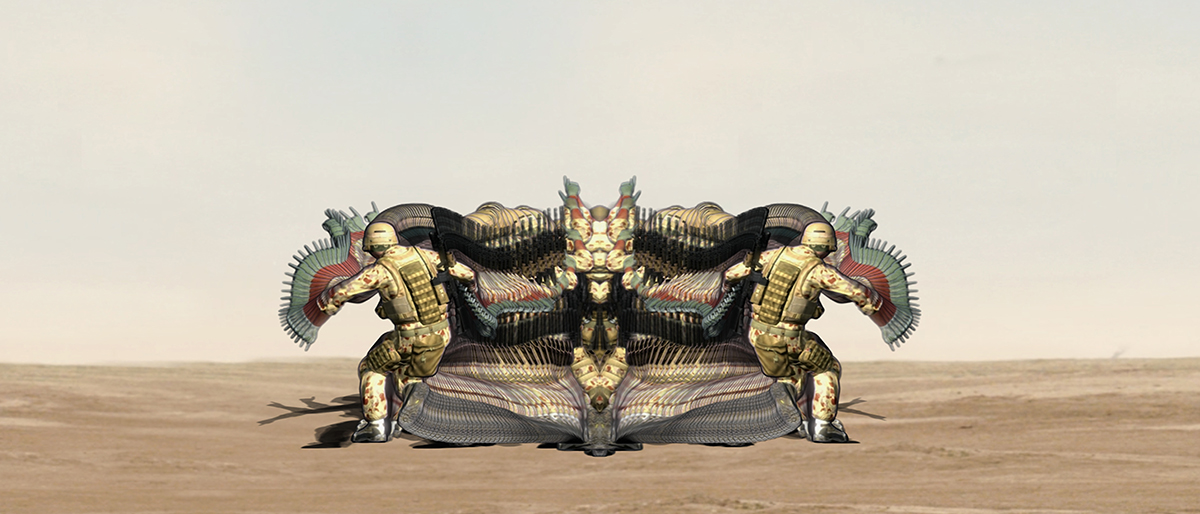
Baden Pailthorpe, detail: Cadence, 2013
In Kumano (1998), Mariko Mori faces a hyper-coloured waterfall to receive telepathic glyphs that flash like subliminal messages onto the screen. In Art Calls (2014), Tracey Moffatt appears as an intergalactic television show host, interviewing artists against a star-studded backdrop. In This Lemon Tastes of Apple (2011), Hiwa K retreats from gunfire amid an anti-government protest in Kurdistan, Iraq.
All three are on show as a part of the Perth Festival. While Mori and Moffatt have solo exhibitions, unpacked from their previous lives in the US and Brisbane respectively, K’s This Lemon Tastes is part of Theatres, a spectacular installation of international artists working on video about war. Inside the cavernous Museum of Western Australia, a series of cinema-scale screens and surround-sound systems switch on and off to bring us from one warzone to another.
A second section of Theatres is at the tiny Moana Project Space, and features virtual warzones rather than actual ones. The works are set in video games, hotel rooms and the offices of Israeli architects. In Richard Mosse’s Killcam (2009), injured American veterans recuperate from losing limbs by playing video games that simulate the Iraqi war. In Eva and Franco Mattes’s Freedom (2010), Eva tells fellow players in an online first person shooter game that she is doing a performance, before being shot over and over again.
The only Australian artist in this show, alongside international stars such as Cyprien Gaillard, is Baden Pailthorpe. In his Cadence (2009) a geared-up US soldier performs a dance that bifurcates into a digital regress of his movements, so that fanning repetitions of fatigues, guns, helmets, arms and legs create a magnificent peacock-like display of military aesthetics.
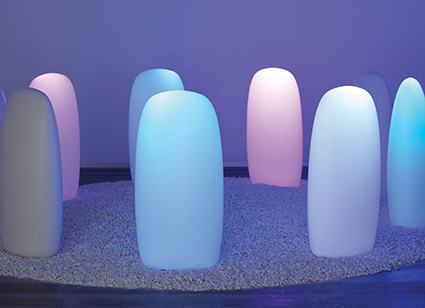
Mariko Mori, Transcircle 1.1 (2004), Rebirth, Art Gallery of WA
Next to Theatres, Mori’s exhibition looks like it’s come from a more ergonomic and peaceful planet. In Flatstone (2006) we stand above kitsch arrangements of giant ceramic pebbles, designed to remind us of archaic stone circles. In White Hole (2008-10) we sit beneath an oval porthole and watch a white light —its crawling, meditative movement modelled on the gravitational effects of a black hole.
In a video advertising one of Mori’s outdoor installations, the artist’s overdubbed voice—as pacific as an automated supermarket announcement—describes the cosmic energies channelling through the cold prism of Primal Rhythm (2009), a transparent pillar of industrial scale plastic that sits in a rocky bay in Japan. In Brazil, she is planning a floating Ring that will sit atop a spectacular waterfall.
Mori’s audacious plan is to put site-specific installations on all six inhabited continents, in a conceptually rigorous reconstruction of what nature might mean to a world that threatens its very existence. She now has her sights on Western Australia, and may turn some backwater of the state into a prayer to the natural universe, and a place for destination tourism.
The contradiction and fascination of Mori’s work comes from the artificial materials she uses to provoke pagan sensibilities. As we stare at a glowing plastic simulation of a standing stone, it is difficult not to feel disconnected from the cosmos, rather than drawn to Mori’s vision of a natural universe in harmony with itself.
Mori’s video Kumano (1998) comes from a previous phase of her work, as she achieved international fame alongside the Japanese pop art movement in the 1990s. There is an intuitive sense of fun and pleasure in this early video that is lost in her subsequent work, which is at once more sincere and ambitious.
The shift from Kumano to these installations is from ludic pop to New Age, from Lando’s Cloud City to the Death Star, from pina colada to health shake. There is a corporate sheen that wasn’t there before, an impersonal program to take over the world that mobilises Mori’s charisma to further a very precise vision of nature.
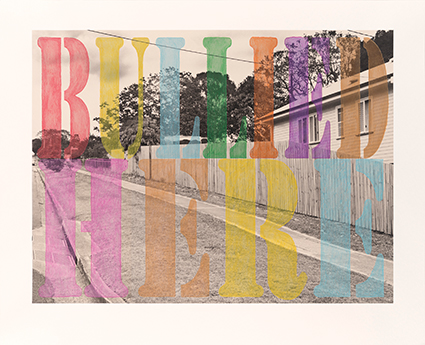
Tracey Moffatt, Bullied Here from the series ‘Spirit Landscapes’, Art Gallery of WA
copyright the artist, courtesy Roslyn Oxley9 Gallery, Sydney
Tracey Moffatt, Bullied Here from the series ‘Spirit Landscapes’, Art Gallery of WA
Tracey Moffatt’s solo exhibition has fantastic elements too, apart from her playing a TV personality on a spaceship. A series of montages titled As I Lie Back on My Ancestral Land (2013) feature a naked woman’s torso amid brightly coloured clouds and treetops. There are other photographs too. Large black and white prints of houses and streets are overtyped with large, colourful stencils that spell out texts such as “BULLIED HERE” and “TEA AT THE REVERENDS.”
Moffatt is the Australian version of Cindy Sherman, as her uncanny photography taps into the suburban unconscious of Country. Her pictures of the Aboriginal settlement at Cherbourg, the Picturesque Cherbourg series, are of white picket fences and tin rooves, while the posed nudity of the As I Lie Back series resembles soft porn.
Through this exhibition it is possible to identify the genres that Moffatt returns to most persistently. These are the brightly hand-coloured photograph, childhood reflections and the sneaky camera. While montaged and stencilled photographs are part of the first genres on show here, In and Out (2013) carries on her interest in sneaky, hidden cameras, as it shows people walking in and out of a brothel doorway.
The parallels between Moffatt and Mori are strange and striking, as two successful art stars present utopian, science fictional visions laced with discomfort. The discomfort of Moffatt’s work comes from its allusions to Australian history, to families and childhoods; Mori’s from her rigorous New Ageism, her concepts of nature and peace that have been processed into industrial grade plastic.
For the philosopher Immanuel Kant, artists are not so much free as free to present the world. Art is only free insofar as it shows us how the world limits an artist’s freedom. The vision of the Iraqi artist K, walking freely in a war zone, describes his own limits living in this wrecked country. And the spectacular, consciousness-raising outdoor installations of Mori’s Primal Rhythm and Ring describe a very different kind of freedom. Moffatt, having returned from New York to live in Australia, reminds us that no matter how far away you go, you cannot escape where you come from.
–
2015 Perth International Arts Festival: Mariko Mori, Rebirth, Art Gallery of Western Australia, 8 Feb-29 June; Tracey Moffatt, Kaleidoscope, Perth Institute of Contemporary Arts, 19 Feb-12 April; Theatres, Moana Project Space and Western Australian Museum, 19 Feb-8 March
RealTime issue #126 April-May 2015 pg. 44
© Darren Jorgensen; for permission to reproduce apply to realtime@realtimearts.net
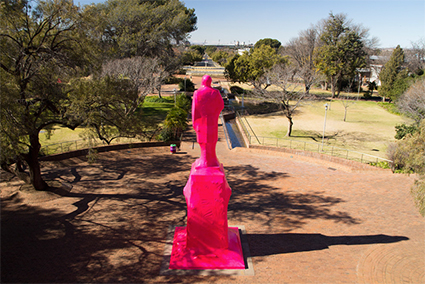
Cigdem Aydemir, documentation of Plastic Presidents at Vryfees in South Africa
photo courtesy Salamanca Arts Centre
Cigdem Aydemir, documentation of Plastic Presidents at Vryfees in South Africa
Put out to tender, the Australia Council’s Art in Festivals strategic initiative has been twice secured by Hobart’s Salamanca Arts Centre which created the SITUATE model. Melbourne-based freelance curator Kelli Alred started work as Executive Director of the second SITUATE in January this year. Her background is in commissioning new work with a focus on temporal and spatial practices in the UK for 12 years before returning to Australia. RealTime asked Alred to describe precisely how SITUATE operates and in what ways it has been successful.
Alred says, “Situate facilitates an experience, a residential multidisciplinary Arts Lab, so that artists can create works that are bespoke to the festivals. So we have a focus on partner festivals specifically and part of the concept of the Arts Lab is to bring the curators and directors of those festivals together with the artists.” For 2015-16 the partner festivals are Dark MOFO, MONA FOMA (TAS), Darwin Festival, FRINGE WORLD (WA), WOMADelaide and Vryfees (South Africa).
“The artists not only learn from the mentoring process with provocateurs about the development of larger scale concepts or working in the festival environment. They also learn about specific festivals and their proposals are then focused on them.”
One artist has completed her commission, two are about to and a fourth is moving towards being commissioned. Cigdem Aydemir is a Sydney-based artist who delivered a project for Bloemfontein’s 2014 Vryfees Festival. “The work looked at the tradition of the monument in the context of Apartheid South Africa. There are statues of past presidents of South Africa spread across the University of the Free State. Cigdem wanted to, let’s say, ‘re-imagine’ and appropriate the notion of the monument in the socio-political context.” The work, titled Plastic Histories, comprises pink shrink-wrapped statues of presidents: the colour represents the women of post-Apartheid South Africa and the wrapping the plasticity of attitudes across generations.
Tyrone Sheather will show his work in the Hobart Botanical Gardens as part of the 2015 Dark MOFO. “He’s a young Indigenous man from Bellingen in the Coffs Harbour area of NSW. There’s been communication between the Gumbaynggirr mob in Bellingen and the Hobart mob. Tyrone’s work looks at cultural references from the Bellingen area. The Hobart mob will stage a welcome to country ceremony to solidify the gift of that site.” Alred describes the rites of passage work as a series of large fibreglass and steel “sky being” sculptures encrusted with traditional ochres, LED lights responsive to audience movement and “a mix of sounds specific to locations in Tasmania and Bellingen.”
Dark MOFO Creative Director Leigh Carmichael writes, “When Dark MOFO partnered with Situate Art in Festivals in 2013, I didn’t know quite what to expect—either from the artists, or of the festival itself. The proposals coming out of the Situate Arts Lab were very strong. I was interested in four proposals in particular, all challenging and risk-taking in different ways. Tyrone Sheather’s Giidanyba came through because of the melding of ancient mythology with high-tech, and his community’s commitment to sharing culture.”
A third SITUATE graduate, Jess Olivieri of Parachutes for Ladies, will present a large-scale public participatory performance-based project at the 2015 Vryfees Festival. Artistic director Ricardo Peach writes, “The partnership with SITUATE has been incredibly important in facilitating experimental new work that explores the pressing social and political inequalities still in place in South Africa. Aydemir’s Plastic Histories allowed for a nuanced intervention into a previous dominant history to raise awareness of alternate histories—especially of women from all races, sexual orientation and languages. As a result the festival garnered national attention and opened up its doors to previous marginalised community groups who may not have known that they were welcome at the event.”
Artist Michaela Gleave recently attended her first WOMADelaide in March to see how the site worked when in full swing. Her project has progressed through the R&D phase towards commissioning. WOMADelaide, SITUATE and the artist are investigating financial contribution options for the making of the work.
SITUATE evolves in structured stages, says Alred. “In the first instance, artists submit an application to the Arts Laboratory, committing to engage in a residential interdisciplinary laboratory and to be guided by a group of experienced creative practitioners as provocateurs in order to learn about risks and developing ideas, scaling up, festival audiences and the difficulties and the logistics of working in large-scale festival environments. A national curatorium ensures a rigorous process of assessment. Then we announce the selected artists who’ll be invited to come to Tasmania and have a transformative experience. At the end of this process, artists are expected to pin down up to three ideas to pitch to each of the festival partners. Then we go into the mentoring phase.”
“We’ll have people appropriate to the task of guiding the artists in refining and developing their concept, in writing a proposal and ensuring it’s structured, formatted and has all the information required. How to communicate their ideas to the festival directors is part of that mentoring process to develop and fully refine a proposal. Those proposals go to the festival directors and they come back with an expression of interest in one or more of the projects.”
Subsequently, says Alred, “a less formal mentoring process continues through fundraising initiatives and assisting the artists by looking at how they might access funds to support development of the work. Then there are the contractual negotiations. We also have an experienced production manager and fabricator who costs projects and looks at feasibility. He has been working very closely with Tyrone Sheather. They’ve just been to China to source materials. All of this ensures that these proposals go through to the festival directors with everyone feeling confident that projects are viable.”
The commissioning process asks festival directors “to commit to R&D funding, a small-scale commitment in the first instance. And that’s where the production manager really comes in. They nut out the finer details of the logistics, including travel to the site if necessary and picking of a specific location. Then there’ll be negotiations with the directors over what support and financial commitment they might offer. The budget might need to be scaled up or down depending on how negotiations go.” And then there’s everything SITUATE is finally about: the thrills of the making, installing and being seen. RT
www.situate.org.au
SITUATE Arts Lab, A Salamanca Arts Centre Project. Submissions 18 May-20 July 2015; SITUATE Arts Lab, Tasmania, 11-22 Jan, 2016
RealTime issue #126 April-May 2015 pg. 45
© RT ; for permission to reproduce apply to realtime@realtimearts.net
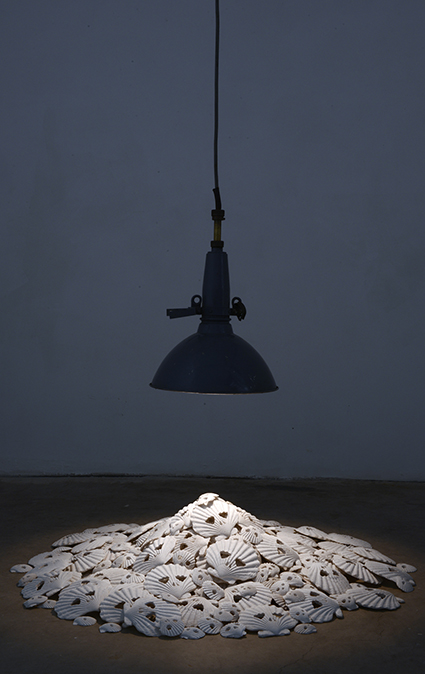
Jason Wing, Fossil
image courtesy Anna Pappas Gallery
Jason Wing, Fossil
The annual Project show at Anna Pappas Gallery is always a cornucopia of boundary-skirting, concept-driven, multi-disciplinary works, curated around a sweeping, catch-all theme. Among each year’s group of artists, any visitor will find a handful whose work resonates. This year’s theme, DEATH | LIFE, delivers an especially broad range of responses, from the ritualistic to the poetic to the cerebral.
DEATH | LIFE’s curator, Sebastian Goldspink, provides selected artists with a ‘catalyst’ rather than curatorial directive, in the form of a brief short story. A woman sits in a bath each evening and slides a gun into her mouth, thumb to the trigger. She fantasises about ‘after.’ But when one night ‘it happens,’ regret pours into the milliseconds of remaining awareness—her ‘death life’—and she experiences a profound ‘joining the dots’ of herself to everything: a vast realisation of meaning, consciousness and uncontrollable desire.
It’s a dark, explosive story in many ways, but of DEATH | LIFE’s 11 artists, none appears to choose a head-on approach. For me the work that sidles poetically closest to the shadowed but near-bittersweet tale is Sam Fagan’s Grasp. Grasp consists of fine ink lines on archival tissue paper, so closely drawn that almost nothing of the near-transparent background remains; the whole piece is in saturated tones of charcoal, black and grey. A dark, eight-pointed star dominates, drawing the gaze towards a light grey centre, which glows like a portal around a further, small star. The tissue is so delicate that drying ink has left crinkled patches behind; there are minute tears where the drawing process itself has come close to ruining the work. Grasp feels like a threshold between one life and the next, arousing the desire to step into the weakness in the tissue to test the material at its delicate limit and risk breaking through.
Michaela Gleave’s Orbit is a projected, circular sea/skyscape rotating at leisurely pace. The projection apparatus stands before it at human height, like a machinic audience. As the image turns, perception shifts: when oriented naturally there is depth: one senses the distant horizon and the path across the sea. As it turns though, this ‘sense’ is gradually lost until, upside-down, the image seems reduced to two semicircles of colour and pattern. The movement through time and tumbling space bends understanding: sense and a kind of non-sense alternate endlessly. Always testing the edges of both aesthetics and the physical world, Gleave seems to be teasing out a kind of perceptual physics from Goldspink’s story’s shattering moment of truth.
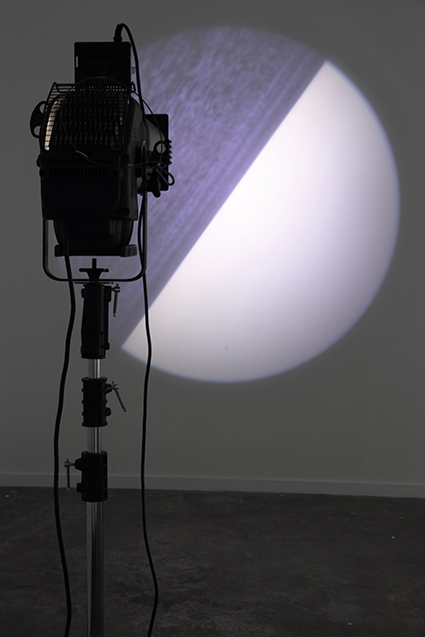
Michaela Gleave, Orbit, Project 15: Death/Life
image courtesy Anna Pappas Gallery
Michaela Gleave, Orbit, Project 15: Death/Life
In Kate Scardifield’s video, New Order, weirdly organic, shining, morphing figures manifest themselves from a fabric of golden scales, shape-shifting constantly, ritually, slowly. An illusion created with the help of choreographed performers, painstaking sequin-sewing and clever lighting, these forms impress themselves on the imagination as dinosaur one minute and kimono the next, praying mantis or opening wing. I struggle to place the work into curatorial context—but am fascinated and just keep thinking ‘liminal…liminal.’
In a sense, ‘not-knowing’ is at the heart of DEATH | LIFE. Katie Lee’s work Untitled (Dreaming of a Technological Future) resists interpretation most strongly—troublingly. But rather than shrug shoulders, I find myself spending time with it. There are works one doesn’t ‘get,’ and works one doesn’t get but wants to, urgently. There are balls and chain, disconnected from one another; the balls are scattered on the floor. A ladder that doesn’t reach the ground. There are echoes of other Lee works, which articulate space so precisely and surprisingly, but in this space this quality gives way to something more emotive. The iron-like heft and texture of the chain (it is actually ceramic) presses against polished brass; the heavy balls seem poised for movement, just one point of each sphere in contact with the floor. I feel limitation and freedom, staying and leaving, the about-to-break and the unbreakable, the chance to climb out of it all.
Like reincarnated Halloween pumpkins (there’s lots of shape-shifting in DEATH | LIFE) the myriad cast-resin seashells in Jason Wing’s Fossil Fuel look out uncannily from carved-out faces, lying on their bed of ocean sand, lit from above by a low-slung lamp. They are ghosts in all sizes, like adults and children washed up on shores of a world wrecked, perhaps, by those fossil fuels; or waiting to themselves be compressed over millions of years, becoming the fuel of the future. The work is quietly poetic, political and beautiful, suggesting things beneath that sand—oil reserves, sea graves, lost things.
With no individual artist statements DEATH | LIFE leaves space for a more unmediated response than usual, yet it nudges the urge to contextualise and order. One can only ‘join the dots’ between the titles of the works and Goldspink’s catalytic story—but perhaps that drawing of one’s own chart amid so many different, unexplained charts, is both desire and solution: the mystery and the neat resolve at once.
Project 15: DEATH | LIFE, curator Sebastian Goldspink, artists Tully Arnot, Sam Fagan, Michaela Gleave, Samuel Hodge, Daniel Hollier, Katie Lee, Phil James, Kenny Pittock, Artemis Potamianou, Kate Scardifield, Jason Wing, Anna Pappas Gallery, Melbourne, 6–28 Feb
RealTime issue #126 April-May 2015 pg. 46
© Urszula Dawkins; for permission to reproduce apply to realtime@realtimearts.net
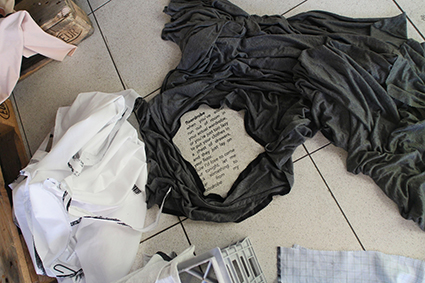
Floordrobe, Cluny McCullagh
image courtesy the artist
Floordrobe, Cluny McCullagh
Intgrs/integer/whole. Integrity. Disclaimer: it is my opinion that the fashion industry doesn’t seem to have a lot of stock to trade in integrity. I am not, however, conflicted by the fact that I love clothing: design, cut, texture, fabrication.
Walking through Southbank in Melbourne, which is a cluster of towering, faceless residential blocks set on fast-moving arterial roads, I reach Testing Grounds, the venue for INTGRS. It is a little patch of abandoned industrial dirt abutting the glittering spire of the Arts Centre that has been converted into a quiet experimental art space. The plot of land is filled with wooden crates fashioned into outdoor furniture while shipping containers reveal project spaces. Inside one of these is the artist, Cluny McCullagh. She is articulate and energetic, having recently returned from Antwerp where she was cataloging historical clothing at the ModeMuseum.
INTGRS, the major project of McCullagh’s MA, invites participants to pick up garments from the Floordrobe (“no hangers, no hierarchies”) and to sculpt the pieces to the body. There is a notable absence of mirrors in this shop floor-cum-project space. All the pieces are zero-waste, meaning that any cutting has not resulted in material being discarded. Instead McCullagh’s proposed toolkit consists of cutting templates, a curved shape which resembles bra underwire but thicker, and an oblong not unlike a half-sized ruler which provide both decorative functions—tassels and slits, to functional cuts—arm holes, leg holes. The pieces themselves, designed in collaboration with Dylan McDonough, are based on actual patterns without the negative space and waste. The fabrication and length of these fringed and perforated oblongs determine initial perceptions of wearability but are not limited to traditional notions of dress. The pieces seek to create possibilities and are not defined by size. A short film we view later—FLOORDROBE: redressed (Kelly Lawn, filmed in collaboration with Yvette Turnbull)—asks of a tuxedo fabric ensemble, “Is it a tuxedo or a wedding dress?”
After turning a navy tunic-type garment in my hands for a while, I decide to put my head through a large slit, which has been finished with seams. Without a mirror, I look to those in the room to gauge my success but there don’t seem to be any rules; as long as it feels right. A woman who has arrived at the same time as me throws herself into the process with real gusto, layering items unselfconsciously. Without mirrors and defined sizes, there is a playfulness to this experiment; we get a bit braver too. In pushing for the democratising of fashion and wrenching it out of the realm of desire, McCullagh has managed to retain the pleasure of clothing—powder blue silk glides over me like water and I imagine a magic evening gown. The act of dressing with INTGRS becomes a communal event, where participants are co-creators of new styles.
Leaving the clothes for a minute, I venture to look over at the supporting work for INTGRS, the cutting templates that the artist has created and a beautifully designed book that further provides ideas and inspiration to bring integrity into fashion. The flexibility of McCullagh’s BA in Design (Fashion) at RMIT University allowed her to closely examine fashion in the context of design research and innovation. She has a healthy irreverence for fashion, dressed today in a T-shirt with a print photo of breasts, which she wore to fashion shows, making sure to sit close to the runway in the hope that she would be photographed during the “Free the Nipple” campaign. Her interests go beyond fashion to design, particularly social innovation and non-intentional design—how we make do at a pinch such as when, for instance, we use a key to open letters on the way into the house, she explains.
Though impressed with the age and condition of the museum pieces in Antwerp, McCullagh saw first-hand how fashion is cyclical, seemingly always in a state of flux but essentially unchanging. These garments embody status, desire, gender and size. Since the Renaissance, when loose robes gave way to tailored garments, cutting has been at the fore of clothing production, which brought both waste and waist-lines into the equation. Design (such as cities, housing—Southbank being a fine example) comes weighted down with the past, with little thought to resetting the model. With INTGRS McCullagh gives a small glimpse into the possibilities of where rethinking fashion can take us. Now if I can just get the confidence to wear this tunic beyond the door of the shipping container.
Australia Melbourne Fashion Festival: Cluny McCullagh, INTGRS, Testing Grounds, Melbourne, 28 Feb-4 March
RealTime issue #126 April-May 2015 pg. 47
© Varia Karipoff; for permission to reproduce apply to realtime@realtimearts.net
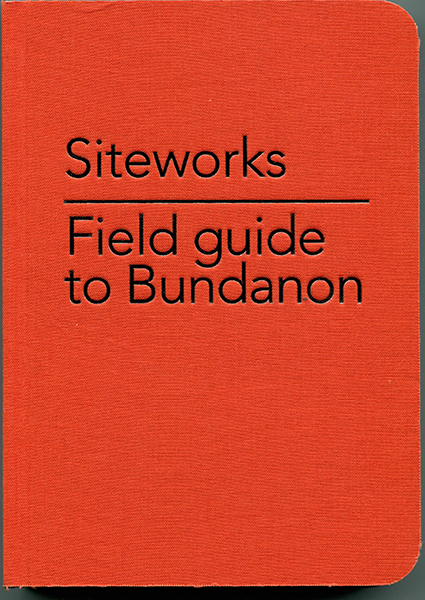
Book: Siteworks: Field Guide To Bundanon
This superbly edited and produced book is a perfect guide to the geology, flora, fauna, Indigenous and settler history and the lives of the Boyd family at Bundanon. It’s a rich compilation of images and stories, maps, scientific research, artworks, recipes, anecdotes, poetry and social history. As well it stands as a catalogue for the first four editions of Bundanon’s annual Spring Siteworks event. Edited by Deborah Ely. Published by Bundanon Trust,$35.00. Available for purchase online at bundanon.com.au/products/siteworks-field-guide
3 copies courtesy of the Bundanon Trust
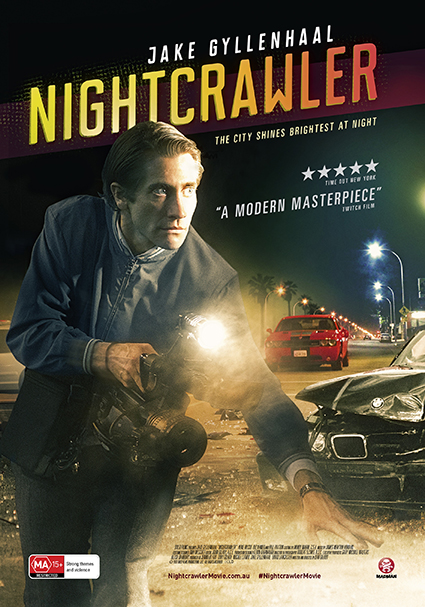
DVD: Dan Gilroy’s Nightcrawler
A wickedly satirical take on the machinations of one self-made man in that grubbiest of professions—if you don’t count stockbrokers—ambulance chasing. A gaunt Jake Gyllenhaal is frighteningly convincing as the desperate Lou Bloom, immersed in small business and self-help rhetoric who meets his match in an equally viperous TV producer (Renee Russo) eager to encourage Lou’s innovative if increasingly gruesome approaches to newsgathering.
5 copies courtesy of Madman entertainment
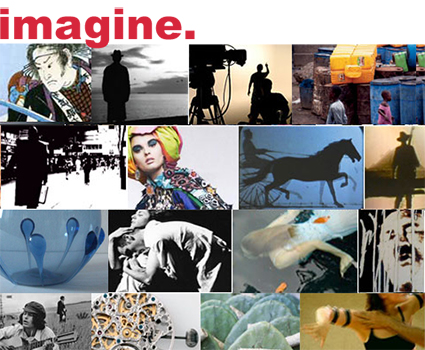
Artfilms-digital: 1-year Online Streaming Subscription
Breaking News! Artfilms-digital is now available for home streaming for artists and art lovers. Watch 700+ inspirational interviews, training and performance films in theatre, dance, music, design, visual and digital arts. The catalogue includes interviews with theatre greats Grotowski, Barba, Brook and Foreman, productions by Jenny Kemp, The Sydney Front, The opera Project, Chunky Move, Bangarra, Lucy Guerin Inc and Tess de Quincey and documentaries about Stanislavski, Meyerhold and The Bauhaus. Read more at www.artfilms-digital.com
3 one-year subscriptions courtesy of Artfilms
Please note you can nominate for ONLY ONE GIVEAWAY.
Email us at giveaways@realtimearts.net with your name, postal address and phone number. Include ‘Giveaway’ and the name of the item in the subject line.
RealTime issue #126 April-May 2015 pg. 48
To be delivered by the Prime Minister of Australia, at the time of her choosing
Madam Speaker, I move that today we deliver an apology to survivors of Australia’s immigration detention regime.
The policy of mandatory detention was introduced in 1992 by a Labor government, with the support of the Liberal-National coalition. Originally intended as an extraordinary measure, it soon became an ordinary one. In 1994, this parliament voted to lift the 273-day limit on detention thus rendering it not only immediate but also potentially indefinite; in 1999, the Woomera Immigration and Processing Centre opened and in 2001, the Pacific Solution introduced offshore processing. Soon there were detention centres in the city, the desert, the country, even other countries. In total, across twenty years we have run more than twenty detention centres.
The practice of detaining people for long periods in isolated locations caused immense harm. We cannot say that we did not know, because we did. This parliament itself conducted dozens of inquiries, under the auspices of various Senate, Joint, Standing and Select Committees. Other government bodies such as the Auditor General, the Attorney General, the Australian Human Rights Commission, the Commonwealth and State Ombudsmen, all investigated and reported on conditions in immigration detention.
International bodies such as the United Nations reported multiple times through multiple arms, including the UN High Commissioner for Refugees, the UN Working Group on Arbitrary Detention, and the UN Special Rapporteur on Torture. So too did non-government organisations such as Amnesty International and Human Rights Watch. There were special investigations into specific cases, conducted by Mick Palmer, Neil Comrie, Phillip Moss and others. Most importantly, the asylum seekers themselves told us, first from within and then from beyond detention, on some occasions in this very parliament. But still we would not listen. Today we have. Today we do. And we hope that you the survivors will in turn listen to this—our apology.
*
To those who came across the seas, seeking a life free from fear and persecution but instead found themselves imprisoned like criminals—we say sorry.
To those whose suffering in their homelands and on the high seas was compounded by our centres of detention—we say sorry.
To those who were held in countries we deputised to detain you, such as Papua New Guinea and Nauru, who either could not or would not keep you safe—we say sorry.
To those who were confined in the middle of our cities, in Villawood and Maribyrnong, surrounded by millions but all alone—we say sorry.
To those who were isolated in Woomera, Baxter, Curtin and Christmas Island—we say sorry.
To those who were dehumanised and called by number not name—we say sorry.
To those who starved yourselves, stitched your lips and dug your own graves—we say sorry.
Detention damaged all who endured it but it wrought particular effects on families. We apologise to the fathers who could not provide for their loved ones, the mothers who could not care for their babies, and the children who lost their childhoods. No child should ever be deprived of safety, liberty and education and yet this is precisely what we did.
We apologise to every child who endured detention but especially those who arrived as unaccompanied minors. So young and so far from home, we abandoned you when you needed us most, making your guard and your guardian one and the same. We left you to navigate a system that no child could conceive, let alone comprehend. To the families who loved and looked after you, even as they themselves were often struggling through that same system, we say thank you. We are in your debt.
Of course, there are some to whom we cannot apologise, for they are gone. We grieve for those who went to a watery grave, the more than 1000 souls who were lost at sea in the SIEV X, the SIEV 221 and other maritime disasters. We grieve for those such as Reza Berati and Hamid Kehazaei who died while in our care. We also grieve for those who did manage to survive detention but who could not survive beyond that, who felt so haunted and hunted that they took their own lives. And we grieve for those who did survive, but who still suffer from anxiety, depression and post-traumatic stress disorder.
We also acknowledge those of you who emerged, against the odds, with your mental health relatively intact. We are in awe of your strength but also realise that your resilience does not diminish the gravity and immorality of our actions: a great injustice was done, your human rights were wronged, and you suffered unnecessarily. To you too, we say sorry.
More broadly, we acknowledge the immense harm these practices caused other migrants, permanent residents and citizens. To Vivian Alvarez Solon, a citizen who was deported, to Cornelia Rau, a permanent resident who was wrongly detained, and to the countless others who were caught in the dragnet of this sweeping, unjust policy—we say sorry.
We also apologise to those Australians who had arrived by boat previously, whether from South-East Asia in late 1980s and early 1990s or from the Middle East in the late 1990s and early 2000s. How painful it must have been for you to witness each new round of arrivals, each new round of vilification. You would have known what suffering was in store for your fellow travellers and you would have felt—yet again—that you were not truly welcome here. To you too, we say sorry.
*
So many people have worked so hard, for so long to make this day come about. We salute various advocacy groups, including the Refugees, Survivors and Ex-Detainees, the Asylum Seeker Resource Centre, the Asylum Seekers Centre, the Refugee Advice and Casework Service and many others. We thank the whistleblowers, the caseworkers, the guards, the migration agents, the medicos and the departmental officers who chose to ignore their confidentiality clauses and who risked their careers in order to speak the truth. We thank the artists, the activists, the lawyers, and the lobbyists for speaking out when no one would listen and for showing moral courage when many around you did not. These are precisely the virtues, and you are precisely the people, we are proud to call Australian.
But as they themselves would insist, this is a peripheral matter, for we are here to apologise to the survivors of detention and to honour their courage and sacrifice. And so I want to finish by offering you a belated but heartfelt welcome.
In truth, it is an extraordinary human being who leaves everyone and everything they know, who hurries into the night, onto the truck, the train, the plane, the boat; who, upon arriving in detention, musters the strength to get through just one more day, one more month, one more year; and who, having finally left detention sets to work—finding a job, making a home, starting a family and building a community, our community. These are precisely the virtues, and you are precisely the people, we are proud to call Australian.
Together, you and your advocates worked tirelessly in the hope that Australia would one day realise what it had done to you, to itself, to ourselves. I am here to tell you that day is here; that day is today.
And we say to you today what we should have said to you all those years ago—we are so sorry for your suffering, please come in. You are safe now, here with us. Better yet, you are home.
*
Read Caroline Wake's feature coverage of Australian refugee detention.
RealTime issue #126 April-May 2015 pg. 3
© Caroline Wake; for permission to reproduce apply to realtime@realtimearts.net
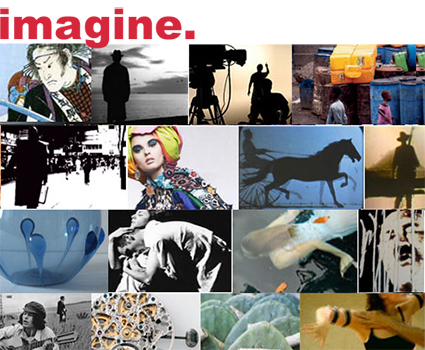 Artfilms is a treasure house of interviews, documentaries and recorded performances. It’s now available for home streaming for artists and art lovers. Artfilms-digital has 750+ inspirational interviews, training and performance films in theatre, dance, music, design, visual and digital arts.
Artfilms is a treasure house of interviews, documentaries and recorded performances. It’s now available for home streaming for artists and art lovers. Artfilms-digital has 750+ inspirational interviews, training and performance films in theatre, dance, music, design, visual and digital arts.
The catalogue includes interviews with Grotowski, Barba, Brook and Foreman; performances by The Sydney Front and The opera Project, dance by Chunky Move, Lucy Guerin Inc, Bangarra, Tess De Quincey and Sue Healey and the theatre creations of Jenny Kemp.
There are documentaries about Stanislavski, Meyerhold, The Bauhaus, African ritual masks, cutting edge object design, eco fashion, holographic art and films by experimentalists Paul Winkler, UBU, David Perry, Takahiko Iimura and Paul Cox. As well there are art history documentaries, music concerts and digital art.
Flexible contracts, automatic updates. Read more about it and sign up:
www.artfilms-digital.com
On our Giveways page, free one-year Artfilms-digital subscriptions are offered to three lucky RealTime readers.
RealTime issue #126 April-May 2015 pg. 21
© RT ; for permission to reproduce apply to realtime@realtimearts.net
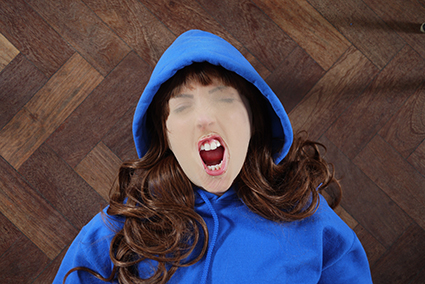
Elizabeth Bernholz (Gazelle Twin) Unsound, Adelaide Festival of Arts
photo Tash Tung
Elizabeth Bernholz (Gazelle Twin) Unsound, Adelaide Festival of Arts
But most of us don’t. Not really. There’s the occasional rhythmic knee-bending, weight-shifting and some head-swinging. There’s also enough machine-made smoke and moving LED lighting to make any raver happy, but the throbbing mass of bouncing bodies never quite manifests.
In a different environment some of the acts may very well be party-pumpers, but programmed in the context of Unsound, the signature experimental electronic music event for the Adelaide Festival, the clever mix of artists creates a kind of sympathetic resonance so that all the sonic offerings are received with an attitude of ‘serious listening.’
Thursday
Lawrence English (AUS) establishes the tone by asking the audience to lie on the floor. English is currently mining the territory of his latest album, Wilderness of Mirrors (see review/interview), creating epic shifting dronescapes out of harmonic material wrapped in rubble. He starts by accumulating dirty and increasingly hysterical sound layers from the eerie scream of an Aztec death whistle. The flight to first climax is rapid and risky. Where can he go from here? But English is adept at layering and after the diminuendo he quickly constructs another wall of sound into which he carves his sonic bas-relief. However the series of crests and troughs wears itself out, as the penultimate escalation has the audience clapping, thinking the performance over when there is still an epilogue pending.
Gazelle Twin (Elizabeth Bernholz, UK), in blue hooded tracksuit and stockinged facemask, is a surprise highlight. She has a simply fantastic voice that she loops and saturates to make tuned and textured noise, over which she adds soaring lead vocals. Her pared-back beats, played by a similarly hooded anonymous fellow could certainly compel you to dance, if you weren’t so awestruck by that voice. The production is slick yet the effect is still deeply visceral. The recordings I’d been listening to certainly intrigued, but Gazelle Twin really shines live.
Container (Ren Schofield, US) offers the perfect example of the thinking-dancing tensions inherent in the programming of Unsound. He works with beats and noise, or noisy beats, adding a crunchy complexity to his techno palette. Earlier in the set his minimalist rhythmic phrases slip over the top of each other creating shifting relationships of changing pulse. His head nods to a phraseology of his own hearing while we lock in and fall out of time, happily adjusting to his skipping rhythms. As the set continues the sound becomes fuller, and perhaps more regular, and there is more movement on the floor.
The first night finishes with the distinctly undanceable psychedelic noise rock of Fushitsusha (Japan) led by Keiji Haino. The glorious long hair of the three men (Haino’s now silver) whips and flails as they relentlessly progress through their loping, angular assault, the drum and bass forming a broken landscape over which Haino’s dark and dirty guitar lashes like an apocalyptic storm. It’s brutal yet strangely lulling, or is it numbing, in its relentless tumble of notes and noises.
Friday
Night two launches with UK artist Matthew Barnes/Forest Swords’ soaring folktronica that transitions every now and then to dance music—a big alt-pop sound, tightly performed. The Bug (Kevin Martin, UK) plays on our addiction to bass by alternately withholding then dropping it, not always when we’re ready. His set takes off with the addition of his two guest MCs, Miss Red (Israel) and Manga (UK), who cajole us onto the party plane. Which is where Shackleton (UK) finds and keeps us with his smart mix of hypnotic, spare, yet intricately crafted beats and sample shards.

Robin Fox, Unsound, Adelaide Festival of Arts
photo Tony Lewis
Robin Fox, Unsound, Adelaide Festival of Arts
The highlight of night two, programmed as the second act, is the special commission Double Vision from ATOM™ (Uwe Schmidt, Germany/Chile) and Robin Fox (Aus). Here we witness an epic battle of figuration and abstraction. ATOM’s glitchy beats are accompanied by monochrome visuals of shapes and silhouettes made from pixel-building blocks, front-projected onto the stage. Fox’s red, green and blue lasers shoot geometric shapes at us from the front, etching scribbles on the back wall. His abstractions are framed by ATOM who at one point issues the written text accompanied by a machine-voice: “LED, photography, video, colour TV/ Mr Fox will make you see in RGB.” Fox’s influence is implicit as ATOM’s black and white figures begin to break up and take on pixels of red, green and blue. Sonically, it’s a curious combination, the two inputs generally seeming distinct, yet happily co-existing, Fox forming a dirty base grid over which ATOM’s glitches twitch and skitter. Fox’s RGB Laser concept is so complete, it’s a tough call to incorporate other inputs, but emphasising the two artists’ differences is a solid strategy.
Saturday
Kicking off the final night Mika Vainio (Finland/Germany) plays a challenging set for some, generating interrupted rhythms and sharp machine noises with lots of sudden stereo panning and awkward silences. Maybe there is a sound check issue as it looks/sounds like he’s still testing the system, but it’s also this sense of play and exploration along with the purity and abstraction of his palette that make his performance one of the more engaging for the more experimentally inclined.
Dopplereffekt (Gerald Donald with To Nhan, US) offer a generous set of their ersatz Kraftwerk music. It’s well executed and entertaining in its retro-futurist earnestness. However, playing their deliberately limited synth-sounds for what seemed like over an hour pushes the patience of some of us. (The accompanying video sequence based on footage of the Large Hadron Collider, with the artists cutely inserted, is interesting the first three times.)
The third night is plagued by last-minute cancellations—Model 500 due to ill health and Heiroglyphic Being for reasons unspecified. HTRK (AUS) is flown in as a replacement and seems distracted or poorly sound-checked. Their music relies on an enveloping swampy fusion of vocals, crunchy beats and guitar abstractions but in this performance it struggles to cohere. Only in their final track do they seem to hit their stride. Kevin Martin, this time under his King Midas Sound System guise, steps in to fill the other cancellation and plays a more experimental set than the night before—slowed and deconstructed dance tracks with some truly shredding, swirling, noise epiphanies that bring the festival to a suitably exultant end.
With no stated curatorial theme beyond “experimental and electronic,” Unsound excels at creating a context in which the noisy, the abstract and the big-beat can generate heat and friction often resulting in a fascinating fusion. Of course, this mix of musics happens all the time in the non-commercial underground—in warehouses and galleries and garages around the country. But it doesn’t happen at scale in the mainstream festival sphere. Over the years What is Music? and Room 40’s Open Frame have invited a number of significant international electronic artists to Australia who traverse the overground/underground divide, but Unsound and its alliance with the Adelaide Festival, ups the scale and is a most welcome addition.
Adelaide Festival: Unsound 2014, curators Mat Schulz, David Sefton, 12-14 March, Freemasons Hall, Adelaide
RealTime issue #126 April-May 2015 pg. 11
© Gail Priest; for permission to reproduce apply to realtime@realtimearts.net
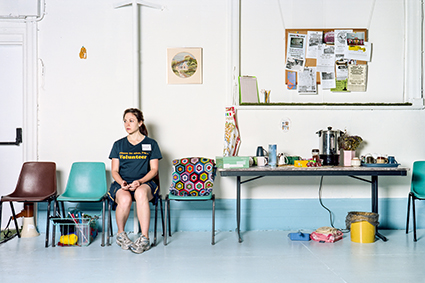
Nicola Gunn, Hello, my name is Nicola Gunn
photo Pier Carthew
Nicola Gunn, Hello, my name is Nicola Gunn
The rush is on. Artists and producers are selecting their wares for the 2016 Australian Performing Arts Market at Brisbane’s Powerhouse, submitting applications (deadline July 1) to present complete works or 25-minute excerpts (for productions ready to tour) in the Showcase or to deliver pitches (for works in development), or run stalls displaying samples of distinctive cultural produce.
Staged 22–26 February 2016 at the Brisbane Powerhouse and other venues, APAM 2016 will coincide with the welcome return of the World Theatre Festival (WTF), the Powerhouse’s contemporary performance event and the wonderful Asia-Pacific Triennial of Contemporary Art at the Queensland Gallery of Art and Gallery of Modern Art.
The long-lived biennial APAM, established by the Australia Council for the Arts in 1994, is a major platform for artists working across a remarkable range of practices in theatre, contemporary performance, puppetry, dance, music, live art and performative installation, including always distinctive works by Aboriginal and Torres Strait Islander practitioners.
This venerable but progressive market’s “key purpose continues to be the increase of international and national touring opportunities for Australian contemporary performing arts groups and artists.” It achieves this not only through presentation but by providing “dialogue, collaboration and exchange between local artists and producers and their international counterparts,” opening with a keynote address and followed by breakfast, panel and roundtable discussions throughout the market.
For prospective participants a glance at the 2014 APAM at the Powerhouse is telling, revealing a program rich in innovation and artform and cultural diversity. A strong line-up of complete showings included dance works by Shaun Parker & Company’s AM I and Antony Hamilton Projects’ Black Project 1. For younger audiences there were Barking Gecko Theatre Company’s Driving into Walls and Erth Visual & Theatre Inc’s The Dream of the Thylacine. Black Arm Band performed dirtsong and Roslyn Oades & Company presented the intensely physical verbatim-based work about boxing, I’m You’re Man.
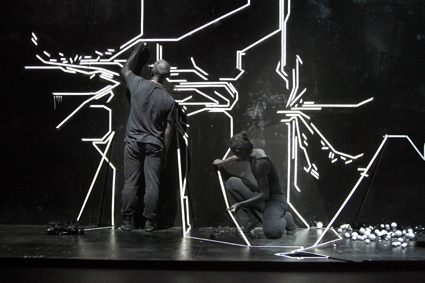
Antony Hamilton, Black Projects 1
photo Ponch Hawkes
Antony Hamilton, Black Projects 1
In the 25-minute excerpt category were Branch Nebula with Matt Prest and Clare Britton, Kage, Nicola Gunn, Maud Davey, Casus, Force Majeure, ILBIJERRI, Perth Theatre Company, Speak Percussion and the Darwin Festival Tiwi Islander work Wulamanayuwi and the Seven Pamanui. Among the 10-minute spruikers were Tristan Meecham, Tamara Saulwick, pvi collective, My Darling Patricia and Aphids, one step at a time like this, Jeff Stein and Chiara Guidi, Lucy Guerin Inc and Vicki Van Hout. Featured prominently in the program were site-specific works from Dan Koop & Co, Martyn Coutts and Sam Routledge and Lenine Bourke.
The variety of forms exhibited in APAM 2014 illustrate the market’s alertness to developments in the performing arts in line with the increasingly open-ended expectations among local and international festival directors, presenters and, above all, audiences about what constitutes the art experience.
An Australia Council press release (29, July, 2014) reported, “This year’s APAM attracted more than 600 delegates from 31 countries and included more than 70 showcases of exciting and innovative Australian performing arts productions. The previous APAM held in Adelaide in 2012 resulted in at least 20 domestic and international tours, generating more than $2.1 million in performance fees.”
Successful outcomes of APAM 2014 included Nicola Gunn’s Hello my name is and ILBIJERRI Theatre Company’s Jack Charles V The Crown in the Australian season at Dublin Theatre Festival 2014; Antony Hamilton’s Black Project 1 presented at Taipei Arts Festival 2014; and, forthcoming, pvi collective’s Deviator at Malmo Festival, Skanes Dansteater, Sweden, August 2015. Within Australia, Vicki Van Hout’s Long Grass premiered at the 2015 Sydney Festival before going on to Dance Massive and Force Majeure’s Never Did Me Any Harm will have a six-week, 10-venue tour in 2016.
APAM Roadshow information sessions occurred around the country in March-April.
To learn more about APAM and to see if it’s right for you, go to APAM Roadshow. Closing date for applications is 1 July.
2016 APAM, Australian Performing Arts Market, Powerhouse Brisbane, 22-26 Feb 2016; applications at www.performingartsmarket.com.au/apply
RealTime issue #126 April-May 2015 pg. 41
© Keith Gallasch; for permission to reproduce apply to realtime@realtimearts.net
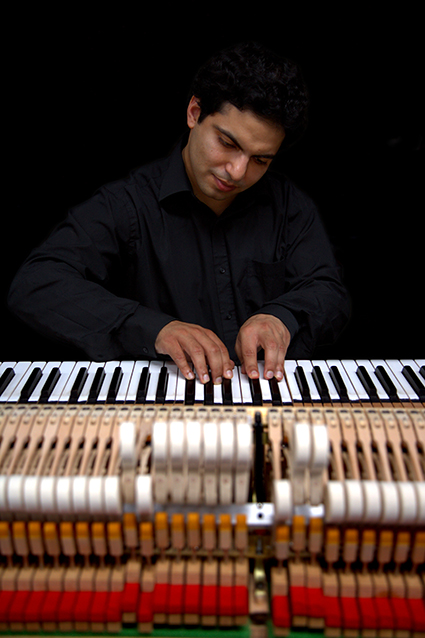
Zubin Kanga
photo Bridget Elliot and David Boyce
Zubin Kanga
The Melbourne Recital Centre’s Director of Programing, Kirsten Siddle, tells RealTime that the centre had been talking about a music-screen program for Metropolis for some time. While previous festivals might have focused on a theme or a composer, this one, centred on “music written for, and inspired by, the moving image, has given us a huge scope and supported commissioning because so many composers now are excited about collaborating with filmmakers.” The number of commissions and premieres, she says, is “pretty phenomenal” and great for audiences wanting to experience brand new works.
The 2015 Metropolis New Music Festival will feature music for the big screen in its Melbourne Symphony Orchestra program. In its seven Salon concerts a variety of forms true to our time will meld with music—film, video, computer gaming and a digital avatar. All the concerts, says Siddle, are about “the intersection between moving image and music—where music is absolutely integral to the moving image and, vice versa, where music is inspired by moving image.
The MSO program of three concerts includes Toru Takemitsu’s tribute to Andrei Tarkovsky’s Nostalghia, Tan Dun’s Crouching Tiger Concerto, New York composer Julia Wolfe’s multi-media collaboration with filmmaker Bill Morrison and the Australian premiere of Jonny Greenwood’s There Will Be Blood suite from the film directed by Paul Thomas Anderson (see Philip Brophy’s close reading of the score of Anderson’s new film, Inherent Vice). As well, Ben Walsh and the Orkestra of the Underground present a welcome return concert of their musical adaptation of Shaun Tan’s The Arrival, premiered in Melbourne in 2011.
The Salon concerts feature musicians and composers who were challenged by Metropolis, says Siddle, to respond to the relationship between music and image—with or without using projections. Participating are Speak Percussion (projections, suspended objects and electronics in a processional performance), Melbourne Piano Trio (video by Agatha Yim; film by Stan Brakhage), Syzygy Ensemble, Forest Collective (composer-animator Marcus Fjellström; dance-music film by Elanor Webber); pianists Zubin Kanga (playing through an avatar), and Lisa Moore (animation) and Ensemble Offspring (video by Andrew Wholley).
In some cases the artist is both composer and media artist. Forest Collective, says Siddle, will present “a fairly dark piece by Swedish composer and multimedia artist Marcus Fjellström based on the experience of growing up with cartoons and computer games.” Let Odboy and Erordog tempt you visually and aurally with its grim wit and fascinating score on YouTube. In her concert New York-based Australian pianist, Lisa Moore will perform a work by husband Martin Bresncik, For the Sexes: The Gates of Paradise, for solo piano and Puppetsweat Theater’s computer animations of William Blake’s drawings and illuminated manuscripts. Bresnick himself directed the film, its animations executed by Leslie Weinberg. Siddle declares Moore’s accompanying vocal delivery, sung and spoken, astonishing.
Kirsten Siddle is rightly proud of the large number of world premieres in The Salon concert season, including new compositions by Jeanette Little, Peter de Jager, Alexander Garsden, Christopher de Groot, Paul Dean, Alex Pozniak, Marc Yeats, Evan Lawson, Elanor Webber, Julian Day, Cat Hope, Daniel Blinkhorn and Chris Perren. There’s much to look forward to in the interplay of seeing and hearing in this distinctive festival. RT
Melbourne Recital Centre & Melbourne Symphony Orchestra, Metropolis New Music Festival 2015, Melbourne Recital Centre, 4-16 May
RealTime issue #126 April-May 2015 pg. 41
© RT ; for permission to reproduce apply to realtime@realtimearts.net
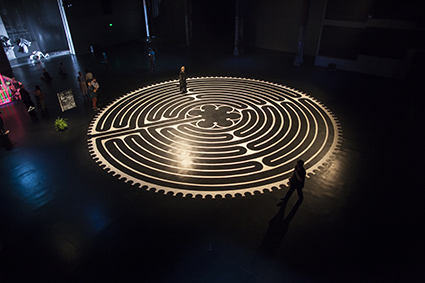
Nell, Labyrinth, Day for Night
photo Alex Davies
Nell, Labyrinth, Day for Night
This year’s Day For Night began at night. It was a better format, the Friday night and weekend ensuring a larger, more diverse audience. I spent many hours in the space, and as with last year, found the days a richer experience.
Part of the reason for this was that at the opening party nearly everybody succumbed to Friday-nightis: the wine flowed and flowed and flowed. Consistent with the bacchanalian tradition Day for Night draws upon, this may not matter. With plenty of day-trippers generous with their time and night owls happy to just get down and get out of it, Day for Night is filling its brief. The centrepiece, Nell’s labyrinth, promised to transform into a magical dance-floor but with the speakers up one end near the DJs, on opening night it got lost. During the day, its centrifugal force held. Mesmerising yet understated, it invited participation from young and old, or spectatorship if you arrived at a time when the artist herself was walking it in her painted robe, glacially, eyes barely open, to a soundtrack of a storm by Stereogamous.
Emma Maye Gibson/Betty Grumble and White Drummer
Around the labyrinth were five other performances, Emma Maye Gibson/Betty Grumble and White Drummer occupying diagonal corners for the duration of the event. The anchoring effect of these works was crucial, White Drummer pounding through the space, drowned out intermittently by the shorter performances. Approaching her room, you stood at a window and listened through headphones, the tracks she was playing along to obliterating her drums. Gibson’s post-punk juvenilia—posters, records and cassettes—was scattered around, including little paintings done at age fifteen. A single white bed hid in the far corner. It was a marvellous reconstruction of teenage fantasy, an antidote to girlish innocence—hermetic, claustrophobic, the disjunctions of sound taking us both inside her head and out to the world that had inspired her.
Gibson/Grumble’s petting zoo was a darker realm than the riot of colour suggested. From midday til eight the artist, as Betty Grumble, occupied a jumble of hay bales, costumes and overturned wheelie bin, with brief interludes as a zookeeper. You could sit inside and be petted, and I heard how much anger resided in her trademark clownish make-up and huge hair. A look so surface, it easily repels. The pathos became clearer on the final day when she danced a mad interpretive jazzercise for 10 minutes for the random Sunday crowd. Naked but for make-up, giant wig and penned in g-string, the hybrid of stripper moves and kickboxing seemed more rabid unleashing than rehearsed routine. Men who’d put their cameras up excitedly lowered them disconcertedly. You could hear the slap of flesh, gasping and groaning over the BeeGees “More Than a Woman.”
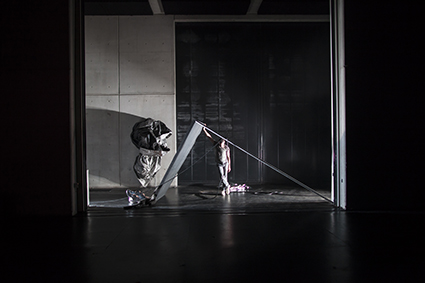
Matthew Day, (Untitled) Things That Matter, Day for Night
photo Alex Davies
Matthew Day, (Untitled) Things That Matter, Day for Night
Matthew Day
Matthew Day couldn’t have been a greater contrast, performing in white, grey then black. His athletic poses on the podium during the party were like classical statues, in hoodie. I’m sure I saw Rodin’s Thinker, but that may have been the wine. The following day, in a recess beyond the bay, Day was like an Anselm Kiefer come to life, grappling with tarp, chain, rubber hosing, a massive panel and a lead pipe. It was action art, object-based performance such as rarely seen here, though Day’s dance discipline was still the driving force.
Técha Noble
Técha Noble’s Party Body Rewind showed the legacy of her former time with the Kingpins with slick choreography and clever interplay of screened and actual performance. The three dancers’ entrance and movement through the party dancers in a giant black hide tufted with wigs, like a sort of Trojan horse, was a terrific moment. During the day, despite greater visibility, the beast had less impact. The dancers created a trompe l’oeil of a tiger’s face with their costumes, in moves minimal yet fiercely sexual, eventually revealing their faces, snarling and tough, ending with a thrilling, vigorous, African dance hall routine.
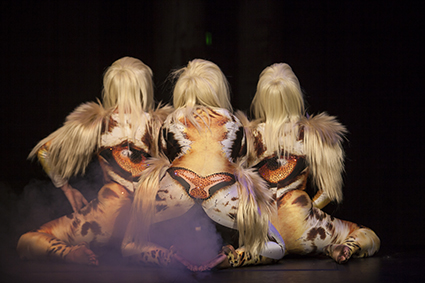
Técha Noble, Caroline Garcia, Rachel Melky, Party Body Rewind, Day for Night
photo Alex Davies
Técha Noble, Caroline Garcia, Rachel Melky, Party Body Rewind, Day for Night
Benji Ra
Dance was the strongest element of the event, Benji Ra’s Pioneers giving a local, idiosyncratic rendition of vogueing, dragging it from black America into Asian Australia. The dancers were riveting both as group and solo. At the party, the performance seemed narcissistic, tediously self-conscious with its semi-circle of mirrored screens, the dancers watching themselves, oblivious to us. But the veneer broke when you moved to the sides, the dance becoming both rehearsal and recital, extending to a great display of stamina and skill—the performance of life, its constant rehearsal in the digital age, porous to audience intervention. I hoped someone would enter and dance with them but their command was intense, their installation only infiltrated in their absence.
Children had a great time, as in Nell’s labyrinth. Their heightened responses enlivened the days. Opportunities for kids to access intensely embodied queer culture without fear or compromise are rare: may they continue.
Time, sound, limits
Yet again, the parts of Day for Night did not add up to a satisfying whole. The dance party has got to improve its sound. As I type, Stereogamous are coming out of my laptop more clearly than they did that night. As soon as the room fills, the sound muffles, affecting visuals as well in the clustering of the crowd to hear better. Is the space too big, the expense too great? Are there noise limits? Yet Ryoji Ikeda’s Test Pattern two years ago in an even bigger Bay was cacophonous. And as good as all the individual works were, sometimes even great, it wasn’t risky and edgy as co-curator Jeff Kahn had promised in his opening speech. There was barely a glimmer of politics. Duration, central to the event, did not determine most of the performances. Time was not submitted to. There is still the sense that the curatorial vision is led predominantly by aesthetics, the aim for a refined finish and sealed piece that can punch the clock. That certainly makes it easier to time your entrance to ‘catch the show.’ Instead, why not catch us unawares? Work us harder: we can take it.
Performance Space have a guarantee from Mardi Gras and Carriageworks to go ahead with the event next year. What a tremendous luxury, to cogitate for a whole year on the next curatorial adventure. May the next Day for Night leap the bar.
Day For Night, curators Emma Price, Jeff Khan; presenters Performance Space, Carriageworks, Sydney Gay and Lesbian Mardi Gras; Carriageworks, Sydney 20-22 Feb
RealTime issue #126 April-May 2015 pg. 34
© Fiona McGregor; for permission to reproduce apply to realtime@realtimearts.net
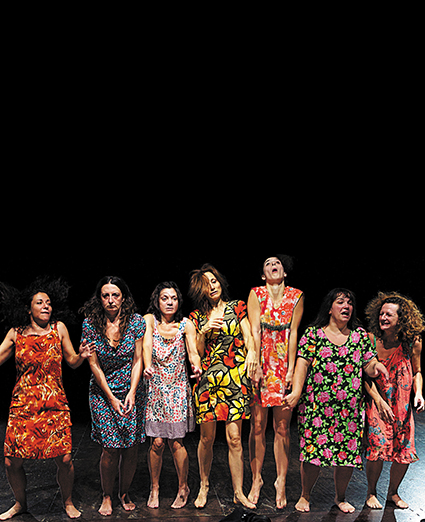
Le sorelle Macaluso, Théâtre National
photo Clarissa Capellani
Le sorelle Macaluso, Théâtre National
One of the great pleasures of Brussels is being able to see visiting theatre companies from all over Europe. An average week will present a treasure trove of international productions, highly regarded in their homeland, brought in often very modestly, for two- to three-day guest seasons. Sponsored by an overlapping patchwork of European, national, regional and thematic programs, they are variously framed—sometimes as art, but sometimes merely as a showcase of a nation.
It takes a particular kind of exploratory spirit to seek them out: one not only accustomed to the dingy corridors of independent warehouse spaces, but one not intimidated by the scent of bureaucracy. Alvis Hermanis’ exquisite Sonja, for example, was presented “with the support and in the framework of the Latvian Presidency of the Council of the European Union” in the basement space of BOZAR, Brussels’ museum of contemporary art.
Similarly, I had not heard much about Emma Dante before seeing Le sorelle Macaluso at Cities on stage, but I am glad I decided to indulge my curiosity. The Villes en scène/Cities on stage project, initiated by the Brussels Théâtre National with backing from the European Commission, brings together seven European theatres and festivals: Théâtre National in Brussels, Folkteatern in Gothenburg, Odéon-Théâtre de l’Europe in Paris, Teatrul National Radu Stanca in Sibiu, Teatro Stabile di Napoli, Teatro de La Abadía in Madrid and the Avignon Festival—on the theme of living together in the city.
I have seen much more formally adventurous performances in the same period, doing the rounds of the said warehouses, but these works of theatre—undeniably, theatre—have stayed with me for their emotional weight, which felt ancient and primal.
Emma Dante, Le sorelle Macaluso
Emma Dante, like many other Italian theatre artists, remains much more prominent in her homeland than internationally, due in no small measure to the egregiously poor level of theatre funding in Italy. Her company, Compagnia Sud Costa Occidentale, is entirely unsubsidised, but nonetheless operates as a research laboratory for movement and performance, in the vein of Grotowski and Kantor. The influence of these greats is undeniable, visible in Dante’s creation of a ritualistic narrative space beyond mortal life, but also in her interest in how social ritual creates patterns in the body and voice, and in sculpting a performative presence that has full control over social resonances of movement. Like Compagnia Pippo Delbono, MOTUS and Societas Raffaello Sanzio, Emma Dante’s theatre sits firmly in the sensuous, visually and corporeally luscious Italian avant-garde tradition of ‘teatro totale,’ with strong links to the philosophies of Artaud, Pirandello, Grotowski and an affinity to the emotional and formal depth of Fellini (of whom Dante says, “his poetics is the utopia I am searching for in theatre”).
Thematically, Le sorelle Macaluso, like other of Dante’s work, is concerned with family, religion, Mafia, poverty, hopelessness and death—the sociopolitics of Sicily. The stage opens as an abstract space without the back edge, just a dark fog from which first a dancing woman and then a funeral procession, emerge. The funeral becomes a danse macabre, and finally a chorus line of women in floral dresses: the sisters Macaluso have come to bury someone. In this liminal space beyond time, sisters bicker and burp and laugh; other family members appear and disappear; generations meet in dialogue, and joys and sorrows trigger one another as memories emerge. Amid a great deal of suffering, we are waiting to find out not who has died, but whether anyone is still living.
This production is a result of two years of laboratory work, visible in the controlled physical poetry of gesture and voice (the entire text is delivered in Sicilian dialect, its rhythms resonating through bodies). There is clowning, bodily fluids, profound emotional expression and structured choreography. It is rare to see this kind of movement depth on stage these days outside of dance, and it triggered an immense emotional response in the audience. Emma Dante is a revelation.
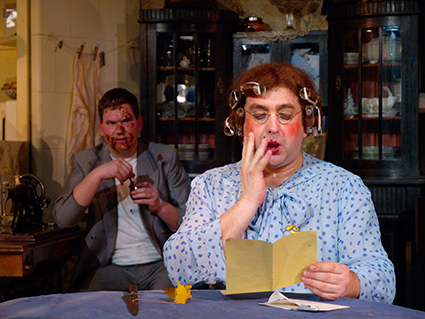
Sonja, Bozar Theatre
photo courtesy Bozar Theatre
Sonja, Bozar Theatre
Alvis Hermanis, Sonja
Alvis Hermanis’ Sonja owes its success to the same principles, as much as it may appear radically different on the surface. Sonja, a simple two-hander based on a short story by Tolstoy’s granddaughter Tatiana Tolstaya, has been a big hit on the European theatre circuit since 2008.
Tolstaya’s story follows a dumb, good-hearted St Petersburg spinster tricked by friends into believing a secret admirer is sending her love letters. The charade persists for decades, and is only cut short by the siege during World War II, which kills most of the letter-writers.
Hermanis likes to play with different levels of reality: Sonja opens with two bulky-framed burglars breaking into an empty apartment, obviously belonging to a deceased woman. While Jevgenijs Isajevs sits down and, as if hypnotised, starts narrating the story of Sonja, Gundars ?bolinš transforms into Sonja herself, and for the next hour activates every room of the apartment—even baking a cake—only to then take off his costume, finish the looting and disappear.
Germany and Russia are two great opposing forces in Latvian culture. In theatre, the rigorous German intellectualisation of performance refracts through the Russian approach which valorises acting, emotion and is, in Hermanis’ words, “more trashy and messy than the German tradition.” Sonja, for all its intellectual games of representation and make-believe, is primarily fascinating for its contradictory emotional power. Melodrama, physical comedy, mime and Stanislavskian naturalism clash in the incredible performance by ?bolinš, who portrays Sonja simultaneously as a caricature and with utmost respect, expanding her into the representation of all the cosmic illusions of humanity. Building naturalistic physical expressions of an old woman from a very large masculine body, every socially marked gesture is de-naturalised and consciously re-inserted. It happens with precision, without ridicule. And yet, the offensive bawdiness of this casting decision is never forgotten—Sonja remains grounded in a village burlesque. Just as Tolstaya’s narrator lends dignity to Sonja while being entirely uncompromising about the extent of her daftness, Hermanis gives gravitas to a very coarse drag act.
Both Dante and Hermanis are considered uncompromisingly avant-garde, and yet both have developed a practice grounded unashamedly in folk art. Spending too much time in perfectly white warehouses it is sometimes easy to forget how closely related theatre is to storytelling and ritual. Sonja and Le sorelle Macaluso, although coming from two opposite ends of Europe and funded partly for political reasons, were a welcome reminder of this.
Le sorelle Macaluso, text, direction, costumes Emma Dante, lighting Cristian Zucaro, set design Gaetano Lo Monaco Celano, Théâtre National, 24-27 Feb; Sonja, text by Tatiana Tolstaya, director Alvis Hermanis, design Kristine Jurjane, sound engineer Andris Jarans, lighting Arturs Skujins-Meijins, BOZAR, Brussels, 13-14 Feb
RealTime issue #126 April-May 2015 pg. 35
© Jana Perkovic; for permission to reproduce apply to realtime@realtimearts.net
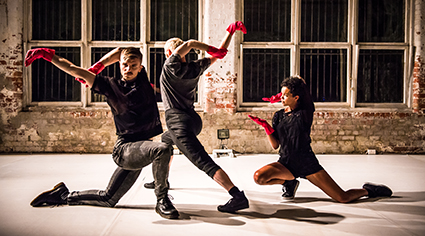
James Welsby, Benjamin Hancock and Chafia Brooks, HEX
photo Gregory Lorenzutti
James Welsby, Benjamin Hancock and Chafia Brooks, HEX
By my reckoning, it’s been over a decade since Brisbane had a dedicated queer performance festival. Now MELT is here, curated queer performance is back and while many of us are sorry to see the wonderful World Theatre Festival drop off the Powerhouse’s program—this is the February slot WTF used to occupy—MELT’s arrival is entirely welcome.
One of my most vivid recollections of the early 2000s queer performance seasons at the Powerhouse is the overwhelming dominance of ‘coming out’ narratives in the one-person confessional performance paradigm—‘wide eyed country boy goes to big city and discovers clubbing/drugs/sex scene’ was such an oft-repeated synopsis as to become its own genre. As it turns out, three of the four shows I got to see this time meet the one-person-show confessional template.
Matthew Mitcham, Twists and Turns
Matthew Mitcham’s Twists and Turns follows the champion diver’s life from a childhood in suburban Brisbane—or as Mitcham archly points out, “Dorothy Street, Camp Hill, Queen’s land? Come on!”—to the Beijing and London Olympics via Sydney’s gay club scene. Mitcham’s broad biographical narrative trajectory is already familiar to most of the audience. There were few revelations to be had in a candid song-and-commentary piece that was, to be frank, fairly heavy on therapy-speak-as-dialogue, an approach which had the effect at times of reducing a compelling and unique ‘journey’ to cliché. The self-penned songs revealing the torment beneath the success that the world witnessed were encumbered by the same linguistic blandness, but Mitcham’s stage presence was very warm, and the real revelation of the evening was his singing voice. It makes sense that a professional diver and trampolinist should possess innate choreographic or musical timing and discipline, and the one truly beautiful transformational moment of the evening was indeed that Olympic dive, recalled on stage in slow motion choreo, with Mitcham singing Nick Cave’s “Little Water Song.” Jeremy Brennan’s musical direction was lovely and the onstage presence of Rhys Morgan as a bitchy drag queen personification of Mitcham’s self-sabotaging alter ego was worth a go, but only worked humorously in moments.
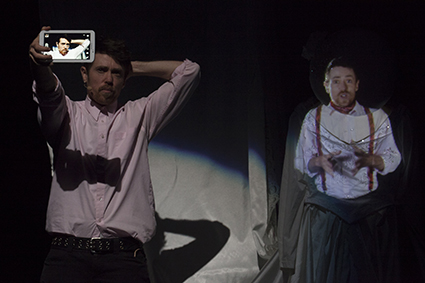
Sunny Drake, Transgender Seeking
photo Hilary Green
Sunny Drake, Transgender Seeking
Sunny Drake, Transgender Seeking
Sunny Drake’s Transgender Seeking was an altogether more theatrically sophisticated and accomplished one-person confessional, and was well supported by a robust and vocal lesbian, queer and trans audience. Stage design comprised a single white chair in front of a large cloth-draped puppet—a bride—onto whose dress were screened excerpts from romantic Hollywood films. The theatrical conceit is that we are at a romance-aholics meeting with ‘Jimmy’ (who refers to Drake as his ‘sponsor’). Despite an over-choreographed monologue or two at the beginning with Jimmy’s blustering late arrival—he performs a series of S&M sexual positions on the chair while telling us why he’s here and how hopeless a romantic he really is—the piece soon settles into a riveting meeting-cum-therapy session during which Jimmy engages in virtual dialogue interface with Drake via the bride puppet videography. It’s a technically savvy performance, raw and revealing and humorous in its depiction of Jimmy’s online dating quandaries—the impossibility of ticking conventional boxes—and the difficulties inherent in maintaining poly-partnered open relationships in the modern world. Jimmy appears with significant ex Brian in a gay reality TV show (The Games We Play), negotiates a dystopic queer political world via an encounter with the Queer Radical Relationship Act and wrestles with the dilemmas of being an Ethical Slut. Transgender Seeking is touring the nation in venues stretching from Launceston to Cairns, and will allure, confront and inform audiences every step of the way.
Dash Kruck, I Should Take My Shirt Off
The third in the troika of one-man confessionals I attended was local actor-singer Dash Kruck’s I Should Take My Shirt Off. Kruck plays a hapless, nervous ingénue, Lionel, who has just had his heart broken and has been instructed by his overbearing German therapist Griselda to use cabaret as a means of catharsis. The theatrical premise, then, is that this is a cabaret about producing a cabaret with titles like “How Do You Start a Show?” navigating character and audience alike through an evening of DIY entertainment. Lionel is trying to rebuild his confidence and find love again—trying to get to the point where he can take his shirt off, metaphorically and literally, in public. Despite the slightness of the dramatic premise, Kruck’s acting experience and charm are enough to sustain the piece. The TV series Glee has possibly influenced the final sections of the piece too heavily: “Here I am: this is me” as a finale dips the piece into the same kitschy, anodyne therapy speak already discussed. But overall, this was a show that won over a clearly appreciative local audience.
James Welsby, Hex
Hex, choreographed by James Welsby, riffs on the central question, “What does the AIDS crisis mean for people born after 1981?” This smart, funky contemporary dance piece is more overtly political than the other shows I saw and takes us immediately back to the moment AIDS ‘broke’ in the minds of the Australian public via a wry re-enactment of that iconic Grim Reaper ad. Accompanied by a sour, mutated version of the relentlessly preppy “Everything Old is New Again,” we see the young people in that ad (depicted by fellow dancers Benjamin Hancock and Chafia Brooks) transmogrify into young clubbers of the era, joined by Grim Reaper/Welsby himself. The whimsy and carelessness of pre-AIDS clubbing is represented by a tightly choreographed unison routine that puts one in mind of a Jane Fonda or Richard Simmons workout. The sequence is extended to the point of exhaustion and we gradually find jubilation turning sinister. As the disease stalks and strikes the gay community whose culture is being referenced in these early sequences, funk gives over to Gregorian chanting that intensifies in pitch to a point of collapse. Suddenly the dancefloor is strewn with torpid bodies and we could be in the living room floor of a junkies’ share house. We move from sickness to death to political protest rally via a wonderfully inventive scene that uses pink latex gloves as balloons to mark the graves of the fallen, and arrive finally at survival and triumph—a finale, a ‘one in your eye’ to the Grim Reaper with Piaf’s “Je ne regrette rien,” which I won’t spoil by describing. Let’s just say that memories of Piaf’s vibrato may never recover from this rendering. While the pop accompaniments to the dance sequences sometime spell things out to the nth degree (“Another One Bites the Dust” being a clunky case in point), this is clever, spirited, compelling contemporary dance. I enjoyed the dramaturgical clarity and rigour of the work every bit as much as I’ve enjoyed DV8 or Chunky Move performances in the past. Hex is excellent and Welsby’s company has a great future.
Melt: A Celebration of Queer Arts and Culture: Matthew Mitcham Twists and Turns, director Nigel Turner-Carroll, musical director Jeremy Brennan. 5-6 Feb; 2015, Brisbane Powerhouse; Transgender Seeking, writer-performer Sunny Drake, director Gein Wong, 8 Feb; I Might Take My Shirt Off, writer-performer Dash Kruck, composer Chris Warren, director Emily Gilholme, 13-14 Feb; Hex choreographer James Welsby, performers James Welsby, Benjamin Hancock, Chafia Brooks, 8 Feb, 2015; MELT Brisbane Powerhouse, 5-15 Feb
RealTime issue #126 April-May 2015 pg. 33
© Stephen Carleton; for permission to reproduce apply to realtime@realtimearts.net
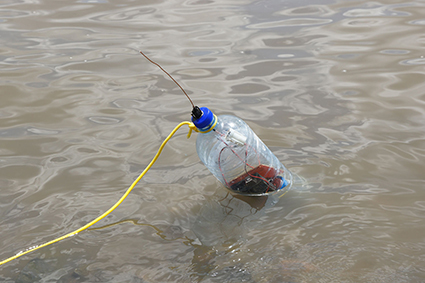
From Landung in Australien, an exploration of refugee and asylum seeker policies presented by QUT Creative Industries Precinct and Christoph Wachter & Mathias Jud as part of Move On:European Media Artists in Residence Exchange
Three reports, two months, one message: our detention centres cannot stand.
On 15 February, the government tabled the Australian Human Rights Commission’s Forgotten Children report. The horrific details include women deciding to terminate pregnancies rather than raise their babies in detention, infants saying ‘officer’ as one of their first words, toddlers learning to walk in areas infested with crabs that have “claws strong enough to remove a human toe with ease,” children being toilet-trained in bathrooms flooded with urine and faeces, teenagers self-harming on numerous occasions, one being revived after a suicide attempt, mothers cutting themselves with broken plates and attempting to suffocate themselves with plastic bags, a profoundly deaf family living without hearing aids for over six months meaning that they were completely cut off from everyone in the centre, and detainees being called by number rather than by name, 14 years after the Flood Report condemned the practice. In short, conditions are the worst they have ever been.
But none of this got any attention because the government was too busy attacking, and the media too busy defending, the AHRC’s President, Professor Gillian Triggs. Two weeks later, the same pattern of independent report, government reply, media reproach and public indifference replayed itself in response to Juan Mendez, the UN Special Rapporteur on Torture. Meanwhile, the government sat on the Moss Report into Recent Allegations Relating to the Conditions and Circumstances at the Regional Processing Centre in Nauru, finally releasing it on 20 March. Unlike Triggs, Moss was able to visit Nauru and did so twice, interviewing detainees as well as staff. It is arguably the most detailed and most damning of the three documents, confirming reports of physical and sexual assault, rape and corruption. Yet still, silence.
These reports and their receptions have become performances, which is not to say that they are false—far from it, they are lethal and they are real. Rather it is to say they have become social scripts or cultural rituals through which we enact our grief, guilt and ultimately apathy. For what are we to do?
For policy makers, the difficulty is that Australia has had two periods of minimal boat arrivals and they have almost nothing in common. The period from 1981-92 was underpinned by strong regional cooperation, first through the Orderly Departure Program and then the Comprehensive Plan of Action, and the policies of mandatory detention, interdiction, excision and the like were unheard of. By contrast, the period from 2002-08 was underpinned by the Pacific Solution, which relied precisely on those policies as well as offshore processing and temporary protection visas. Currently, we seem to have a nightmarish ‘solution’ that combines the worst of both worlds, by effectively regionalising the dirty work of detention and outsourcing the difficult work of resettlement to the nations least equipped to deal with it.
For artists, the problem is two-fold. When more than 12,000 asylum seekers arrived by boat in the period from the beginning of 1999 to the end of 2001 (the so-called ‘fourth wave’), artists responded almost immediately. In the wake of the Tampa incident, the Pacific Solution, the Children Overboard election and the sinking of the SIEV X, these responses increased exponentially. There were scores of novels, poems, plays, performances, installations, films, painting and photographs (see our archive). In 2008, when the then Minister for Immigration Chris Evans announced that the Labor Party would seek to wind back the worst of the Pacific Solution, there was a sense of pride among the artistic and activist communities: together, their many ‘moments of resistance’ had contributed to a ‘movement of resistance’ (the phrase is Pierre Bourdieu’s) and that movement had effected real change. This now seems embarrassingly optimistic: Evans has left politics, politics has gone right, and policy has gone wrong.
Far from succeeding, then, artists and activists have failed. Even worse, many of their aesthetic strategies have been recuperated and repurposed by the government. The Department of Immigration and Border Protection’s No to People Smuggling channel on YouTube features several videos, one of which looks strikingly like the last scene of version 1.0’s CMI (A Certain Maritime Incident); and another that looks and sounds like verbatim theatre. Never mind the comic books distributed last year (The Guardian, 11 Feb, 2014).
The issue for artists this time around is not how to humanise the dehumanised, but how to intervene in a visual culture where art now functions as a weapon against the very people art sought and still seeks to support. One option is to withdraw, as happened with the Sydney Biennale last year, but it can’t be the only one and I examine some recent responses in the following pages.
For asylum seekers, the problems are multiple and multiplying. For the fifth wave, ie those refugees who have arrived since 2009, it is clear that the Enhanced Screening Process has probably sent people to their deaths and that Regional Processing has definitely done so. Indeed, Monash University’s Australian Border Deaths database puts the number of people who have died since 1 January 2000 as a result of our border policies at 1,969 in total. Not that surviving is necessarily easy, especially for those who arrived at the turn of the 21st century. Young adults who were then 18 are 33 now; Shayan Badraie, the tiny boy who appeared mute and traumatised on our TV screens in 2001, is probably about 20 now and possibly on one of our campuses. How devastating must it be to hear this ugly debate again, but this time as a permanent resident or naturalised citizen? It is no surprise that former refugees are doing some of the most innovative advocacy, for example RISE (Refugees, Survivors and Ex-Detainees; tag line “Nothing about us without us”) and some of the most interesting artwork, for instance Sha Sarwari’s installations and photographs (see this issues cover image). The next step will be for them to write reviews such as those that follow on these pages.
And what of Australians, whether natural-born or naturalised, who watch on with a mixture of fatigue and fatalism? For my part, I have drafted an apology to survivors of immigration detention to be delivered by the Australian Prime Minister at the time of her choosing. It’s not enough of course, but it reminds me what the finish line might look like. The task now is to plot a path from here to there. And you, what will you do?
————
A Draft Apology to the Survivors of Immigration Detention
RealTime issue #126 April-May 2015 pg. 3
© Caroline Wake; for permission to reproduce apply to realtime@realtimearts.net
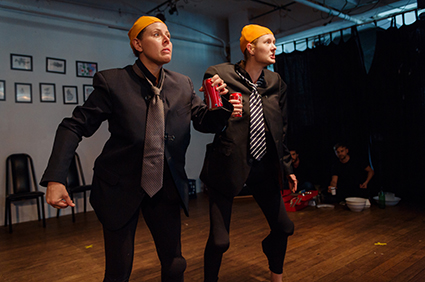
Emily Ayoub, Madeleine Baghurst, Bathers on the Sand
photo Robert Catto
Emily Ayoub, Madeleine Baghurst, Bathers on the Sand
Curated and produced by Apocalypse Theatre Company, the Asylum season played for 12 nights over two weeks at the Old 505 Theatre in Sydney’s Surry Hills. There were five programs, each of which included four to six plays, 29 in total. The majority were staged readings, so the emphasis was on content rather than casting, acting, costumes or scenography. I have attempted to identify genres, trends and tendencies across the entire season.
Documents as theatre
As in the theatre of the fourth wave, there was a strong documentary element in several of the plays. Perhaps the purest example of this was Hilary Bell’s Flying Fish Cove, based “entirely on the words of witnesses” to the 2010 Christmas Island tragedy. It was as distressing as one would expect and all the more effective for being staged without the footage that has become so familiar. Ross Mueller’s Dark Angels was billed as a “dramatisation of [an] interview” he conducted with Richard Marles, the Shadow Minister for Immigration and Border Protection, so it’s not entirely clear how documentative it is. But it neatly conveys Labor’s stammering incoherence on asylum seekers, as Marles opines that this area of policy is “a really tricky space.” Yes indeed, sir—due in no small measure to your own party’s actions.
To hear Marles rehearse the so-called “drownings argument,” which states that we have to turn back boats and detain asylum seekers in order to save them from themselves, is almost too much. If international law and due process—to say nothing of ethics—were really at the heart of Marles’ deliberations, they wouldn’t sound like this.
Then there is Gol Pari by Amir Mohammadi, which is not a documentary play per se but nonetheless functions as a document, which is to say as evidence of the type of play that can and did cause him to flee Afghanistan. Mohammadi appears in person to introduce and perform in the play, which has only just been translated. It tells the story of three women who are married to the same man; the older two wives conspire to accuse the youngest wife of infidelity, among other things. In the end, she is forced to have an abortion and then stoned. Intended to inspire rebellion, Gol Pari also reads—like many western fairytales—as a brutal warning to women to behave or else. I find myself wondering how the women in the original audience received it: did they really need reminding of their fate or did the illicit thrill of attending the theatre override everything else? That I can ask this points to the immense cultural gap this play attempts to bridge.
Christopher Bryant’s 63 Days which deals with a hunger strike, also has documentary elements, citing comments from message boards as well as extracts from the Refugee Convention. This staging strategy is recognisable from myriad performances about the fourth wave of refugees, but reading from legal documents no longer seems enough, if indeed it ever was. Cybele McNeil’s Day 48 is also about a hunger strike: the striker himself is silent while the staff around him speak in endless slogans and jargon.
Representing hunger
To represent a hunger strike in the theatre poses several problems, which these plays have yet to solve. First, there is the problem that hungry bodies would never be able to undertake the labour of acting or even not-acting, in performance theorist Michael Kirby’s sense of the term, on stage. Second, there is the problem of duration: hunger strikes unfold over days, weeks and months. In other words, having a fit young actor lying limply on the floor for a few minutes doesn’t really do it. I suspect writers and directors need to become either more literal or more lateral: more literal in the sense that they might actually undertake hunger strikes, as performance artist Mike Parr did for 10 days in Water from the Mouth (2001; see RT 44, p29; RT120, p5) and as activists did in February this year in the Hunger for Justice solidarity hunger strike. Or, they could become more lateral in the sense that hunger strikes are rarely about hunger, but rather about staging one’s own disappearance or disintegration. Recall Shahin Shafaei’s solo performance Refugitive (2002-4) in which the hunger striker’s stomach almost becomes a separate character. I’m desperate for someone to wear a mask and slowly break it off their face before eating it or to outline a body on the floor with a paste made out of blood and phosphate dust from Nauru—anything besides actors pretending to languish on stretchers.
On the inside
Several other plays are also set in detention centres, including Laura Lethlean’s Where the Breath Is Kept, which takes place in a solitary confinement cell in the wake of an asylum seeker’s suicide attempt. The female night cleaner and the male centre manager converse while waiting for another staff member to help them write the incident report. The dialogue reveals that she is local to the island and glad to be employed at all whereas he’s a family man far from home, doing it for the inflated salary. The play raises issues of class and gender and, more significantly, differential degrees of complicity. Does the impoverished citizen of a Melanesian or Micronesian island bear the same degree of responsibility as the wealthy public servant from Canberra, even though only the former literally gets her hands dirty? Lethlean doesn’t think so.
I Could Be You, by Hoa Pham, takes place in a detention centre haunted by a character I initially took to be a reference to Cornelia Rau (unlawfully detained under the Government’s Mandatory Detention program, 2004-5) but who turns out to be a woman who migrated from Germany to Australia half a century ago. One of the detainees is a foreign-born, Australian-bred criminal, who is awaiting deportation back to his country of birth, recalling Zeki Togan, the protagonist in Linda Jaivin’s novel The Infernal Optimist (2006) as well as the real life cases of Robert Jovicic, Stefan Nystrom and others.
Two plays are set not in detention but in the offices where interviews are conducted and life and death decisions made. In The Complete Guide, by Ruth Melville, a father and son memorise a handbook about Australia in order to pass the refugee determination process. In Project 949, by Victoria Haralabidou, two UN representatives arrive on an island; it turns out one is investigating the other. It’s structured like a thriller, an unusual genre in this field.
In Michele Lee’s Untitled, two girls befriend each other in detention; in the second act, two young women explain why they vote for the Greens. They may or may not be the same pair; I overheard different theories in the foyer. Irene Assumpter’s Fitting into Wageni contrasts the fates of those who arrive as asylum seekers with those who arrive as educated migrants: the suggestion is that this is how class differences at home are allowed to reproduce themselves in Australia.
In the community
In addition to these plays set inside the immigration system, several were set outside in the community. In Nil By Sea, by Katie Pollock, an asylum seeker falls from the sky into a suburban street. The neighbours gather around his shattered body, speculating on his origins and motivations and slowly revealing their own. Steven McCall’s Safekeeping takes us from the city to the country, where a farmer and his daughter find an asylum seeker hiding in their shed and force her to labour on their property for two years. It’s a strange miniaturisation of Australia’s political actions, yet also an inversion, seeing as we have now outsourced the work of detention.
Physical theatre and fable
Two other plays take a more oblique approach to the topic. Devised by Emily Ayoub, Madeline Baghurst, Jack Murray and Ben Pierpoint, Bathers on the Sand is the only physical theatre work in the season. It stands out for the skill of its clowns (the two women), its live soundtrack (the two men) and its gentle humour. The antics of the clowns reveal that we are all ‘other’ when surrounded by sand and faced with infinite water. In Elias Jamieson Brown’s Missy and Her Master (A Fable), the ‘other’ is a domestic shorthaired cat who suddenly tires of the ‘domestic’ bit and goes on the prowl. Tom Conroy is the lithe and insolent Missy, while Camilla Ah Kin is her increasingly frantic master.
Solo voices & puppet
There are also several monologues. In Melita Rowston’s Bread and Butter, a refugee from Afghanistan reflects on her life while kneading dough. Despite a charming performance from Josipa Draisma, the metaphor becomes laboured and the play too sentimental about the “plight of the migrant,” recalling Canadian writer Julie Salverson’s critique that the genre often portrays refugees as “exoticized and deliberately tragic others.”
Less problematic works included Noëlle Janaczewska’s very brief Meena, in which an asylum seeker’s mother waits and frets for her son. In Tasnim Hossain’s Why We Run, a Palestinian-Syrian refugee gives a pep talk to an Australian aid worker before they embark on a charity race across the desert. Most interesting is its insistent use of the second-person, which due to the ambivalence of the English “you” always already includes the audience in its address. Sheila Pham’s These People shares a title with Ben Ellis’ 2003 play about children in detention, but that’s where the similarities end. Pham’s monologue features a former refugee from Vietnam complaining about the new arrivals. It’s ironic and discomfiting, but as in the case of Bryant’s play, I’m not entirely sure what is to be gained by rehearsing the opinions of the intolerant.
In Eleanor Rex’s A Confession, a woman gives an account of her experience of working in Villawood Detention Centre. It does not claim documentary status as explicitly as Bell or Mueller’s plays, but the program does claim “honesty, rawness, and vulnerability.” Sadly, the figure of the troubled former detention centre worker is a familiar one, having appeared in plays such as Citizen X (2002), These People (2003) and Through the Wire (2004). The workers speak for themselves in television programs such as ABCTV Four Corners’ The Guards’ Story (2008) and have penned books like The Undesirables (2014). If nothing else, the confessional genre proves that these policies are damaging Australians as well as asylum seekers.
Far less familiar is Georgia Symon’s monologue, A Puppet Show for All Ages, in which an actor is taken over by the character of an asylum seeker. Zeniah is absolutely delighted to have arrived in someone else’s body, on stage no less, and proceeds to make the most of it; the actor reappears in brief moments of struggle, but for the most part Zeniah has the upper hand. The only false note in this performance comes when Zeniah threatens to make the actor stitch her lips; a threat we know will not be carried out. Overall, however, this was a fascinating play and there is much more to be explored when it comes to the parallels between acting and hosting another’s body.
Ironic laughter
In Mary Rachel Brown’s monologue Self-Service, a middle-aged woman named Pamela talks about having to train Abdul-Rasheed, a refugee from Afghanistan, to work in her deli. In a twist on the usual ‘I’m not a racist but,’ Pamela insists “I’m not like those people on YouTube that lose their shit on public transport. You would never pick it if you saw me in the deli. I’m all smiles. Surrounded by kids from all over the world. No one has ever called me a racist.” In other words, ‘I am a racist but I usually bother to disguise it a little bit.’ It’s a pretty apt metaphor for our migration policies as a whole, not to mention a very funny performance by Jan Barr, delivered while devouring a Mars bar. There is also sly humour in Paul Gilchrist’s The Danger of Safety, in which an older woman reminisces about her own migration from England. The issue of how migrants who enjoy racial privilege relate to those who do not deserves further exploration.
Two other plays stand out for their use of comedy, a genre often absent from the fourth wave. The first is Noëlle Janaczewska’s Go for Gold, in which Australia is competing in some kind of Olympics of cruelty. It reminded me of John Clarke’s The Tournament, where he cast politicians in a fictional tennis championship. In Go for Gold, the US is the obvious favourite for waterboarding, but Australia is way out in front when it comes to mistreating asylum seekers. The second play is Tania Cañas’ Three Angry Australians, which takes place in the office of a non-government organisation. The three workers gleefully get stuck into the ineffective protestors outside, the artists who contact them wanting to be introduced to refugees so that they can make a work about them or, better yet, who want to collaborate with refugees by giving them cameras, so that they can do the bulk of the work and the artist can be praised for her inclusive vision and practice. They talk tough, tweet Brecht and completely skewer the delusions of those who would ‘give’ a voice to those who actually have their own but who aren’t being heard.
Overall, the Asylum season is interesting for the diversity of both its authors and actors; the names and faces are far more varied than those seen in most mainstream productions. The plays themselves are at their best when exploring less common genres and modes such as comedy, puppetry, physical theatre and the thriller. They are less interesting when rehearsing old tropes and habits. Indeed, it is frustrating that some writers have not researched previous works made by, with and about refugees and so repeat approaches that no longer have impact. Nevertheless, Asylum was well-warranted—97 artists were involved in total and all profits went to the Asylum Seeker Resource Centre in Melbourne and the Asylum Seekers Centre in Sydney—and Dino Dimitriadis deserves praise for his vision and organisation.
Apocalypse Theatre Company, Asylum, Old 505 Theatre, Sydney, 3-15 Feb, 2015
RealTime issue #126 April-May 2015 pg. 4-5
© Caroline Wake; for permission to reproduce apply to realtime@realtimearts.net
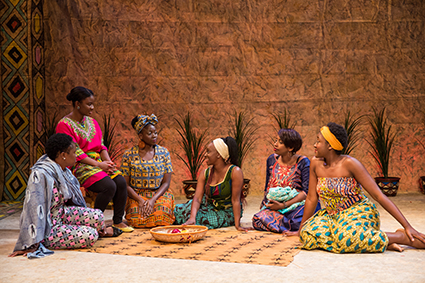
Baulkham Hills African Ladies Troupe
photo Daniel Boud
Baulkham Hills African Ladies Troupe
Baulkham Hills African Ladies Troupe displays the hallmarks of careful and collaborative development over three years with director Ros Horin in the performances of the four courageous women at its centre—Yarrie Bangura, Aminata Conteh-Biger, Yordanos Haile-Michael and Rosemary Kariuki-Fyfe. The production has just completed its journey from Parramatta Riverside, where it began in 2013 via Belvoir who also invested, to a successful tour to Nottingham and Southbank in London and a Sydney Opera House season. A documentary film is in the offing.
Along with the subjects, the work calls on the talents of three skilled performers—Nancy Denis, Imat Akelo-Opio and Effie Nkrumah—and singer/songwriter Aminata Doumbia who share the performative weight, introducing lightness where it’s needed and importantly, acting as companion narrators for each of the women as they recount horrific details of lives rent by traumatic events in Guinea, Sierra Leone, Kenya, Eritrea. Playful elements that temper the tough material include an audience quiz revealing how little most of us know about Africa. The design team creates a world of vivid colour with more positive reminders of home, which also functions as a place where testimonies of lost childhood, rape and murder can be shared, language found to describe abuse that is so commonplace in some societies —and by no means confined to the African continent—that no words exist to even discuss it. Not always comfortable, shifts in mood and tempo in the work no doubt reflect the refusal of these women to allow their traumatic experiences to define them.
There’s great joy in this work but sadness is ever present such that the rallying cry at the end of the production seems barely necessary, so strongly is the message conveyed in the gracious presence of these women and the intimacy of their telling. While it appears their own resettlement in Australia has been relatively untroubled, these women’s stories remind us yet again of the sheer desperation that forces a rapidly increasing proportion of the world’s population (exceeding 50 million according to the UNHCR in 2014) to flee their homes and endure perilous journeys, often with no idea what or who, if anyone, will greet them when they arrive, if they ever do, wherever it is they are heading.
Baulkham Hills African Ladies Troupe, director, writer Ros Horin in collaboration with Yarrie Bangura, Aminata Conteh-Biger, Yordanos Haile-Michael and Rosemary Kariuki-Fyfe, designer Dan Potra, costumes Emma Kingsbury; The Studio, Sydney Opera House, 26-29 March.
RealTime issue #126 April-May 2015 pg. 5
© Virginia Baxter; for permission to reproduce apply to realtime@realtimearts.net
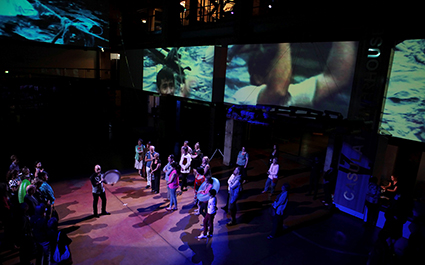
Moustafa Karame on the dhaf (drum), Origin-Transit-Destination, images by Sean Bacon
photo Ali Mousawi
Moustafa Karame on the dhaf (drum), Origin-Transit-Destination, images by Sean Bacon
Origin-transit-destination commences when I receive instructions about how to get to the performance, which starts in Auburn but finishes at Casula Powerhouse near Liverpool. The sites are a 30-minute train ride apart, so I can either (a) catch the train to Auburn and then catch the train home from Casula; (b) catch the train to Auburn and later the mini-bus back to Auburn and then catch the train home; or (c) drive to Casula, catch the train to Auburn for the start, and then drive home at the end.
Our car is in its dying days, but if I don’t drive it’s going to take me about 90 minutes to get home and the show’s going to finish at around 10 on a Tuesday night. Should I risk wobbling up the M5 in my gaffer-taped hatchback or could my partner drop me off partway there and then pick me up from another train station? Our deliberations are a tiny, banal version of the discussion migrants have when contemplating their departure: who should go first, where, when and how, and how will we reconvene?
Waiting, phone-less
The live performance starts at the Auburn Centre for Community, where our mobile phones are taken from us and we are issued with badges. Some have names and others have numbers—there’s no discernible reason as to why. From here, we descend into the bowels of the building, where Khaled Sabsabi has covered the walls of the concrete bunker in scripts written with UV paint. Further in is another chamber, with three chairs in the centre. I wait and wait, expecting a performer to arrive, but none ever does. When I ask the young man who is documenting proceedings whether I should continue to wait, he shrugs and says he’s not sure but that I’m going to have to leave eventually in order to travel to Auburn. It’s a fair point so I make my exit.
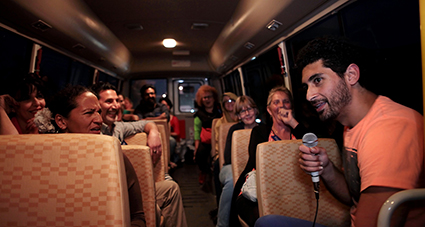
Isamah Sami and audience on the bus, Origin-Transit-Destination
photo Ali Mousawi
Isamah Sami and audience on the bus, Origin-Transit-Destination
By bus
Outside, I am put on the Red Bus. There are two other smaller buses and together we start winding our way through the streets of Auburn. Our charming host is Osamah Sami, who plays guitar while Ram Abdulazeez sings. We are ploughing over a roundabout when Sami asks the audience which story we would like to hear: (1) about the time he sold fireworks during the Iraq-Iran war in order to get some pocket money to buy the ‘right’ jeans; (2) the time he and his family escaped from Iran; and (3) the time that he and his friends put on a musical about Saddam Hussein and then tried to tour it to the United States. It’s a close vote, but the third story wins out and he tells us all about himself (he is a Bombers fan), his father (a Muslim cleric) and the musical they made. When they arrive in the United States, he and his friends are interrogated for more than 24 hours before being deported back to Australia, escorted by air marshals. He’s a hard act to follow but Abdulazeez’s story about his flight from Iraq is just as compelling.
Met by security
The first leg of the journey comes to a halt when we arrive in the carpark of the Villawood Immigration Detention Centre. We haven’t even finished disembarking when we are approached by security, both on foot and in cars. The documenter is told to turn his camera off, as it is forbidden to film. I can’t always hear what is said, but Ben Doherty from The Guardian states that the guard tells the audience that those inside “have it better than people outside, they don’t pay tax” and that a few “take umbrage and debate his position” [theguardian.com, 14 March]. Creative Producer Annemaree Dalziel later emails to tell me that this encounter became more confronting with each night: four guards met the bus on the second night and then 10 on the third. In anticipation of this, the team brought large bouquets for the guards on the final performance but still had to leave before they called the Federal Police, as they were threatening to do.
Tales of danger
While passengers reboard the same bus, the performers rotate and two new performers join us. The first is Shakufa Tahiri, who hands out apples and tells us about planting apple seeds in Afghanistan. Unfortunately, she will never see them blossom, as she and her family are members of the Hazara minority and had to flee. She, her siblings and her mother spent two years in Pakistan while her father went ahead to Australia by boat, a decision she sees not as criminal—as the Australian government would have it—but as heroic. She is now studying Commerce/Law while her brothers are doing Engineering and IT. It’s a classic migrant success story, and I can’t help thinking that it would be so much harder if university fees were deregulated. Then Daniel Saeed tells his story of leaving Iraq, aged 13 and full of bravado: when he offers to drive the getaway car, his mother tells him not to be ridiculous. It’s a moment of humour that belies the real danger these people endured.
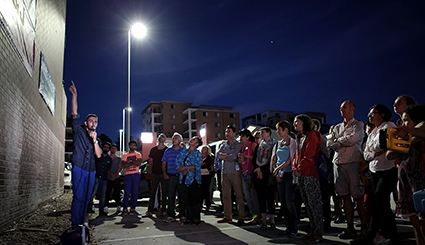
Daniel Saeed outside Chris Bowen’s electoral office, West Fairfield Shopping Centre, Origin-Transit-Destination
photo Ali Mousawi
Daniel Saeed outside Chris Bowen’s electoral office, West Fairfield Shopping Centre, Origin-Transit-Destination
Abandoned
Here we disembark in the carpark of the Fairfield West Aldi, where a forklift zips back and forth and shoppers trundle past with their trolleys. Saeed positions himself under a large sign featuring the name of Chris Bowen, Federal Member for McMahon (which takes in Fairfield) and former Minister for Immigration and Citizenship (from September 2010 to February 2013). In 2011, Saeed, his brother and their school principal accompanied Bowen to a UNHCR meeting in Geneva, where the Minister promised that Australia would lift its humanitarian intake from 13,000 to 20,000 places per annum. This lasted for all of one year, before being brought back down in 2013. “Why have you abandoned us?” asks Saeed of Bowen and of politicians more broadly. Following this Tahiri delivers a passionate plea for the humanity of refugees, pointing out that no one would leave their home for that of a hostile neighbour if they could possibly avoid it. She finishes with a poem by Persian poet Sa’adi, whose words are inscribed on the UN’s building in New York, speaking it first in Farsi and then in English. Here’s an excerpt.
“The sons of Adam are limbs of each other,
Having been created of one essence.
When the calamity of time affects one limb
The other limbs cannot remain at rest.
If thou hast no sympathy for the troubles of others
Thou art unworthy to be called by the name of a human.”
Identity fictions
On the third leg of the Red Bus’s journey, Iraqi poet Jamal A Al-Hallaq shows us his documents, many of which are false. He held these in order to avoid compulsory military service and speaks compellingly about what it is to take another’s identity, in his case that of his brother-in-law. The man sitting next to me chuckles in recognition, having apparently used such documents himself many years ago when escaping from Eastern Europe. “But I’m clean now,” he tells me, “You have to be in Australia.” For his part, performer Mohammed Alanezi travelled with his own life jacket, only to find himself giving it to a small girl. He tells the story with a mixture of pride, resignation and disbelief.
A number or a name?
Our final destination is Casula Powerhouse, where those with names (including me) are ushered in and offered coffee and sweets while those with numbers are forced to wait and then corralled behind a belt barrier. I can’t bring myself to eat in front of them—a decision I will regret as the night wears on and hunger sets in. The cavernous foyer has three large video screens featuring a beautiful video by Sean Bacon. Predictably, there are shots of the sea but surprisingly it looks like a field of gold.
Citizenship & other tests
The first in a series of vignettes, the Right to Stay Test, a satirical addition to the Citizenship Test, takes current talk about rescinding the citizenship of naturalised Australians to its logical conclusion. Performer Tarryn Runkel administers the test to an audience member—neither has an Australian accent. Then there is a football game between Indonesia and Australia, which finishes with the Australian team chanting “Offshore! Offshore!” Both teams then regroup to deliver a version of Noelle Janaczewska’s Go for Gold, which I had just seen in Asylum (see p5). The acoustics of the foyer are difficult so some of the speech sounds are garbled, but it’s an amusing piece, all the more interesting when delivered by non-Anglo faces and voices.
Escape
Finally, we enter another room, where Shahla Shohani, a Kurdish Iranian-born performer, runs on a treadmill while her video self narrates her escape. This narrative is occasionally interrupted by snippets of news bulletins and sound bites, including John Howard’s now infamous “We will decide…” With that, we retreat to the foyer, retrieve our phones and start to find our way home. There is no applause on the night I attend but on Thursday the performers apparently lined up across the foyer to applaud the audience, who applauded them back; on Saturday, spectators walked along the line and shook hands with everyone.
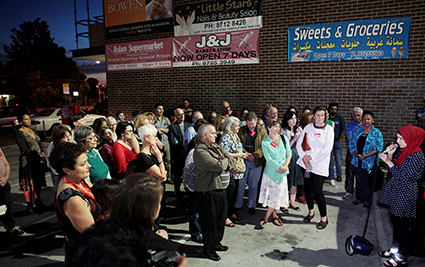
Shukufa Tahiri, rally speech outside Chris Bowen’s electoral office, West Fairfield Shopping Centre, Origin-Transit-Destination
photo Ali Mousawi
Shukufa Tahiri, rally speech outside Chris Bowen’s electoral office, West Fairfield Shopping Centre, Origin-Transit-Destination
Origin-Transit-Destination is epic and occasionally unwieldy, but has some striking moments. Mobile performances made by mobile subjects remain relatively rare in Australia, so for that alone director Sally Sussmann deserves praise. The brief insights into the Indonesian experience are also fascinating and I understand will be developed further in another project. The testimonial performances are perhaps the least effective element, partly because they have become such a familiar feature of the genre and partly because—as I have argued in an article in Text & Performance Quarterly—they seem to participate in a wider culture of accounting, in which migrants are constantly asked to account for themselves by giving an account of themselves. Nevertheless, there are some important differences between the testimonies performed here and those offered by Asylum.
First, in OTD former refugees tell their own stories. Interestingly, their delivery is fairly factual whereas the actors at 505 are often highly emotional; it’s almost as if the greater the distance between the teller and the story, the grander the emotional display. Second, there is a self-reflexivity to some of OTD, such as when Sami asks which story we would prefer. For a brief moment, we are forced to contemplate what we expect to hear from a refugee. Similarly, when Al Hallaq shows us his false documents, we wonder whether this confession is yet another fiction. Such destabilising gestures were largely absent from the Asylum season. Lastly, these stories are shared while travelling on a bus through the migrants’ new home turf rather than in the inner city. Sitting on a bus allows a different performer-spectator relationship to develop because we are all facing the same way: audience members have to listen without necessarily being able to see who is speaking. We are, as theatre scholar Alison Jeffers would have it, sitting shoulder-to-shoulder rather than face-to-face: a position of solidarity perhaps rather than confrontation.
Casula Powerhouse Arts Centre and Australian Performance Exchange, Origin–Transit–Destination, artists Ram Abdulazeez, Mohammed Alanezi, Jamal Al Hallaq, Zahra Alsamawi, Sean Bacon, Annemaree Dalziel, Mustafa Karami, Ali Mousawi, Paul Prestipino, Tarryn Runkel, Bec Russel, Khaled Sabsabi, Daniel Saeed, Osama Sami, Shahla Shohni, Sally Sussman, Shukufa Tahiri; Casula Powerhouse Arts Centre, Sydney, 10-14 March
RealTime issue #126 April-May 2015 pg. 6-7
© Caroline Wake; for permission to reproduce apply to realtime@realtimearts.net
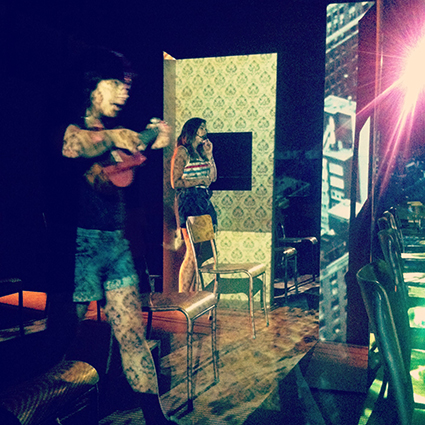
Steppenwolf
photo courtesy PuSh Festival
Steppenwolf
Something good is happening in Vancouver contemporary performance. For the second time in a week I’ve been deeply impressed by what I’ve seen in the PuSh Festival. First it was MACHiNENOiSY’s Time Machine, in which the sophistication of a mature artist’s mind and the innocence of children’s imaginations are given a place to meet and play. This time it’s Steppenwolf by Fight With a Stick, a new company formed by veteran theatre artists Steven Hill and Alex Lazaridis Ferguson.
We sit on benches before what appears to be a low wall. Ever so slowly a white plastic sheet covering it rises, revealing a wide bank of mirrors. More importantly, a little bit at a time, I see my own reflection as well as those sitting next to me. It’s very uncomfortable and kind of exciting. Then the world behind my own reflection begins to unfold. I am looking at myself and past myself. An actor speaking from a strange green booth with a TV-shaped window (for some reason it reminded me of a submarine) tells us about Harry Haller, a man he feels is half human, half wolf, a man who can’t reconcile his dual nature and adjust to middle class conformity.
The two sides of a room, one half very bourgeois clean, the other exhibiting a furry lamp and chair (the wolf side I guess), flick metronomically in and out of the light. The man in the booth talks about the drudgery of existence and the oppressiveness of middle class life. Then the walls of the two rooms fall backwards in slow motion—an unexpected and almost breathtaking moment—as a video image of a man is projected onto an upright box being pushed across a stage further back. Because of the lighting and projection states created by Josh Hite and Parjad Sharifi, I thought at first the figure was also a video image. Then it got weirder: another figure, exactly the same but live, paces behind the figure on the box but further back as the big stage curtains open and close revealing yet another layer of curtains dancing open and closed. Layer upon layer. Depth upon depth. All of this is seen in the mirror, making it doubly strange and compelling.
A wall behind the last set of curtains seems to shift right and left while a strange wooden structure matches its movements. Soon the wall rotates in space, or so it seems at first. It’s a video trick. A video of the wall has been projected onto the wall. As the video image flips, the wooden structure is rotated picking up the image which has now become the cosmos. It does a few 360 degree turns. It’s mind-bending and a bit stomach-churning.
Just when you think you can’t take it anymore a door in the back wall opens, light blasts into the space outlining Nneka Croal, who plays Hermine from the novel. She seems to have come from a bohemian otherworld, here to disrupt Harry Haller’s slow descent into middle class hell and to give him a new lease on life.
This is in keeping with the themes of Herman Hesse’s novel. But where the novel sticks with Haller’s perspective, Fight With a Stick has chosen to shift the point of view to Hermine, thus disrupting the white male narrative and refreshing it from her sensual and, in this case, black female point of view. She inserts a corporeal dimension into Haller’s existential downward spiralling, doing so without rejecting the validity of his crisis. She simply adds greater dimension to it, in a way bringing it up to date.
There’s a carefully crafted dance between all elements in this production: the actors’ measured delivery, the give and take between visual elements and Nancy Tam’s sound design. As the directors said at a talkback session, the desire was to both localise sound to individual objects floating through space—so a sound feels like it’s coming right from the very thing you’re looking at, which it is—and to immerse the audience, envelop them in the weight, space and texture of sound itself.
In the program Steppenwolf is described as a “design-driven theatre installation.” That’s an accurate description. It’s as if theatre artists found an interesting art installation in a gallery and decided to breathe life into it with a few theatre techniques. That’s an oversimplification, but “theatre installation” does seem like the right name for this hybrid.
While Fight With a Stick has kinship with trends in performance seen in international festivals like PuSh, the company also stands very much apart from them. I’ve never seen anything like this tour de force of theatrical magic. Perhaps because Vancouver is a bit remote, Ferguson, Hill and collaborators have been able to achieve such an original vision.
–
Fight With a Stick, Steppenwolf, co-directors Steven Hill, Alex Lazaridis Ferguson, created with collaborators Natalie Purschwitz, Josh Hite, Parjad Sharifi, Nancy Tam, Nneka Croal, Jesse Garlick, Alba Calvo, Russian Hall, Vancouver, Feb 4-7
RealTime issue #126 April-May 2015 pg. 8
© Mikis Vrettakos; for permission to reproduce apply to realtime@realtimearts.net
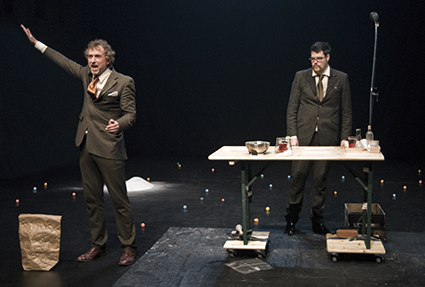
Dark Matter, Kate McIntosh, PuSh Festival
photo Luc Massin
Dark Matter, Kate McIntosh, PuSh Festival
Through a looking glass and via portals, this year’s 2015 PuSh International Performing Arts Festival transports us to states of elsewhere in perception, consciousness and deep introspection. With an emphasis on the acts of looking, the stages for performance become films, become screens, optical viewfinders, a hall of mirrors and through these lenses we find the essence of new forms and practices. Some works offer enough space and time to dream up the keys that will unlock new experiences, while others leave us with questions.
Kate McIntosh, Dark Matter (Belgium)
Kate McIntosh portrays our emerald-dressed hostess in the peeling of a thickly layered quantum physics experiment that after some duration unravels into a cacophonous chaos. Accompanying her are Thomas Kasebacher and Bruno Roubicek, reminiscent of a bumbling vaudeville act—two suited men trying to fill the void by restaging life’s big science experiments via a series of tableaus and a lot of ruckus. With bags of flour, black balloons and ping pong balls, Dark Matter hurtles us into the depths of the time/space continuum. But my response to the energy of these bouncing particles and waves is…stasis.
After a wild chain of philosophical explorations that go even further into the void of contemplating darkness we are left with some lasting afterthoughts and images. McIntosh performs a moth dance to the beat of metronomes as a starry sky rises to reveal a dazzling light. It takes these unexpected moments for me to consider letting go and falling into Dark Matter, but they get lost, overtaken by the work’s chaos. The universe tests us; it is about a balancing act and a randomness that cannot be predetermined. It’s immeasurable, but the choices made in this production begin to show a repetitive, logical pattern. In communications theory, randomness in a signal is called noise: after some time all the dark matter here speaks too loudly. In the end I am not immersed, just left watching a flurry of commotion.

Fare Thee Well, PuSh Festival
photo Colin Griffiths
Fare Thee Well, PuSh Festival
Dries Verhoeven, Fare Thee Well! (Netherlands)
At Vancouver’s lookout point, popular with tourists, we ride a glass elevator up 553 feet to view the city. Dries Verhoeven’s Fare Thee Well! begins here and offers a different portal for the spectator. Looking down at a miniaturised landscape implies a colonialist’s way of observing, ignorant of the complexity of a city’s history. Each telescope is placed in a museological glass case with its lens pointing towards Port Metro Vancouver, Canada’s largest port, responsible for trade with more than 160 world economies. Wearing headsets we are submerged in the passions of “Ah! Spietato,” an aria about betrayal from Handel’s opera Amadigi di Gaula. I am pleasantly taken by this unanticipated and yet simple magic as the telescope provides an upended perspective on the port and an LED display sends tiny messages of farewell to Jian Ghomeshi, Gobstoppers, Cobalt Motor Hotel, Canada Council…while welcoming Starbucks, Oil, Kinder Morgan… The poetic likes of “Only when we part do we look into the depths of love” trail off as we get caught up in the crescendo of commercialism. The loop of opera and LED slogans does not discriminate: all things are part of the flow of capital. The cinematic experience reads like the subtitles have not yet attached to their visual counterparts—our upturned port is a space where we dock our own meanings; a time capsule of what is to come.
Lotte van den Berg, Cinema Imaginaire (Netherlands)
In Cinema Imaginaire, spectators are given agency to walk through the downtown core of the city to make films. We choose the locations, characters, subjects and even the pace at which our film will play out. A facilitator guides us, equipping us with timers and sending us off on several missions. Back from filming, we are asked to share with the group our works-in-progress. The poetics of searching for cinema in everyday life is a simple meditation that we take for granted: we all search for ‘story’ in our fast-paced urban lives through daydream and imagination. Some of the best films and stories come from this place of wandering off. But in Cinema Imaginaire we don’t get a chance to wander too far—there is still the umbilical cord that connects us to our facilitator and to the task at hand. This project assumes we haven’t ever considered the everyday as the subject of film. For our clouded visions to clear we thus need another moment of transformation. In the final moments of Cinema Imaginaire we all sit in a dark theatre space with only the light of a projector on the wall. We take turns appearing before it, narrating our films from memory. This unexpected moment is what we are waiting for, and each moment spoken is poetry.
Fight with a Stick, Steppenwolf
The words “Magic Theater, Entrance Not For Everybody” (from Herman Hesse’s 1927 novel Steppenwolf) make it very difficult to not want to prise open the door and step in. Steppenwolf is an attempt by the company Fight With a Stick to reproduce the book as a design-driven theatre installation. Like a labyrinth of mirrors, the original novel generates multiple meanings around the duality of Harry Haller/Steppenwolf as part wolf, part man. At the core of this piece is an interest in visual and cinematic illusions including a vertical mirror that audiences face to observe the show. We watch the reflective surface as a narrator (Alex Lazaridis Ferguson) housed in a booth reads passages from the book amid soundscapes of sea and city. Performers weave from right to left holding laptops that also present moving images of what appears to be the performance space during rehearsal. But the mirror shatters for me once the ensemble of performers enters the stage as characters (Harry, Hermine, Pablo, Maria) and there is no more value placed on them as reflections. There are stunning visual elements— a spinning bare framework of a house moves towards us against a backdrop of light and projections of shifting colour tones. Harry is swept farther and farther into the realm of drugs and sex or what he calls ‘the bourgeois.’ It’s then you want to turn and face the energy of the performers in the flesh. There’s a strong dynamic felt in Nneka Croal’s Hermine, who might have offered an interesting twist as a female Steppenwolf. If this is a theatrical installation then character and plot need not be integral: seating is unnecessary and the audience should be able to free their animal spirits and roam the hall of mirrors. Then we might truly consume these cinematic and performative vignettes as pieces to a puzzle allowing for a ‘truer,’ reflective way of taking in Steppenwolf.
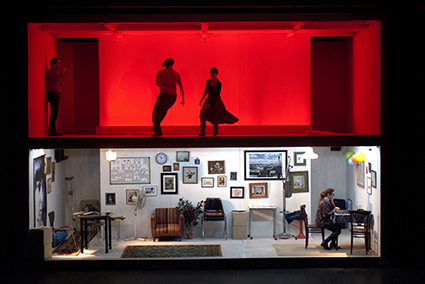
Cineastas, Carlos Furman, PuSh International Performing Arts Festival
photo Mariano Pensotti
Cineastas, Carlos Furman, PuSh International Performing Arts Festival
Mariano Pensotti Cineastas (Argentina)
The lives and the films of four fictional filmmakers (Gabriel, Lucas, Nadia and Mariela) are performed in a two-storey set depicting the private and public spaces of the filmmakers’ lives. The set doubles as a live split-screen of well-choreographed performance with characters and narrators moving via a revolving door of fast-paced entrances and exits. The performance unfolds over the course of a year, as the lives of the filmmakers intersect the making of cinema, footnoting a survey of films that influence and foreshadow major personal events that unravel later on in their pursuit of their creations. What’s compelling in Cineastas is cinema’s power not so much to archive the disappeared but rather to awaken them. In their artistic journey, the filmmakers face the same questions about life that are staged in their films. Cities transform, the ever-changing Buenos Aires is Paris, is New York City, and significant people disappear and then reappear. The text by Pensotti is dense and rich, the films and the filmmakers are related to Buenos Aires, but Cineastas defies geography and borders. As we near the end, the stage is swept clean of any traces of the performance. One of the last images is of Nadia coming home to the streets of Moscow and a beautiful cathedral, only to find it merely a film set.
PuSh International Performing Arts Festival. Dark Matter, Kate McIntosh, writers Kate McIntosh, Tim Etchells, Fei & Milton Wong Experimental Theatre, 28-30 Jan; Fare Thee Well!, creator, writer Dries Verhoeven, Vancouver Lookout, 30 Jan-8 Feb; Cinema Imaginaire, creator Lotte van den Berg, 4-8 Feb; Fight with a Stick, Steppenwolf, Russian Hall, 4-7; Cineastas, director, writer Mariano Pensotti, Fei & Milton Wong Experimental Theatre, Vancouver, 5-7 Feb
RealTime issue #126 April-May 2015 pg. 9
© Cindy Mochizuki; for permission to reproduce apply to realtime@realtimearts.net
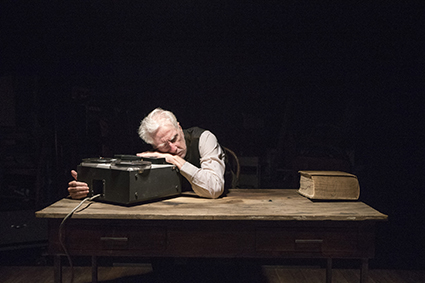
Peter Carroll, Krapp’s Last Tape, Adelaide Festival of Arts
photo Shae Reid
Peter Carroll, Krapp’s Last Tape, Adelaide Festival of Arts
Whether through the vagaries of curatorial taste, the spectre of economic austerity or some untraceable shift in the theatrical ether, the actor in brutal isolation—tethered almost solely by text to stages dimly lit and emptied of relieving or easily symbolic dressing—dominated this year’s Adelaide Festival of Arts.
Beckett Triptych
The State Theatre Company of SA’s offering, Beckett Triptych, locates its three onstage soloists—Pamela Rabe (Footfalls), Paul Blackwell (Eh Joe) and Peter Carroll (Krapp’s Last Tape)—within the crepuscular atmospherics of the company’s subterranean Scenic Workshop and Rehearsal Room spaces. The audience, ushered between venues like visitors to the underworld, is divided in half for the first two dramaticules, which run twice in succession, then we are reunited post-interval for the climactic Krapp.
In Eh Joe, we watch through a scrim as Blackwell, in his “stinking old wrapper” of worn dressing gown and slippers, shuffles paranoiacally around Ailsa Paterson’s monochromatic, vaguely fabulist set that telescopes weirdly towards an upstage door. He checks under the bed–no monsters there—then slumps onto its end, submitting to some expected but unspoken consequence of bringing his body to rest. There he remains in silence for the remainder of the play as a woman’s disembodied voice (Rabe) torments him about his lascivious past and barren present, her clipped, accusatory voice an aural waterboarding. Joe’s face, crumpled and impassive, is projected via a video camera onto the scrim in a series of increasingly extreme close-ups. Finally, just his eyes—unnervingly massive and miraculously unblinking—fill the screen, windows onto a soul in ineffable anguish.
Director Corey McMahon’s montaging of live action and projected image, though not innovative (Canadian filmmaker Atom Egoyan employed both scrim and video feed in his 2006 production for Beckett’s centenary celebrations), is nevertheless an effective solution to staging a play originally written for television, its disturbing intimatisation of a mind under remorseless psychic assault undiminished by the shift in medium.
Like Joe, Footfalls’ May is persecuted by ghosts from a neurotically reproduced past; the present, as a result, is rendered a sleepless purgatory. “Will you never have done…” the voice of May’s mother (Sandy Gore) asks in the low, drawn-out timbre the characters familially share, “…revolving it all? In your poor mind.”
Rabe looks like the “tangle of tatters” to which May elliptically refers, face drawn and pallid, hair overlong and dishevelled (the only mistake is the Victorian-style dress, a too elaborate and loaded interpretation of Beckett’s call for a “worn grey wrap”). But for the audible, mathematical tread of her feet on the worn strip of floor beneath her, Rabe is spectral in Ben Flett’s narrow, starkly contrastive lighting. She looks, occasionally, monstrous as she leans disfiguringly out of the light, or like the tortured figure in Munch’s The Scream as her mouth yawns soundlessly open. Here, perhaps more than in any of Beckett’s other short plays, the role of the director is akin to that of a conductor—the rhythmical progression implied by the play’s title and inherent in its text demands to be both physically and verbally realised—and in this Geordie Brookman keeps time admirably.
It’s somewhat mystifying that Footfalls is followed in the triptych not by That Time, written specifically to accompany it, but Krapp’s Last Tape, the longest and most familiar of Beckett’s shorter plays for the stage. It stands apart from the other two pieces presented here in other ways too, namely that Krapp’s private perdition (for what are each of these plays but inversions of Sartre’s dictum that hell is other people?) is ultimately, if incompletely, reconcilable: “Perhaps my best years are gone,” he says, “but I wouldn’t want them back. Not with the fire in me now.”
This impression is strengthened by Peter Carroll’s performance as Krapp, in which, under the direction of Nescha Jelk, the clowning Beckett minimised in his later revisions of the play is fully reinstated. The result is a slightly fussy, childlike Krapp, less visibly haunted than in many previous incarnations that, however unreliably remembered, cannot be easily forgotten—Patrick Magee, John Hurt. While at times I yearned for more of the gravitas those actors brought to the part, at least neither Carroll nor Jelk mistake ponderousness for insight, a trap into which both lesser and greater interpreters of Beckett have fallen. The production’s one true shortcoming is Paterson’s overdesigned set, a crudely symbolic and needlessly focus-pulling array of middens on trolleys that threatens to overwhelm the only detritus of moment, that of the ultimate unreconstructed hoarder, the human mind.
SmallWaR
It is the body, at least at first, that is the site of trauma in SmallWaR, a companion piece to Belgian writer/performer Valentijn Dhaenens’ BigMouth that substitutes the earlier play’s cast of powerful, militant orators—Patton, Goebbels, George W. Bush—for one of doomed youth, ordinary soldiers destined to die, in Wilfred Owen’s words, “as cattle.”
A truncated gurney is wheeled onto the stage in front of a giant scrim by Dhaenens, dressed in the starchy, army green uniform of a World War I nurse. Fixed to the bed is a flat screen TV on which pre-recorded vision plays: Dhaenens again, this time a limbless, prostrate soldier, only his head and shoulders visible atop crisp white sheets. He is silent and motionless. The nurse sings softly: “There was a boy, a very strange, enchanted boy.” Multiple, ghostlike duplicates of the soldier peel away and cross the stage to answer a phone, the almost seamless transition between video and projection stunning. On the other end of the line are fathers, mothers, lovers—each voiced with skilful differentiation by Dhaenens—who, as with the letters and memoirs which form the basis of much of the script, wrestles with war’s teleology as well as its lived reality. “When you look death in the face,” one of the soldiers muses, “do you think of democracy, freedom and honour?”
There is, refreshingly, little here in the way of simplistic anti-warism, but a late, awkward turn into a seemingly unironical jingoism—evidenced by, for example, the appearance of the words “It is sweet and right to die for your country”—propels the work too far in the opposite direction. It was Owen, after all, who called Horace’s phrase, originally set down in Latin in Odes, “the old lie.”
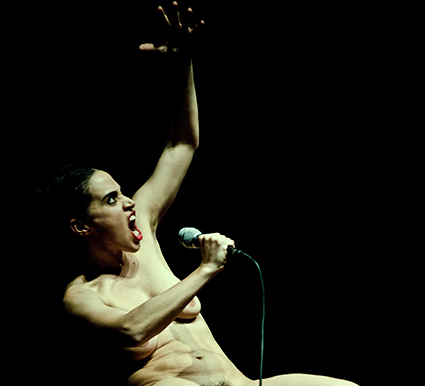
Silvia Gallerano, La Merda, Adelaide Festival of Arts
photo Valeria Tomasulo
Silvia Gallerano, La Merda, Adelaide Festival of Arts
La Merda
A woman (Silvia Gallerano) perches naked on the edge of a tall, pedestal-like chair, clutching a microphone into which she is mumbling the words of what sounds like the Italian national anthem. Her lips, quivering and almost cartoonish, are bright red, her body pale and unforgivingly exposed in the cold glare of multiple spotlights. “Yes I’m a small one,” she says, pianissimo, in the first of the three movements (and one counter-movement, “Italy”) that make up Cristian Ceresoli’s monologue, “and I’ve got these thighs of mine but still I never quit and never give up.” An actor in desperate pursuit of fame whose fascist father killed himself when she was 13, she has the rusted-on look of someone on the verge of a breakdown or, perhaps, a breakthrough that never quite arrives. The howling, narcissistic crescendos (“me, me, me, meeeeeee”) that end each movement, plunging the theatre into darkness and silence, presage a negation of the self that can only be brief and temporary—the ego, insatiably hungry, must always return to cannibalise its host.
La Merda (in English, The Shit) is not, however, merely an atomistic study of neurotic obsession with body image and celebrity. It reveals, through the actor’s grotesque evocations of various men—an odious TV director, her father, sexual predators in school and on the subway—a culture of nationalistic masculinity that connects the Italy of Garibaldi to those of Mussolini and Berlusconi, a lineage that traces the country’s journey from, in Pasolinean terms, a fascist to a consumerist totalitarianism. “The male sex our flag, the male sex our flag,” Gallerano spits at the conclusion of the monologue before clothing her body in a green, white and red flag—an ambivalent gesture freighted with both embracement and resistance. A charged silence hardens, after what seems like a minute or more, into a standing ovation that justly rewards a performance of startling intensity and import.
riverrun
Olwen Fouéré, adapter, director and performer of this one-woman interpretation of the voice of the river in Finnegans Wake, has described James Joyce’s modernist apogee–“admired more often than read, when read rarely through to the end, when read through to the end not often fully, or even partially, understood,” according to Anthony Burgess—as “a seam of dark matter somewhere between energy and form, music and language: the trace of a boat on an endlessly changing surface.” Fouéré, in a virtually uninterrupted monologue that freely splices together passages from all over Joyce’s infamously sprawling text, is at once vessel and waterway, embodying both the river’s sinuous, dreamlike course that ultimately circles back on itself (the novel’s final sentence, which has no full stop, leads back to its first word, riverrun, which has no initial capital) and the shadowy characters who drift and drown in its currents.
Coiled, shifting like a prizefighter on the balls of her feet, Fouéré begins with a dawn prayer, three words in Sanskrit that are found in Finnegans Wake at the opening of Book IV, the beginning of the novel’s final section: “Sandhyas! Sandhyas! Sandhyas!” The jagged stand of Fouéré’s microphone and its lead’s tracing of the edges of a vast patch of chalk evoke the uncertain, meandering quality of the flow of bodies of water, but it is the topographies of the body and of language that are foregrounded here. Joyce’s multilingual, polysyllabic wordplay is given endlessly fluid shape by Fouéré’s sinewy, gestural physicality and almost schizophrenic vocalisations. She hisses, growls, murmurs, sings and, quite literally, breathes the river—Dublin’s Liffey, personified in Finnegans Wake in the character of Anna Livia Plurabelle—into life.
The elusiveness of Joyce’s text is unquestionably amplified in its transition to the stage. The audience member, unlike the reader, never has the luxury of pausing its inexorable flow to dig deeper into its strata of meaning, or to fully unpack its complex puns or allusions to Irish history. But, as Beckett, a close friend and aide of Joyce’s, noted, “[Joyce’s] writing is not about something; it is that something itself.” That something is, in essence, a dream conveyed through language rendered as music, and it is in the splendid, endless noise of Fouéré’s furious unintelligibility that the pleasures of riverrun arise.
Adelaide Festival 2015, Beckett Triptych, State Theatre Company, 20 Feb-15 March; SmallWaR, SKaGeN, Space Theatre, 2-4 March; La Merda, Space Theatre, 5-8 March; riverrun, Dunstan Playhouse, Adelaide Festival Centre, 26 Feb-2 March
RealTime issue #126 April-May 2015 pg. 10
© Ben Brooker; for permission to reproduce apply to realtime@realtimearts.net
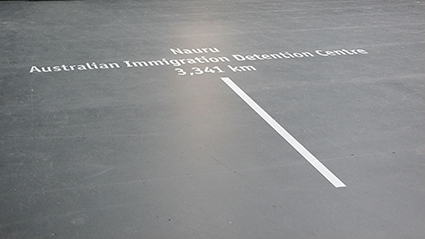
From Landung in Australien, an exploration of refugee and asylum seeker policies presented by QUT Creative Industries Precinct and Christoph Wachter & Mathias Jud as part of Move On:European Media Artists in Residence Exchange.
We feel shame for our maltreatment of refugees, anger at successive governments’ failures of empathy and helpless in our ineffectual protests. The consequent numbness can pass. As Caroline Wake writes, in her feature coverage of the issue, there’s been a recent surge of anger in the wake of the damning revelations in the Moss and Australian Human Rights Commission Reports and the comments of Juan Mendez, the UN Special Rapporteur on Torture. That word, ‘torture,’ hit hard. Caroline looks at recent performance that engages with the asylum issue.
It’s Autumn and our arts festival reporting comes to its seasonal close with reviews, written in all kinds of weather, from Bristol, Vancouver, Perth, Adelaide and Melbourne.
Philip Brophy delivers a magisterial two-part account of Jonny Greenwood’s score and the vintage songs deployed in Paul Thomas Anderson’s unnervingly wonderful new film, Inherent Vice
Our Modes of Production focus in RT125 continues with more on the future of museums, a look at digital theatre initiatives and the second in The Producers series—an interview with Sydney-based Harley Stumm of Intimate Spectacle.
Vale Maggi Phillips. Great sadness is felt at RealTime. Maggi has been writing eloquently and insightfully for us for many years. In her last review she celebrates the dancing of Aakash Odedra in the Perth Festival for “returning thought and wonder back to those ancient beginnings where illumination speaks of life and all the possibilities of birth.” Farewell, Maggi.
Keith & Virginia, RealTime
RealTime issue #126 April-May 2015 pg. 2
© Keith Gallasch & Virginia Baxter; for permission to reproduce apply to realtime@realtimearts.net
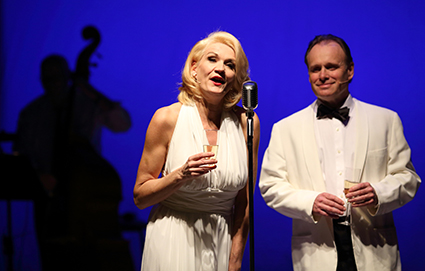
Anne Grimm, Richard Morris, Marilyn Forever, Gavin Bryars, Adelaide Festival of Arts
photo Tony Lewis
Anne Grimm, Richard Morris, Marilyn Forever, Gavin Bryars, Adelaide Festival of Arts
The voice was the focus of Gavin Bryars’ Adelaide Festival concert series, which encompassed some of the great works in his extensive and diverse oeuvre. Bryars was composer-in-residence at this year’s Adelaide Festival of Arts and, as well as taking an active role as a performer in all four concerts, gave numerous talks and interviews. His season opened with a recent opera, Marilyn Forever, spanned madrigals, jazz and popular song and closed with his legendary Jesus’ Blood Never Failed Me Yet.
Marilyn Forever
Marilyn Forever is a chamber opera exploring the intimate reflections of Marilyn Monroe during the last days of her life. There are two principal singing roles—Monroe and a male who alternately represents various men in her life—and a chorus of two more men. The musicians are in two groups—offstage is the Aventa Ensemble of strings, winds, brass and percussion conducted by Bill Linwood. Onstage is a jazz trio, including Bryars himself on double bass and Julien Wilson on tenor saxophone, performing as if supporting Monroe as she sings. The opera thus appears as both rehearsal and performance—a play within a play. Soprano Anne Grimm is wonderful as Monroe, showing all the complexity and inner conflict of Monroe’s character as she responds to the various men who influence or control her life. Her vocal style seamlessly ranges across Monroe’s style and that of operatic soprano. Baritone Richard Morris plays the men in her life—a film director, musical director and husband. Monroe is shown to be continually surrounded by men who manage, record, photograph and venerate her, and in a sense ultimately ‘kill’ her—at one point, all three offer her pills.
Bryars’ composition beautifully combines Canadian poet Marilyn Bowering’s libretto with music that evokes inner reflection. The music is moody and restrained but weaves opera, jazz and popular song into a musical synthesis, haunted throughout by Wilson’s mellifluous sax. The score for the jazz trio sometimes blends with and sometimes contrasts with that of the Aventa Ensemble, creating a musical tension that dramatises the opera. Ninety minutes long and with only brief pauses between acts, it’s nicely paced, with a poignant moment when Bryars performs a double bass solo, with bassoon and horn accompaniment, that seems to characterise Monroe’s tragedy. Bryars declares himself a Monroe fan from his youth, and in placing himself as a performer in close proximity onstage to her, and her men, he symbolically retrieves the inner Marilyn from the legend.
The Gavin Bryars Ensemble
The Gavin Bryars Ensemble gave two concerts, both featuring the voice throughout and demonstrating Bryars’ ability to write all kinds of music. Few composers set Shakespeare’s sonnets or Petrarch’s laude and madrigals, but, in doing so, Bryars revitalises fabulous poetic works and makes them accessible to contemporary audiences.
In the first of the two concerts, his ensemble gave us a selection of laude and madrigals set by Bryars in a musical style characterising traditional musical forms but inflected with jazz, again creating a magical synthesis. The two soloists, soprano Peyee Chen and tenor John Potter, were fabulous, especially Chen, whose soaring, effortless voice was the highlight of the whole Bryars season. Also included were selections from Bryars’ songs from The Morrison Songbook, settings of poems by his friend, poet and librettist Blake Morrison.
The second Bryars Ensemble concert was a study in what can be achieved with the human voice in what were in effect three mini-concerts. We heard settings of Petrarch’s laude and madrigals exquisitely performed by Australian a cappella ensemble The Song Company. Next came the extraordinary Nothing Like the Sun, settings of eight of Shakespeare’s sonnets. Each sonnet was first recited by Irish singer-songwriter Gavin Friday, following which Chen and Potter repeated it in song. Friday’s muffled, brooding style of delivery voiced Shakespeare for contemporary culture, reminding us of the writer’s universality and the settings for Chen and Potter’s voices were sublime.
Finally we heard Act III of Mercy and Grand, Bryars’ arrangement of works by Tom Waits and Kathleen Brennan that included songs by Kurt Weill and the traditional British folk ballad “Barbara Allen”. In this set, Bryars introduced us to the superb mezzo soprano Jess Walker who evocatively rendered the tragedy of life that permeates these songs. At three hours, this was a long concert and might have benefited from being broken into shorter elements.
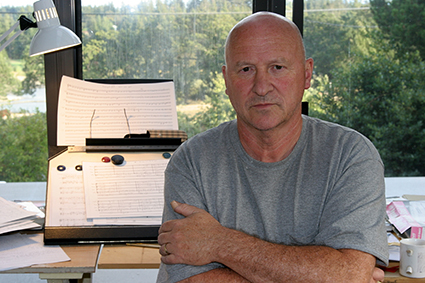
Gavin Bryars
photo Zaleski Enterprises
Gavin Bryars
In these two concerts, Bryars offered the meditative, introspective voice, the voice of prayer and the voice of social commentary. While his adaptation of traditional musical forms is enchanting enough in itself, this music is primarily a vehicle for the delivery of profound poetry.
Jesus’ Blood Never Failed Me Yet
In the final concert, Bryars conducted the Adelaide Symphony Orchestra, opening with three orchestral works including two by other composers: Arvo Pärt’s quizzical If Bach had been a Beekeeper in which the strings’ buzzing builds over a tense rhythm, and Howard Skempton’s exquisitely dreamy and beautifully orchestrated Lento. Bryars also gave us his Porazzi Fragment, an orchestral work based on a 13-bar theme for a work left unfinished by Richard Wagner.
But this concert then returned to the voice, with two arias from Bryars’ opera G, which explores the life of the inventor of modern printing, Johannes Gutenberg—firstly Ennelina’s aria, sung by Song Company soprano Anna Fraser and then the Epilogue, eloquently delivered by the same group’s outstanding young bass-baritone, Alex Knight. His excellent diction was especially important in articulating Morrison’s text, in which G reflects on his life.
The much-awaited finale was Bryars’ best known work, Jesus’ Blood Never Failed Me Yet, incorporating the tape loop of a tramp singing a short refrain, layered over with Bryars’ own orchestral accompaniment. The power of this work lies in the sincerity of the tramp’s spontaneous singing—we hear an authentic voice whose musicality is heightened by the gentle, minimalistic composition that Bryars adds to it. Repeated for half an hour, the brief song becomes a mantra, gradually displacing other thoughts, the work epitomising the spirituality for which Bryars seems to be searching throughout his music.
Bryars’ music is approachable, as honest as his singing tramp, doesn’t rely on tricks or spectacle, and frequently induces a wistful or reflective state of mind. He brings us great poetry, from Petrarch and Shakespeare to Morrison, Bowering and Waits that meditates on the human condition. Every song lays bare deep emotions and a tragic sense of life, yet offers hope through enlightened self-reflection. Gavin Bryars’ compositions celebrate music and place centre-stage that most fundamental instrument, the speaking, singing voice.
2015 Adelaide Festival of Arts: Gavin Bryars in Residence, Marilyn Forever, Aventa Ensemble, ABC Studio 520, 27 Feb-1 March; Gavin Bryars Ensemble and Guests, Elder Hall, University of Adelaide, 3, 4 March; Adelaide Symphony Orchestra, conductor Gavin Bryars, Adelaide Town Hall, 5 March
RealTime issue #126 April-May 2015 pg. 12
© Chris Reid; for permission to reproduce apply to realtime@realtimearts.net
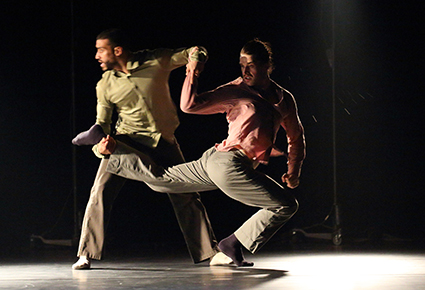
Nickemil Concepcion, Guillaume Quéau, Ten Duets on a Theme of Rescue, Crystal Pite, Cedar Lake Dance Company
photo Tony Lewis
Nickemil Concepcion, Guillaume Quéau, Ten Duets on a Theme of Rescue, Crystal Pite, Cedar Lake Dance Company
The featured dance company at this year’s Adelaide Festival was Cedar Lake Contemporary Ballet, a New York City-based company of exceptional, physically and culturally diverse dancers. The artistic director, Alexandria Damiani, invites selected choreographers to develop a new work on and with the dancers. This is common practice in ballet companies where a shared dance language and process of embodiment is assumed to exist even though classical dance training is culturally specific and there are a number of differing classical styles.
For many years the model for contemporary dance companies has been informed by the modern dance tradition in which a company forms to explore, embody and present the physical and artistic concerns of a choreographer. This is the dominant model in Australia. Cedar Lake’s Mixed Rep program however features works by Ji?í Kylián, ex-Nederlans Dance Theater, Crystal Pite, Associate Artist with NDT and Sadlers Wells Theatre, and Hofesh Shechter, Associate Artist with SWT, former dancer with Batsheva Dance Company. The second program features the choreography of Sidi Larbi Cherkaoui from a contemporary dance tradition that includes Les ballets C de la B, Anne Teresa de Keersmaeker, Meg Stuart and Wim Vandekeybus.
Mixed Rep
Ji?í Kylián’s Indigo Rose is described as a “carefully constructed celebration of youth.” We see Kylián’s trademarks: quirky humour, neoclassicism tempered by folk and jazz signature moves, physical exuberance, a striking abstract design dominating the space (in this case a diagonal line of light cutting through the space that transforms into a triangular silk sail) and discrete episodes of contrasting dance events underlined by changes in musical accompaniment—a travelling trio, two classical duets, a solo etc. In its sequential studies of ‘youth,’ Indigo Rose also features shadow play and film projection of the dancers in close-up.
Crystal Pite’s Ten Duets on a Theme of Rescue, draws on the gravity-bound traditions informing contemporary dance—Graham technique, release technique, contact work—and the theatrical language of human gesture and physical interaction used in dance theatre. Dancers meet, interact and part, backlit by four film lights revealed at the end to be part of a semi-circle of lights on stands. The duets never settle into recognisable narratives of rescue but exist as intimate, rhythmically propelled dramas of weight, flow and touch. This made them resonant but not literal enactments of the theme. I was struck researching the piece that the accompanying score by Cliff Martinez was from Steven Soderbergh’s 2002 remake of the iconic 1972 Tarkovsky film, Solaris, based in turn on the 1961 Polish science fiction novel by Stanislaw Lem. For those who don’t know, the film tells the story of a psychologist/scientist who travels to a space station orbiting a planet to rescue the men there who have lapsed into emotional crises when the planet probes their minds. Present reality and memory merge for the protagonist as the rescue mission becomes an attempted rescue of self from the past, a drama of grief and partial recovery. This play with the notion of ‘rescue’ speaks to the openness of interpretation clearly desired by Pite in shaping this dance.
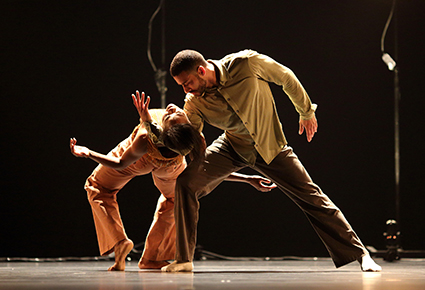
Ebony Williams, Nickemil Concepcion, Ten Duets on a Theme of Rescue, Crystal Pite, Cedar Lake Dance Company
photo Tony Lewis
Ebony Williams, Nickemil Concepcion, Ten Duets on a Theme of Rescue, Crystal Pite, Cedar Lake Dance Company
Violet Kid
Across the two programs Hofesh Shechter’s Violet Kid was the stand-out work. Israeli-born Shechter has developed his own dance vision from his training with Batsheva Dance Company. The training developed by artistic director Ohad Naharin is unique. “There are many things in it: the importance of yielding and collapse, of delicacy, connecting effort to pleasure, working without mirrors, learning to listen to your body before telling it what to do” (www.guardian.com, 8 March).
Violet Kid is an eloquent, complex interplay of social movement and dance with roots in Israeli folk dance, political demonstrations, street gang choreography, rave parties, soccer players’ post-game embraces, victory laps and individual gestural declarations—like the spontaneous gestures of a person listening, eyes closed, to an iPod, the distressed scratching of the agitated drug addict and the strange positions taken by people lost in thought. Movement occurs in rhythmic riffs that establish, build and transform. Sometimes the flow of movement just stops. Other times different riffs play off each other. Shechter’s own score of strings and drumming drives the dancing on. This is ecstatic, tribal contemporary dance. The dancers’ bodies integrate in response to image and rhythm in the way people’s bodies do dancing at music festivals—gloriously idiosyncratic and deeply interpersonally connected. I still carry this dancing in my body.
Orbo Novo
The second program featured a single work, Orbo Novo by Flemish-Moroccan Sidi Larbi Cherkaoui. The term Orbo Novo (New World) was used by Spanish historian Pietro Martire d’Anghiera to describe North America in 1493. The other text informing the piece is neuroanatomist Jill Bolte Taylor’s My Stroke of Insight, an uncanny recollection of suffering a stroke. In an early section the dancers quote or mouth passages from this text. The defining theme was the experience of a radical severance of connections in the brain/body and the strange pleasure of that dissolution, hence an encountering of a ‘new world’ and dissolution of borders of a different sort. The texts, the set of folding screens of latticed reddish-brown metal and the costumes establish the concerns of the work. Isabelle Lhoas’ costumes, suggestive of American frontier clothing, include long skirts for the women and vests and tailored pants for the men. The screens are wheeled about by the performers and used to create walls, rooms, cages, fences and mazes to be climbed, hung off or physically penetrated.
In keeping with the conceptual nature of Orbo Novo the piece unfolds as episodes/explorations of the central notion. Two dancers meet and physically entwine, reaching through the lattice structure—one inside, one outside—until an attempt to completely cross through is thwarted and they separate. A dancer falls down the lattice structure, hanging suspended and then slipping and sliding down, a study of balance and instability. Sequences of throwing the body off balance through arching, whirling and spiralling recur. Rows of dancers establish waves of dance, an ocean of movement. Men scrabble on all fours holding onto and pushing away from each other. Later the dancers become caged primates—male dancers toy with the stiff, doll-like bodies of female dancers, pushed and nudged askew. The piece concludes with the dancers finding extraordinary ways to slither and slide through the lattice and walk off. Often there was too much definition of concept, image and dancing and at other times not enough, as the work veered wildly between abstraction and theatricality—dancer as individual, body, cell, doll, primate and settler. This veering was unsettling, maybe intentionally so.
Cedar Lake Contemporary Ballet, Mixed Rep, Orbo Novo, Festival Theatre, Adelaide Festival Centre, 6-8 March
RealTime issue #126 April-May 2015 pg. 13
© Anne Thompson; for permission to reproduce apply to realtime@realtimearts.net
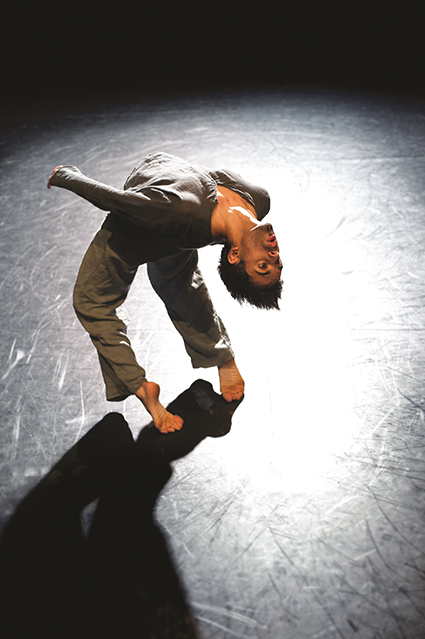
Aakash Odedra, Rising, Perth International Arts Festival
photo Chris Nash
Aakash Odedra, Rising, Perth International Arts Festival
All the excitement, audacity and imaginative largesse of the 2015 Perth International Arts Festival seemed to be invested in the two puppet Giants who literally occupied the city for a weekend of this year’s spread of artistic fare. From recordings of the couple’s majestic walk through the streets, it might even be whispered that the dancers, plummeting up and down from great heights to activate the puppets’ walk, actually stole the limelight of the dance on offer across the total program. Well not quite.
Mark Morris Dance Group, Mozart Dances
First up on the dance bill was the Mark Morris Dance Group’s collaboration with the West Australian Symphony Orchestra, guest conductor Colin Fowler and soloist Amir Farid in Mozart Dances. In a collection of three Mozart works, the pianist time-tinkers the keys of the master’s sound journey while Morris’ dancers gyrate, gallop and gesture in a parallel universe of movement manipulation. Both creators tease form, the master composer with what we accord in our enculturated sophistication as musical rigour, while Morris plays around with a dance repertoire which is technically laconic. It is an old game on Morris’ part and the humour does not quite hit the mark. When a male dancer in the third section clamps onto the torso of another male, the audience titters. The joke, a relief after so much characteristic throwaway ambiguity, gives an indication of what Morris’ rebel status may once have been. A single dancer’s freeze on a commonplace kneel over the sparkling momentum of a Mozart phrase should likewise have prompted recognition of a clever subversion of tradition but banality marked the moment instead.
Have these formal destabilisations—and I refer to the second section where there is a pointed show of feminine posturing performed mostly by the males—become so commonplace in more radical deconstructions that we are no longer able to register nuances of an abandoned convention? The production was salvaged to some extent by the live music and the set’s backdrops of brushstroke blotches, wonderfully lit with precision and effect. The dances and dancers, however, fell far short of the promotional material’s assurance of a joyous encounter.
WA Ballet
Apart from the usual appeal of the Quarry’s rock and city-lights’ phosphorescent backdrop, interest in the WA Ballet’s Zip Zap Zoom for dance aficionados centred on a reproduction of William Forsythe’s Steptext, a kind of reverie on male dancers’ desires to pull out all stops on their technical prowess to match the ballerina’s dangerous leg splicing brilliance. The work, consummately performed by the preening and attentive three men in the cast, suffered a similar time displacement as did the Morris presentation, understandably on this occasion, since Steptext represents this prestigious choreographer’s early experimentation in disturbance. With seeming randomness, clipped sound and light interrupted expectations of flow as the men intercut virtuosic moves with gestural nonsense or pedestrian walks and vied for the rather stilted woman’s attentions. It was a little like being exposed to a master on training-wheels in his journey into fragmentation and dismantled expectations as a means to probe the very principles of meaning-making.
Beside the technical vocabulary of the other two choreographers on the program, Daniel Roberts’ Hold the Fourth and Annabelle Lopez Ochoa’s La Pluie and Zip Zap Zoom, Forsythe’s Steptext appeared childish. Ironically, the WA dancers in the other three works seemed more Forsythe-like than when they tackled the master deconstructionist’s own text of steps. Steptext, as a choreographic idea, however, was more intellectually satisfying than the exuberance and spectacle of Zip Zap Zoom which, playing on computer games, pleased with its high definition LED screen, boisterous dancing and stereotypical gender jokes. In comparison to the Morris dancers, the WA Ballet exuded energy and joy in being there and showing off their stuff.
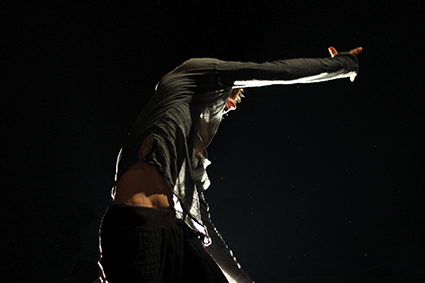
Askash Odedra, Rising, Perth International Arts Festival
photo Lewis Major
Askash Odedra, Rising, Perth International Arts Festival
Aakash Odedra, Rising
A single slim figure undulating between whip-sharpness and tenderness fortuitously recouped the brio, rhythm and promise of a festival. With Rising, Aakash Odedra’s presence and collaboration with an impressive list of contemporary choreographers delivered a sense of celebration awakened in a performance which gathered strength from tradition and experimentation alike, yet was humble and projected humankind as simply strange and remarkable in a world of mystery, beauty and pain. A cast of thousands and the pyrotechnics of the most dazzling spectacular couldn’t have given more. That, I think, was the awe aroused in the first-night audience by Odedra’s beingness. His physicality, virtuosic in certain moments, never lost sight of communication and the power of what the performance medium can bring to our understanding of life. In the beginning of his own choreography in Nritta, he stood reposed in a down-thrust light facing the infinity of darkness before spinning his body on earth and in air in an investigation of Hindu-framed action. The next work, Akram Khan’s In the Shadow of Man, an enigmatic yet extraordinary vision of man trapped within animal and animal trapped in human, shaped Odedra’s physique into a tortuous and grounded vernacular which then transformed into Russell Maliphant’s Cut, where the spectator’s eye was engaged with what can be seen in rapid movement isolated in juxtapositions of light and darkness. These two pieces pointed to an incomprehensibility of thought lying behind what is perceptible through sight. Finally, Sidi Larbi Cherkaoui’s Constellation emanated a simplicity wherein Odedra swung and bounced glowing bulbs around the space, returning thought and wonder back to those ancient beginnings where illumination speaks of life and all the possibilities of birth. The journey was an extraordinary achievement on the part of one young man and, also, of a concept which enabled a few choreographers to construct many worlds though his body.
Rather than retrieving ill-considered reputations (Morris) or fledgling experiments in an altered medium of communication (Forsythe), Rising rose to the occasion in the power of one and saved PIAF’s dance program from insignificance.
Mark Morris Dance Group, Mozart Dances, His Majesty’s Theatre, 13-15 Feb; West Australian Ballet, Zip Zap Zoom: Ballet at the Quarry, 6-28 Feb; Aaskash Odedra Company, Rising, Heath Ledger Theatre, State Theatre Centre of WA,19-21 Feb
RealTime issue #126 April-May 2015 pg. 14
© Maggi Phillips; for permission to reproduce apply to realtime@realtimearts.net
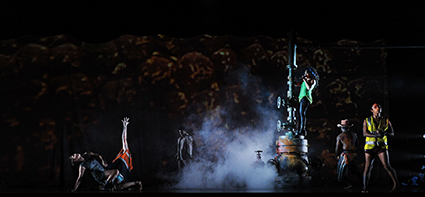
Cut the Sky, Marrugeku, Perth International Arts Festival
photo Toni Wilkinson
Cut the Sky, Marrugeku, Perth International Arts Festival
Large-scale festivals provide the perfect showcase for local companies pushing beyond the limits of self-presentation. Perth-based Barking Gecko Theatre Company has worked with Opera Australia and in association with West Australian Opera to expand its scope with a new opera, The Rabbits. Broome-based Marrugeku has collaborated with an impressive range of commissioning partners from Germany to New Caledonia to incorporate dance, song and media in Cut the Sky.
Marrugeku, Cut the Sky
Marrugeku brings Cut the Sky to festival audiences prepared for a challenging work that defies simple categorisation. Its scope is ambitious, tackling history, Dreaming mythology, dispossession, land rights, climate change and the resources industry.
Musically, Matthew Fargher oversees a rich range of musical styles that enhance the emotional impact of the work’s diverse messages. Ngaire Pigram’s voice is not entirely suited to Nick Cave’s songs, but her reaching for the notes adds intensity to the experience of angst, appropriate to the subject matter. “Ngiyampaa Song” (sung in Ngiyampaa Wangaaypuwan language) and “Wadampa lu Ring-ganga gangany” (“Flood water brings debris,” sung in Nykina and Walmajarrdi) emphasise the Indigenous ownership of the production. Similarly, the choreography rises to the challenges of diverse themes. While a high level of talent ensures that solo and duet dancing is impressive, group choreography is less inspiring. An exception is an ensemble of four dancers moving not quite in unison but marking key beats with their own interpretations of set movements.
A segment addressing the land rights dispute at Noonkanbah in August 1980 is presented with standout clarity, cogently deploying spoken word, archive footage, choreography and musical direction. In a very different way, Edwin Lee Mulligan’s presentation of the crocodile dreaming story is strong in its resonances with images of the staggeringly huge open cut mine; the tale warns against becoming hard of heart with a corresponding hardness of skin. Sequences that should have been more effective were those built around images of devastation, from the impact of extreme events such as the 2004 Indian Ocean and 2011 Fukushima tsunamis.
While the program notes for Cut the Sky rightly celebrate the intercultural and interdisciplinary collaborations between Australian artists and those from as far afield as Ouagadougou, Brussels and Guwahati, this very scope is the work’s fatal flaw in its current form. Cut the Sky is overextended and without enough mass and momentum at its heart to develop a sense of itself and take the audience with it.
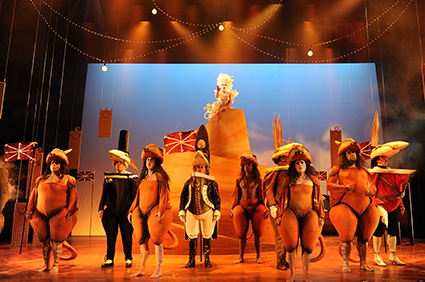
The Rabbits, Perth International Arts Festival
photo Tony Wilkinson
The Rabbits, Perth International Arts Festival
Barking Gecko, The Rabbits
While Barking Gecko Theatre Company has adapted many works from book to stage, The Rabbits sees new levels of ambition in employing operatic form and also in expanding the scope of a work about Australian colonial experience to embrace a universal experience of colonisation and dispossession.
The use of three distinct musical styles—musical theatre for the sweet marsupials, operetta for the bumbling rabbits and contemporary classical for “the Bird” (composer Kate Miller-Heidke’s slightly detached observer figure)—ensures accessibility and engagement for audiences of all ages and musical backgrounds. The sets, costumes and puppetry faithfully echo the aesthetic of Shaun Tan’s source illustrations. There are a few changes of emphasis in libretto and production to novelist John Marsden’s original text. Librettist Lally Katz has retained some of the text and the writer’s economy of style, but uses fewer words with greater impact. The sheer scale of the book’s scenario is limiting, so here legions of rabbits become a handful of individuals, providing a more nuanced understanding of settler culture.
While director John Sheedy aims to speak to all experiences of colonisation, the standout scene in The Rabbits in terms of emotional power is the stealing of the children. Some introduced elements, such as young marsupials getting drunk on carrot juice, are not as successful and even a little annoying but with further development on the cards adjustments might be made for an even more successful Melbourne Festival showing this October.
–
Perth International Arts Festival, Marrugeku, Cut the Sky, concept, choreographer, performer, co-creator Dalisa Pigram, concept, director Rachael Swain, choreographer Serge Aimé Coulibaly, storyteller, poet, co-creator Edwin Lee Mulligan, Regal Theatre, 27 Feb-1 March 2015, Barking Gecko Theatre Company, Opera Australia, with West Australian Opera, The Rabbits, from book by John Marsden, illustrator Shaun Tan, composer, performer Kate Miller-Heidke, librettist Lally Katz, adaptor, director John Sheedy, musical director Ian Grandage, designer Gabriela Tylesova, Heath Ledger Theatre, State Theatre Centre of WA, Perth, 12-17 Feb
RealTime issue #126 April-May 2015 pg. 15
© Nerida Dickinson; for permission to reproduce apply to realtime@realtimearts.net
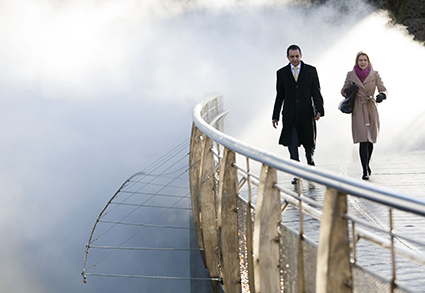
Fog Bridge, Fujiko Nakaya, image courtesy of InBetweenTime Festival, Bristol UK
photo Paul Box
Fog Bridge, Fujiko Nakaya, image courtesy of InBetweenTime Festival, Bristol UK
Outside Arnolfini on Bristol’s harbourside there’s a footbridge over the water to the quay opposite, its span marked halfway across by two large gramophone-like horns turned upwards to the sky. Three times an hour during the InBetweenTime (IBT) Festival the bridge is shrouded in mist, fine droplets of pressurised water, from an installation by the Japanese artist Fujiko Nakaya.
Fujiko Nakaya, Fog Bridge
Each time the haze appears its form and reach alters, twisting and dissipating on the quay’s incoming wind. Sometimes the pedestrian traffic is lost within it, silhouettes and ghosts. Other times the cloud is instantly lifted and forms a kind of crown around the gramophone horns. The piece is called—what else?—Fog Bridge. It’s a simple proposition and pedestrians using the bridge react in many different ways. For a moment you might be in an urban cloud forest, enveloped, lost. You might think about changing global weather or your place in the planet’s ecology. After dark, under the streetlights, those old enough to remember could recall the London smog. Or you could just get pissed off that your clothes are getting slightly wet.
But Fog Bridge does feel modern, in its wry, open invitation—best experienced without justification, its meanings owned by those who stumble upon it. And despite the seriousness of the themes at its heart (climate change, human beings vs nature) it’s a very gentle, comfortable experience—something it shares with a large swathe of work at this year’s IBT festival.
Forced Entertainment, The Notebook
The two principle exceptions to this trend were The Notebook by Forced Entertainment and Extraordinary Rendition by Action Hero. The Notebook is a kind of marathon for its seated audience, with a pain barrier that needs to be broken and euphoric rewards should you stay the course. It’s rare for this Sheffield-based company to adapt a text rather than generate their own (they’ve only done so once before in 2009, with Exquisite Pain, a production of Sophie Calle’s diary of heartbreak) and their approach is minimal, the staging and delivery so carefully constructed you’re unsure whether they’ve done anything at all.
The source material this time is a short novel by Hungarian author Ágota Kristóf, a tale of twin brothers evacuated to a central European farmstead during World War II, surrounded by a supporting cast of craven adults. It’s funny, bleak, unsettling and violent, the story of two outsiders who employ extreme coping mechanisms in the face of an uncaring opportunistic world. Performers Robin Arthur and Richard Lowdon read from the titular notebook—a very visible indicator of where we are in the story, beginning to end—and their delivery is inspired by the twins’ own ascetic view of the world: accounts of their lives must simply be accurate, without illumination or comment, and each boy is accountable only to the other. When the twins speak to another party, they always do so in unison—Lowdon’s and Arthur’s voices merging into one, inflections in absolute sync, cadences locked—and the most that ever happens on stage is the moving of a chair, or a fractional dimming of the lights.
If it sounds relentless, it is: but the story never stands still, a string of troubling encounters, dodgy alliances and catastrophes, and after perhaps half an hour of the performers’ sparse delivery a strange thing happens, and you develop a resonance with the twins—reading in between the lines of their diary, finding their intransigence and inhumanity completely moving. After a further 90 minutes, as your arse numbs and your eyes drift to the books in Lowdon’s and Arthur’s hands, wondering if they end, you nevertheless experience moments of simultaneous confusion and immersion, uncertain which way is morally up or down. And then finally the notebook shuts, and you remember where the hell you are.
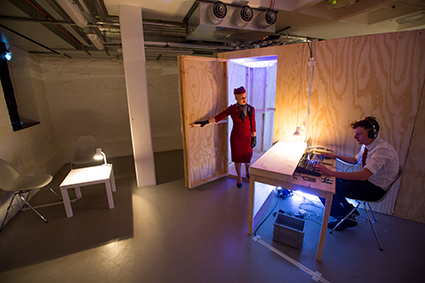
Extraordinary Rendition, Action Here, image courtesy of InBetweenTime Festival, Bristol UK
photo Paul Blakemore
Extraordinary Rendition, Action Here, image courtesy of InBetweenTime Festival, Bristol UK
Action Hero, Extraordinary Rendition
Action Hero’s Extraordinary Rendition is not so much an experience as a process. Its main trope is a marriage of the language of consumer aviation—the airport, the attendants, the in-flight entertainment—with the shady world of extrajudicial transfer and torture by proxy, the politically expedient practice of shipping criminal suspects to countries where they can be interrogated by harmful means. You are the sole audient in Extraordinary Rendition, travelling alone, and it’s heavily implied that you’re the potential victim too, a random body in transit towards doom. Again this is carefully and minimally done, never spelled out: the look on the stewardess’ face, the removal of your personal artifacts, phone calls you cannot hear, the constant, threatening (and astonishingly convincing) roar of jet engines. More I won’t say, in case you’re ‘lucky’ enough to be processed yourself when this piece undoubtedly tours.
But while The Notebook is most effective in the immediate moment, Extraordinary Rendition works best long after you’ve walked away unscathed, popping into your head when prompted by news items or Hollywood fictions alike. It makes you realise that for a few moments you might have experienced a mild kind of identity crisis, and it leaves you grateful for the freedoms you take for granted.
Jo Hellier
Returning to the changeable British weather, Jo Hellier’s Flood Plans is a tone poem about water and erosion—embodied by Hellier, fellow performer and sound designer Yas Clarke, plus some extreme noise. Once more at IBT simplicity invites contemplation, making a huge, overwhelming score of the sounds of landscape and weather, played out in darkness. Field recordings of flowing rivers become an industrial monstrosity, rain grows louder and louder until it screams like a city on fire. Then, in an A/B pattern that becomes pleasingly predictable, it repeatedly cuts to silence and light, revealing everyday fragile human bodies on a blank stage. Hellier and Clarke converse in quiet tones then wrestle each other, like waves against bare rock, neither willing to relent, landing in positions both comic and tragic. Then the noise strikes up once more. In the implacable light and monumental dark, Flood Plans somehow makes me think in black and white—conjuring up Ansel Adams’ photography, the land as a body.
In Between Time festival, Fujiko Nakaya, Fog Bridge, Pero’s Bridge; Forced Entertainment, The Notebook, Arnolfini; Action Hero, Extraordinary Rendition, Arnolfini; Jo Hellier, Flood Plans, Arnolfini, Bristol, UK, 12-15
RealTime issue #126 April-May 2015 pg. 16
© Tim Atack; for permission to reproduce apply to realtime@realtimearts.net
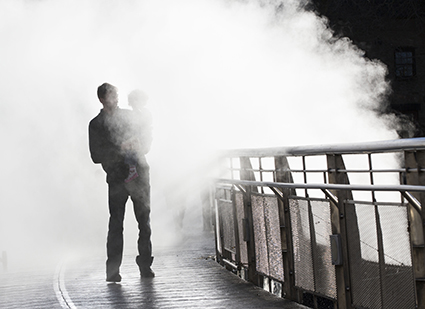
Fog Bridge, Fujiko Nakaya, In Between Time
photo Paul Box
Fog Bridge, Fujiko Nakaya, In Between Time
Fujiko Nakaya, Fog Bridge
Nozzles either side of the walkway (Pero’s Bridge, Bristol Harbourside) began their high-pressure hissing, jetting out steam that surged and swelled. Underfoot the walkway quaked. Pedestrians found themselves co-opted into this drama, to make either a rock star entrance or an exit into legend as the mist rolled gently down from the bridge and crept along the water, promising myths and melodramas, stories and secrets.
Nacera Balaza, Le Temps Scellé
“Sculpted time” comes from Tarkovsky, describing time within the film frame as rhythm. On the IBT opening night, after the welcome, the speeches and the clapping a woman danced under a soft spotlight. Writhed, twirled, struck out, gathered back in, arms and spine fluid, neck flexible, legs and feet reaching, hips centred. A dance both calm and turbulent. Another in this work by North African choreographer Nacera Balaza replaced her under the light, her style a little different, more punchy, more angular, still using the body to describe and explore a discrete and confined volume of space. Echoes and fragments of sound, swelling and diminishing, sustained an imaginary landscape peopled by waves of peers, heroes and ancestors. A one-word chant, an echo of gospel, moody North African trance percussion. They danced at a distance, and so close as to appear to interlock, with their very slightly different bodies and ways of moving in space. They reached a state of near frenzy and worked their way back down from it. Those who stayed were rewarded as time expanded. Those who wished to leave, left.
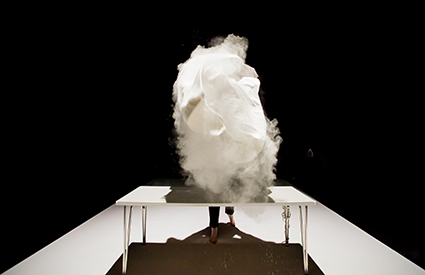
Alba, Jo Bannon, image courtesy InBetweenTime, Bristol UK
photo Paul Blakemore
Alba, Jo Bannon, image courtesy InBetweenTime, Bristol UK
Jo Bannon, Alba
On a dark set, a woman—UK artist Jo Bannon—stood in the spotlight with a white sheet over her head, obviously blinded. Her little hands poked out, questing, feeling her way. She wore neutral black like a puppet master animating a magical scene; her hair and some carefully chosen tools were its luminous players. She washed her hair, flung it back, forwards, back, in a dripping arc, wrapped it in a white towel. Turning her back she dried it with a hairdryer. For a long moment the dryer buzzed, the hair shimmered, shimmied, was shaken, a fibrous mass of electric, fizzing-with-energy whiteness. It dried in a cloud as she combed it.
Choral samples and her mother’s oral testimony hung on a spare structure of abstract sound, while Bannon used minimalist props—a sheet of fabric, a sheet of paper—to make images progressively revealing her condition of albinism as a disguise, a mask, a baffle, an enveloping muffler, purdah, a lair; a consecration and a crown.
Ishimwa, Niyizi
Tall, graceful and exact in his movements, Rwandan-born artist Ishimwa’s physical presence echoes the economy with which this work is presented, during a performance rooted in duality. A frumpy, respectable dress is shed to reveal gold beaded epaulettes on a glamorous frock set off by orange shorts. A monologue in Portuguese argot is set off with Islamic exclamations. A projection of the artist smiling coyly at the audience is superimposed onto another of him crying. He quotes Martin Luther King while sitting on a toilet and, with his head thrust into his trousers, laments the state of his balls. I’ve never seen so many cornerstones of black cultural life so thoroughly undermined in such a short time.
The story here is self-actualisation, the destination is…LEGENDARY…and the terrain is an ambivalent, piss-taking recollection of events in the artist’s past. Set pieces—monologues, video, live singing—build to episodes of elegant expressionist dance. “Niyizi” means “he knows” and was the artist’s mother’s name. Made in her memory this scabrously funny piece is shot through with tragedy like the beading on that frock.
Fog Bridge
That Saturday, among the fountains and shrubs of the Arts Centre, crowds were enjoying the bright day. There were little fluffy clouds above, and dead ahead the bridge billowing white and grey like the source of that day’s weather. Heads turned toward the water and people stood entranced, puzzling.
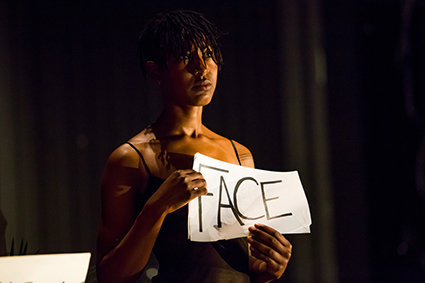
O by Project O, image courtesy InBetweenTime, Bristol UK
photo Paul Blakemore
O by Project O, image courtesy InBetweenTime, Bristol UK
Project O, O
London-based Project O (Alexandrina Hemsley and Jamila Johnson-Small) confronts head-on the blatant sexualisation of black women’s bodies in popular culture, especially music, invoking pop presences from Minaj and Kim to Dylan, to Cream, with a nod to the inimitable naffness of 80s glitz on the way. Donning pastel neon wigs at several points the performers reference the battling divas who already wear all the gear of female objectification, turn it inside out and weaponise it. Project O does the same, extracting contradictory ambiguous readings from super-sexist pop motifs in 50 minutes of gorgeous movement, exposure, acrobatics, glittery shorts and palm trees; 50 minutes of discipline, athleticism, provocation and gentleness. One dancer is more classical, all power and lean, clean lines, the other more extroverted, more infectiously carnal. They are kind to the audience, which is just as well, as they are so in-your-face in getting hold of their agency.
(M)imosa/Twenty Looks or Paris is Burning at the Judson Church (M)
This is what I heard about New Yorker Trajal Harrell’s Mimosa…, which I did not see. “It was so much fun. I could have sat there for four hours happily.” “You were never feeling sure about gender—any minute now someone was going to reveal a body part you hadn’t expected.” “Everybody came out buzzing.” (Thanks, Selina Thompson.)
(S)
This is what I saw during (S), the second part of the (M)imosa trilogy in which 20 looks were modelled by the artist vogueing (or not) with minimalist props. How to wear improbable high tops. How to drape a T-shirt using one or more strategic press studs. How to impersonate the desired and yet render oneself so much more than. How to assume a costume loaded with meaning; how to peacock with scraps. A man cooled himself in the wind of a fan, turning as the sweat dried. There was a scent of cedar and rain. Fabric billowed: a paint-spattered T-shirt, old tracksuit pants. There was an apron. Recollection is imperfect. The apron was important. A hand reached under my guard and twisted my guts, I couldn’t tell you how. Then again, the grunt of muffled sobs ran through all three performances.
(XS)
As in (M) and (S) the framing in (M)imosa’s… XS was subtle and destabilising, although due to the artist’s kindness there were more people there than ideal for the piece. We were given a dense academic text and told the work would be over only after we finished reading it. I don’t know if anyone did. Costumes and props worked wordlessly on our understanding. A kimono (greasepaint, lightbulbs round a mirror: deshabille, preparation). A sober skirt and blouse (service, serving, Sundays, ritual: preparation, undervalued labour). A carrier bag, bedside lamps on the floor, extension leads. In the near dark the psychic and physical space around each audience member augmented what was in front of our eyes with what we imagined, what we remembered. Come to the final action, when the artist’s orange leisurewear put him somewhere supremely vulnerable, and these undemonstrative details, working against each other, created a turbulence in reading the work that somehow bypassed the critical framework he’d set up in the first place. Every detail considered, deliberate, aching with history.
Fog Bridge
A rainy evening and mist poured off the bridge and pooled along the waterfront, a confounding dirty yellow cloud. Three girls ran through it screaming and giggling in the twilight, “Get me out of here!” But when I reached the end of the Harbourside and looked back, the night was clear.
Mammalian Diving Reflex, Nightwalks With Teenagers
We took a bus to go on a walk in the night with some teenagers courtesy of Canadian company Mammalian Diving Reflex. After the games and the ice-breaking we set off in a long, fast crocodile, over the road and past the bus stop and keep up, can’t you! and round the mulberry bush. We were introduced to some of the lesser-known highlights of the area: the house with scaffolding, the gate into a field, dead man’s tree, a friendly duck. Every so often the young people taunted us with very silly dares: Roll down the hill! Jump off the tree!! In the dark, in the mud and with the night vista of Bristol twinkling majestically before us. After a while it was catching, and we were beguiled back to those wild winter nights where now is thrilling and things are what you make of them, and adults a reluctant afterthought. Yes we would play tag, be a werewolf, have a go on the slider. Thank you to the young people who took us out and brought us back safely to the common-sense world with verve and nerve and stories and cheek.
IBT/15: In Between Time 15, Bristol, UK 12-15 Feb
RealTime issue #126 April-May 2015 pg. 17
© Osunwunmi ; for permission to reproduce apply to realtime@realtimearts.net
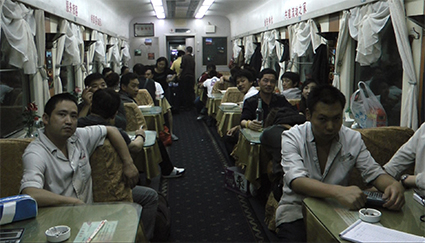
The Iron Ministry
It starts with a distant drone in darkness, slowly building to a screeching cacophony. After a few minutes shapes loom from the shadows, but they remain abstract, difficult to connect to a wider reality. We’re in a cramped, Dante-esque space of steel, rubber and glass. The hellish impression only deepens when the first signs of ‘life’ are revealed—blood-red hunks of raw meat hanging from railway carriage walls in what appears to be an improvised butcher’s shop.
JP Sniadecki’s The Iron Ministry is an intimate portrait of life on China’s rail network. Although the frame gradually opens up after the dim, claustrophobic opening, we remain in a world circumscribed by trains that seem to roll ever onward, impervious to their human cargo and beyond the power of any individual to stop or even divert. After the camera frames the raw meat, a human element enters the image in the form of an old man peeling vegetables, squatting in the rattling vestibule of an equally aged carriage.
This is the lively, overcrowded world of China’s hard-seat class, where life in all its vitality, humour and grime is always inescapably in your face. As in every country, waste and death are more present the further down the socio-economic ladder you go, so in addition to the meat hung from the carriage walls, we see dirt-covered floors and a filthy, cigarette butt-filled toilet bowl swaying gently to the train’s rolling rhythm.
We spend quite some time in carriages little changed for decades, packed with rural folk bearing produce and dressed in tunics and caps straight from the 1970s. As we cut from one seemingly random train to another, it gradually becomes apparent we are winding our way up through the many options available on China’s rail network. From the hard-seat class carriages we move to the still crowded but cleaner and more orderly soft seat class. We witness the refined lace and quiet of the soft sleeper compartments. Finally, towards the end of the film, we arrive in the vacuum-sealed, air conditioned sterility of China’s new bullet trains, where people no longer seem to interact, let alone talk. Indeed, on the bullet train we see there are few people present. Instead, well-dressed, isolated individuals simply gaze at their mobile phones as they glide across the country at almost 400 kilometres per hour.
In following this journey through China’s many different types of trains, the film also traces the contours of the country’s class system. To have money means you can insulate yourself, to a degree, from your compatriots and the world outside. You can partake of the most up-to-date transportation imaginable, and move about at great speed. And the faster China’s upper middle classes travel, the further they seem to pull away from those in the slow hard-seat carriages, whose lives may have improved over the past 30 years, but for whom basic conditions remain much the same.
Sniadecki is part of the Sensory Ethnographic Lab at Harvard University, and The Iron Ministry is very much in the tradition of a certain strain of US Direct Cinema. Specifically, The Iron Ministry draws heavily on the approach of documentarian Frederick Wiseman who launched his career with the controversial Titicut Follies back in 1967 and has churned out a documentary almost every year since. Like Wiseman, Sniadecki is not so much interested in individuals—though we do meet some very memorable people in The Iron Ministry—but rather a system, an institution at work, as it shapes the behaviour and thoughts of its subjects.
In the case of The Iron Ministry, the institution is China’s vast rail network, which has been steadily expanding into the country’s furthest reaches over the past 20 years. “The railway changed Tibet enormously,” comments one passenger to camera, referring to the Beijing-Lhasa line completed for the 2008 Beijing Olympics. As well as bringing tourists, she claims the rail link has brought mining bosses from all over China, eager to exploit the remote province’s mineral wealth. She draws a direct parallel with America’s expansion westward in the 19th century, in which the railways also played an integral part, opening the land to industrial development and providing great opportunities for those who came in the trains’ wake—as well as unprecedented disaster for the indigenous people already there when the tracks were laid. Unlike the United States, however, China’s complex experience of modernity has been a stop-start affair, marred by colonialism, war and the disasters of Maoism: the resultant uneven nature of the country’s development is evident in Sniadecki’s film.
Wiseman’s influence looms large in the People’s Republic, and by working in the tradition of his Direct Cinema style, Sniadecki also aligns his film with much of the independent documentary work that has been done by Chinese directors over the past 25 years. This is unusual for a documentary made by a Westerner in China, where foreign films generally operate in a world apart from those locally made. In the 1990s, the early Chinese independent Duan Jinchuan was inspired by Wiseman’s observation of institutions to make films like The Square (1994), about daily life on Tiananmen Square, and No. 16 Barkhor South Street (1996), about the workings of a low-level government office in Tibet’s capital Lhasa. More recently, festival favourite Wang Bing draws on some of the same methods in films like West of the Tracks (2003) and Til Madness Do Us Part (2013).
China’s varied documentary scene these days also encompasses many other styles and approaches, but The Iron Ministry demonstrates that carefully structured observational work can still inform thought-provoking cinema that resists the explanatory voiceovers favoured by television documentary. Sniadecki’s subtly layered film reveals much, comments little and leaves us many questions to ponder—not least what happens when the forward momentum of China’s railway expansion and the economic boom upon which it is built begin to slow down.
The Iron Ministry; writer, director and producer JP Sniadecki; USA/China, 2014; Australian Centre for the Moving Image, Melbourne, 7–15 March
RealTime issue #126 April-May 2015 pg. 18
© Dan Edwards; for permission to reproduce apply to realtime@realtimearts.net
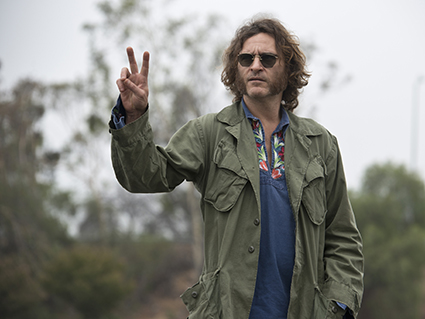
Joaquin Phoenix, Inherent Vice
Quite early in PT Anderson’s Inherent Vice, we hear Jonny Greenwood’s theme “Shasta.” Standard musical portraiture in the film—but what a slithering, sonorous mystery this theme is. Imagine Olivier Messiaen’s symphonic swathes (like a French forest lifted up and floating in the clouds) reinterpreted by Nelson Riddle’s teasing velvet string arrangements for sono-erotic voices like Nat King Cole, Frank Sinatra and Judy Garland.
Clarinet, oboe and cor anglais outline the corporeal form of Shasta (rendered ghostly flesh by Katherine Waterston), then melt into her insouciant presence. It sounds like she’s coming in and out of focus. And that’s what she does throughout the film. She’s neither here nor there; neither telling the truth nor lying; neither sad from having loved Doc (Joaquin Phoenix) nor yearning to start afresh with him. “Shasta” inaugurates Inherent Vice’s score as a mirage.
The grandiose “The Chryskylodon Institute” unfurls when Doc follows a lead to a privately funded post-hippy loony-bin. Think Bernard Herrmann meeting Philip Glass by way of Jon Brion’s Magnolia score (Paul Thomas Anderson, 1999): loping, patterned overlays, serially generating harmonic moiré effects as sections lock into a gridlocked waltz-stanza. It’s partially pastoral—evoking the fluidly expanded spatial domain of the eponymous institute—but it also reflects how Doc navigates the institute’s hall of mirrors. It’s an inhabited pastorale. The score swells while location sound recedes. Then, plucked bottom-end strings (echoing Herrmann’s ominous ECG death-gulps from Psycho’s 1960 score when Janet Leigh expires in the shower) start to corrode the tinkling Glass-like patterns, changing the waltz into a strange limping 4/4 riff. It mimics Doc walking, scuttling, then crawling and finally on his knees as he converses with a heavily medicated Mickey Wolfmann (Eric Roberts). The two drug-addled minds talk while the score disintegrates around them. It’s more avant-garde dance theatre than neo-noir pulp fiction.
“The Golden Fang” saunters in mid-ground as we approach the corporate citadel of The Golden Fang, led there by Doc who interprets a cryptic note in a postcard recently arrived from the invisible Shasta. In the middle of a commercial dime store strip wasteland stands the ludicrous architectural folly. Greenwood takes his cue from Les Baxter’s exotica arrangements (sketching violin passages then overlaying them with vibraphone and celeste). If the architecture looks like exotica in concrete and steel, investment dentist Rudy Blatnoyd (Martin Short channelling British TV’s Jason King) looks like Baxter’s number one fan. But gradually the track darkens, melting into a reworking of Bernard Herrmann’s sensorial dirges for Martin Scorsese’s Taxi Driver (1976), where orchestration relates less to situation and description and more to the body and its presence. In place of Robert De Niro’s exhausted Vietnam vet wired by debilitating insomnia, we get the tuned-in dropped-out headspace of Doc. Bleached-out anxiety, slo-mo paranoia, now dusted with cocaine.
“Adrian Prussia” is the most Radiohead-like melodic construction in the score, replete with anxious string arrangements (all rasping, scratching, thumping) and a Zelig-like ghosting of their pulsations by an analogue synthesizer. Its dark couverture symbolises the morbid delight Adrian Prussia (a Putinesque Peter McRobbie) displays in administering vengeful violence, here likely to befall Doc. The synth is gradually over-amped, flicking wildly through multiple octaves, while the reverberation of the orchestral textures builds into an overbearing wall of sound. With its core motif and swelling momentum, it evokes a whirlpool growing in size, speed and intensity—the aural equivalent of the water-down-the-drain optical effect which was often superimposed in montage sequences at the peaks of delirium in classical film noir gumshoe tales. But unlike the quivering Romanticism of Miklos Roza, Elmer Bernstein or David Raksin, Greenwood’s theme is energised by an interiorised deconstruction of its own musical grammar. The Hollywood Romantic scorers could beautifully narrate or describe the bleak disposition of their entrapped anti-heroes, but only through analogous measures. “Adrian Prussia” sonically cannibalises its form to morph from Self to Other, from Hollywood to Burbank, from Monroe to Manson.
Greenwood delivers the most ‘indie combo’ track in the score late in the film. “Under The Paving Stones, The Beach!” occurs when we taste again the bittersweet yearning evoked by the oral ménage à trois of Shasta’s breathing, Doc’s exhaling and Sortilège’s (Joanna Newsom) liquefied crackling, as the latter’s voice-over stage-directs a rolling sunset review of the impressions Shasta has left on Doc’s mind. Cue that golden brown coastal ennui of silhouetted lovers. Shift focus and f-stop to capture that Kodak moment on the sand. The music sounds like Tortoise jamming on a disembodied surf ditty, here thickened with multiple bass lines and low guitar riffing. No chords, just muscular linework shaping the melodic counterparts. As the French student revolutionaries chanted “Sous les pavés, la plage!” when they tore up the paving stones to hurl at the May ’68 riot police, they romanticised this reality effect of ‘the street,’ aping Yves Klein’s Nouveau Réalisme in a detournment of Eugène Delacroix’s revolutionary history painting. But California’s 70s topography was radically different: fresh asphalt, widely dispersed, dripping into pools of developments like Channel View Estates’ arterial displacements funded by corrupt commerce. California’s youth ‘head’ culture was already at the beach, away from actual and symbolic barricades. Greenwood’s riffs have a slightly tragic air: Manhattan Beach has plenty of pizza, but no Latin Quarter.
Near the film’s denouement, we sink back into atonality. “Meeting Crocker Fenway” accompanies the queasy encounter between Doc and the story’s true puppet master, Crocker Fenway (Martin Donovan), father of teen runaway Japonica. It’s the classic Herrmannesque rhythms of breathing/sighing/exhaling—first done in Hitchcock’s Psycho, where the score is more neurological than musicological; more synaptic than symbolic. Greenwood’s appropriation of this approach colours the scene with a visceral tension. Everything becomes less literary and more bodily: the unflattering light on flesh; Doc’s pubic sideburns and dead-fish eyes; Fenway’s Nazi death-mask visage. Where is this scene going? Who is pulling whose strings? The music asks these questions. The ondes martenot (Messiaen’s favourite ethereal instrument) plays underneath a series of cello/viola/violin waves, effecting things going forward and backwards simultaneously. It ‘auralises’ the narrative’s lack of directionality. The instruments’ wavering envelopes connote a hovering stasis where space, distance and ground waver indistinctly, just like the perceptual haze through which Doc orients himself to LA’s vanishing point.
“Shasta Fay Hepworth”—a retake of “Shasta”—provides a non-committal coda to Inherent Vice, here subscribing to her full familial status rather than highlighting her mystical attraction in Doc’s life. It marks her return to his arms, and his to hers. Searing concerto violin arcs sparkle as they bond, melting her head into his shoulder, driving in an unspecified vehicle, at an unstated time, into a time and space nearer to us, but just as far from themselves. It might be daylight, but a car following them shines its lights onto Doc’s face, reflecting off his rearview mirror. Is it the morning beach or moonlight asphalt? The Bartok-like gypsy cry of orchestral heartache sounds like the disembodied music from an old Hollywood movie playing on a TV set out of reach. It ends sans harmonic resolution. Was it playing at all? Were they driving anywhere? Its beauty lies in how you read the score—not the novel.
Read part 2.
–
Inherent Vice, writer, director Paul Thomas Anderson, based on the novel by Thomas Pynchon, music by Jonny Greenwood, cinematography Robert Elswit, editor Leslie Jones, 2014
RealTime issue #126 April-May 2015 pg. 19
© Philip Brophy; for permission to reproduce apply to realtime@realtimearts.net
Throughout Inherent Vice, Doc (Joaquin Phoenix) strains to grapple with a convoluted plot typical of the quagmire which entraps the classic PI, pushing forward yet tethered to the black elasticised tar of his circumstance. But Doc is never perplexed by this. He arrives on the scene, ready for anything yet completely unprepared.
Can he read anything going on in any of these scenes he blithely enters? Can we read his face? No—but Can can. Can’s “Vitamin C” (from the 1972 LP Egg Bamyasi) cuts in, loud and upfront: an amazingly precise Krautrock motorik rewiring of James Brown’s “Funky Drummer” (1969), with premonitional-Portishead falsetto Japlish by singer Damo Suzuki. German in origin, the track here is LA pastoral: it accompanies locations and architecture more than faces and action. Its studio architecsonics of crisp live instrumentation sonically draw up a plan of the brooding scenario at the trailer whorehouse in the middle of the skeletal Channel View Estates as if it’s scoring the space without acknowledging the characters within.
The music’s pulsating groove is thus all the things Doc senses but never eyeballs in detail. This is the opposite of the classic noir PI whose post-war asphalt terrain grounds the Chandleresque figure with a Sherlock Holmes intensity of observation. Doc stumbles and rummages. Can see the scene for what it is. It signposts how songs appear throughout Inherent Vice: they’re deliriously disconnected, palpably parallel—for that’s how Doc perceives things.
Despite its labyrinthine plot, the film maintains an eerily flat rhythm. It’s like watching five 70s TV cop shows at once (try Mannix, Adam-12, Colombo, Hawaii Five-O and Cannon) on downers. But read this anti-cinematic pro-televisual film closely and you’ll hear that its tonal shaping of drama is set-designed by the score and songs and their placement. The sound of the music is astoundingly sharp, irrespective of its vagaries or its spiky inappropriateness. The latter is exemplified by The Markett’s “Here Come The Ho-Dads” (1963). Played in toto, it too is essentially pastoral and environmental: it scapes as it sounds. Yet it also comments: it musicologically evidences the lack of societal synchronism of such radiophonic 60s dance-craze pop (the surfer’s stomp) with the Mansonesque 70s blood dawn (the hippie’s stab). One might ask why did the Manson Family do what they did, but one could equally ask why are The Marketts still being heard in South Bay while corporate celebs are being slaughtered like pigs in the Hollywood Hills?
The Marketts were produced by Joe Saraceno, producer of The Ventures: the archetypal instrumental garage/lounge-room teen combo who commandeered the US charts with their domestic lo-fi amateur rock’n’roll in 1960. Like The Ventures, The Marketts bear an innocent sound, like they’re playing in your living room rather than a studio. Charles Manson may have heard them on the radio over and again while he read the Bible and envisioned a suburban apocalypse. Inside Charlie’s head, “Here Come The Ho-Dads” would have been the sound of dumb rich white kids playing in their living rooms, ripe for slaughter. The song’s placement in the film marks a ‘socio-aural suppression’ of how larger socio-musical realities beyond the story’s scenography frame its incidents better than literate description.
Appropriately, Doc seems caught between these two social realms, of going with the radio flow of things, yet sensing the probability of darker wavelengths modulating reality. From his relationship with a pot-puffing assistant D to his doctor’s office at a small medical centre, to his ‘head’ appearance within the corridors of the LAPD, Doc doesn’t fit; nor does the music. The more one observes this, the more “Here Come The Ho-Dads” seems displaced. Its snare room reverb evokes a tangible space beyond the phonological realm of the otherwise normative stomp track. Even Saraceno and The Marketts could not help infusing their music with aural hieroglyphic encoding of an ‘otherness’ beyond its domain.
Another strange track placement—but so it should be, as it’s heard in Doc’s inexplicable reception area. We faintly hear Minnie Riperton’s “Les Fleur” (from the 1970 LP Come To My Garden). Doc’s ‘secretary’ Petunia Leeway (Maya Rudolph) behaves like a counter-agent, talking in cryptic code, seeming to pretend to be a secretary yet perfectly synched to Doc’s ‘profession’ as a pot-head PI. At first it sounds like office Muzak à la Jack Nitzsche’s BGM for Milos Foreman’s One Flew Over The Cuckoo’s Nest (1975). But “Les Fleur” has distant echoes of groovy Broadway 60s musicals. That’s because it’s produced by Charles Stepney, the Chicago producer who worked with Ramsey Lewis and Rotary Connection (Riperton’s first band) to develop an orchestral take on ‘psychedelic soul.’ It’s a black, sumptuous, sexy genre, tinged with spotlit pain and undulations of Gospel. It became hyper-Californian, blossoming in the power terrain the recording industry had attained nationally at this time, when regional voices of rock, pop, soul and funk were channelled through LA’s recording industry head offices. Stepney’s productions and arrangements are accordingly neither folk nor funk, fish nor fowl. Furthermore, the scene is genetic: Maya Rudolph is the actual daughter of Minnie Riperton and Charles Stepney. She bears the corporal DNA of the very sound we are hearing. By this stage, Inherent Vice’s soundtrack is emerging as the densest textual layer in the film.
Les Baxter’s “Simba” (from the 1956 LP Tamboo!) scores an outrageous party scene with Mrs. Wolfmann (Serena Scott Thomas with a fake facelift). It’s one of Baxter’s arch exotica tracks, plum-stuffed with corny Africanesque posturing. It sounds like Joseph Campbell in race-drag dancing an ‘expressive movement’ pantomime on a camp stage in the late 50s. Baxter’s orchestration is half-Nadia Boulanger, half-Walt Disney. His sounds are synchronised to West Coast 50s hipsterism, a kind of sunny beat existentialism before the 60s counter-culture took over the mental real estate of the newly instated youth culture. Amid the gaudy trappings of LA wealth, “Simba” echoes the Coens’ use of Yma Sumac’s “Atypura” (1950, co-written by Baxter) in The Big Lebowski (1998) at the similarly decadent beach party of pornographer Jackie Treehorn. Here, it’s all Martinis and Mai-Tais, Incan princesses and American wealth. Doc reads it as a decrepit time-warp, out-of-phase with social justice yet au courant with the bald exploitative machinations of petty commerce at the time.
The smooth whine of Neil Young floats in twice: first, “Harvest” (from the 1971 LP Harvest); second, “Journey From The Past” (a 1971 track unreleased until the 2009 CD box-set The Archives Vol.1). His voice and stoned, laconic farmhand instrumentation provide a reprieve from the hitherto eclecticism of the soundtrack. This shift to a naturalistic centre often occurs in American movies, when they wish to clear the smoke of artsy pretentions or worldly weightiness. The vernacular of the Laurel Canyon singer-songwriter movement provided the template for this device. The applied ‘realism’ of such a practice mimes a sincerity of intent in the film’s narrative. It provides an assuring crutch in a movie, as if there’s something being resolved by a character, by their circumstance, or by the plumed line of a script contrivance. But in Inherent Vice such a moment is illusory—or more appropriately, a mirage in the Southern Californian desert. For while Doc might be half-thinking of some grounded mental or emotional state, he continues to randomly wander and blunder through his investigative duties. Again, he stands separate from the music which evidences his perspectives on things, himself and others. The song thus accrues a complex multi-voicing, despite how resolutely normal it sounds.
Finally, another ‘socio-aural suppression’: the absence of any songs by Joanna Newsom. For her embodied and disembodied voice flitters around the film’s amoebic periphery—crucially providing a Grecian-chorus-therapist voice-over narration in a floral reconstruction of the celebrated gravel of the film noir PI. Like the film’s multi-voicing song selection, her voice speaks in multiple tongues. It fuses a ranch-hand twang (bearing a distant sense of back home) with a surf-shack drawl (now acclimatised to coffee house brews and lounge room tokes), while retaining a pubescent timbral veneer. She sounds like Mimsi Farmer or Tuesday Weld at a beach party dropping a truth trip on you. And like those iconic figures from 60s groovy movies (Roger Corman’s The Trip [1967], Arthur Dreifus’ Riot On Sunset Strip [1967], Maury Dexter’s Mary Jane [1967], Russ Meyer’s Vixen! [1968], Richard Rush’s Psych-Out [1968], William Rotsler’s Mantis In Lace [1968], Robert Thom’s Angel Angel Down We Go [1969] etc), Newsom’s performance personifies those hip trip chicks who gravitated to the bright lights of LA and all its otherworldly charm. Newsom’s own music, of course, is the polar opposite: ornately cerebral, stylistically obtuse, harmonically herbivorous, rhetorically angelic. So is her singing voice opposite to her narrating voice. But most importantly, this creates a meta-voice for the film, conjuring an image but voicing its contra. In this sense, Newsom’s Sortilege is just like a Manson chick: middle-class refugee, prepped to be a bridesmaid, but readied as an agent of terror. She sings with her mouth shut, insinuating an invisible Otherness, just as the Manson chicks broke into well-off houses in LA late at night, creeping around for the hell of it. Their silence was their method. Inherent Vice hears it well.
–
Read part 1.
Inherent Vice, writer, director Paul Thomas Anderson, based on the novel by Thomas Pynchon, music by Jonny Greenwood, cinematography Robert Elswit, editor Leslie Jones, 2014
RealTime issue #126 April-May 2015 pg. 20
© Philip Brophy; for permission to reproduce apply to realtime@realtimearts.net
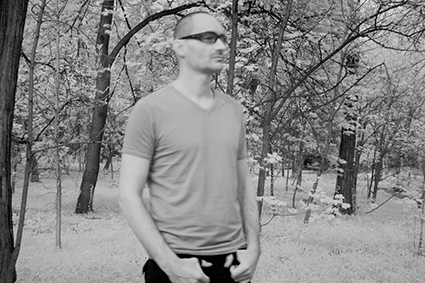
Thomas Koner
The Goethe Institut’s annual Festival of German Films typically offers some of the most searching and powerful of contemporary films. This year’s program is no exception with a new film, The Cut, from the great Fatih Akin about the Armenian genocide, Dietrich Brüggemann’s greatly anticipated, minimalist account of extreme religious faith and Burhan Qurbani’s We are young, We are strong, about racism in Germany in the early 1990s. Classic cinema is represented by FW Murnau’s Faust and a highly regarded new documentary, From Caligari to Hitler.
Thomas Köner plays Faust
A highlight of this year’s festival will doubtless be the presence of award winning composer, media and installation artist Thomas Köner who appeared in Liquid Architecture 10 in 2009 and will a play his soundtrack to Murnau’s 1925 silent classic, Faust (with actor Emil Jannings) live in Sydney, Melbourne, Brisbane, Canberra and at MONA in Hobart. Accompanying Faust will be the documentary Caligari To Hitler. Köner has previously been commissioned to create music for silent films for the Auditorium du Musée du Louvre, Musée d’Orsay and Centre Pompidou.
From Caligari to Hitler
For his documentary on the years bridging the Weimar Republic and the Third Reich, Rüdiger Suchsland adopts the title of Siegfried Kracauer’s 1947 book From Caligari to Hitler: A Psychological History of the German Film. Kracauer saw in Expressionist and other films anticipation of but also desire for and denial of impending Nazism. Using restored newsreels, footage from classic and lesser known films from the era and interviews with Fatih Akin, Volker Schlöndorff and other filmmakers, Suchsland tests the Kracauer thesis in what promises to be an engrossing cinematic experience.
Stations of the Cross
In the feature film program, Director Dietrich Brüggemann rigorously matches content with form in Stations of the Cross. Using a mere 14 shots and three camera moves, he focuses intimately on a 14-year-old girl, a member of a conservative Catholic sect hostile to Rome, as she refuses food and withdraws from social life, imagining herself on the way to heaven and sainthood. Brüggemann’s account of extreme devotion is highly topical in a time of increased religious fundamentalism.
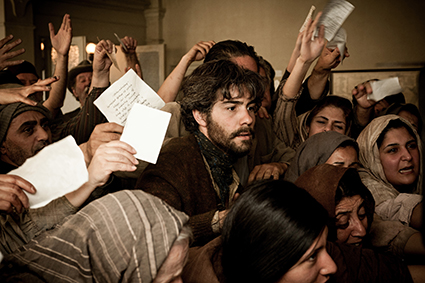
The Cut
The Cut
In The Cut, Fatih Akin, German filmmaker of Turkish origin and maker of the modern classics Head On (2004) and The Edge of Heaven (2007), has boldly gone where few (like Atom Egoyan with his Ararat, 2000) have trodden to address the Armenian genocide and its consequences, following a father as he searches for his two daughters from Turkey to Cuba and North Dakota: “On this odyssey, he encounters a range of very different people: angelic and kind-hearted characters, but also the devil incarnate”(press release).
We are young, We are strong
Afghan refugee Burhan Qurbani came to Germany in 1979 as a child, becoming a prize-winning short filmmaker and director of his first feature, the award winner Shahada, in 2010. In his second, We are young, We are strong, he evokes events of 1992 in Rostock, a former East German town impoverished by reunification. The film focuses on painful navigation of its citizens through unemployment and neo-Nazi violence against Vietnamese immigrants.
Comedies, thrillers, major commercial successes, documentaries and talks comprise the rest of a large, generous and enticing program playing ever widely across the country. RT
See the complete program.
14th AUDI FESTIVAL OF GERMAN FILMS, 13-31 MAY 2015
RealTime issue #126 April-May 2015 pg. 21
© RT ; for permission to reproduce apply to realtime@realtimearts.net
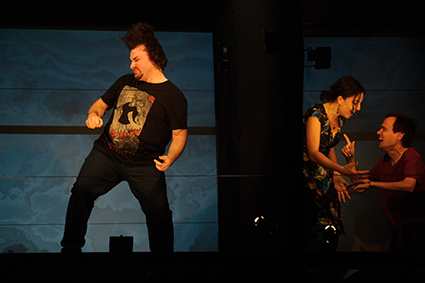
Rawcus Ensemble, Catalogue, Dance Massive, Arts House
photo Sarah Walker
Rawcus Ensemble, Catalogue, Dance Massive, Arts House
According to Immanuel Kant, we can only experience the world through the lens of space and time. Prue Lang’s Spaceproject puts this idea to work in relation to movement and its perception. A companion piece, Timeproject (shown in France, 2013), took up the same thought in relation to time.
Prue Lang, Spaceproject
Lang’s exploration is human-centred rather than merely objective. It also acknowledges the centrality of the body within all perceptual experience. For example, the dancers imaginatively make their way into the bush. Their perceptions of the local landscape and its flora and fauna are completely corporeal: spider webs get caught in their hands and fingers, they look up at a vast sky, and shelter from the rain by curling their bodies around one another under a table.
It is not that our perception of space is merely subjective. Our experience of objective space is mediated by a body which simultaneously feels. The question becomes how the two aspects, subjective and objective, cleave together. Lang deals with these issues in movement. The dancers walk in a series of floor patterns. They must negotiate their own bodies, via feeling (or proprioception) and visual cues. Add to that, the citation of compass-style directions and you have this interplay between subjective and objective space.
Lang plays between representations of space (eg imaginative trips to the bush) and existentially based spatial games that call for here and now movement decision making. To what extent can the imaginary offer insights into lived space? What does the difference between the actual and the virtual tell us about space? The work combines a range of ways into thinking about, or rather, dancing space. It also attempts to deal with ideas, perhaps too many, certainly too many for this particular piece. It feels like this work is the first draft of a more subtle, better thought through work which is more settled in the bodies of its dancers. This is, I think, more a question of time than of space.
Rawcus, Catalogue
Rawcus’ Catalogue is also human in scale. It tackles normative presumptions surrounding the human, recalibrating the scale towards a celebration of difference. The performance space is divided into cubes, cosy stages for one or more. Right from the get go, the performers assert their right to interpret popular culture in their own way, through sound and movement. The cult of celebrity is drawn upon by way of displacement (or strategic redeployment) rather than critique. Individual performers reinterpret popular songs through their bodies, celebrating their own singularity rather than resenting, or even referring to, the privileged place of the other. In that sense, Catalogue is pure affirmation. It doesn’t shy away from questions of loss or bereavement or illness but gives an everyday gloss to these elements, neither repudiating them nor denying their impact. So, we learn about these performers, who is ill, who lives with their parents, who is married and so on. I’m not sure whether this is a celebration of the ordinary or a way of finding beauty within it, like the plastic bags blowing in the wind in Sam Mendes’ film, American Beauty (1999). Catalogue finishes with an entire set of different faces, gesturing towards a new sense of the human beyond the specificity of the Rawcus crew.
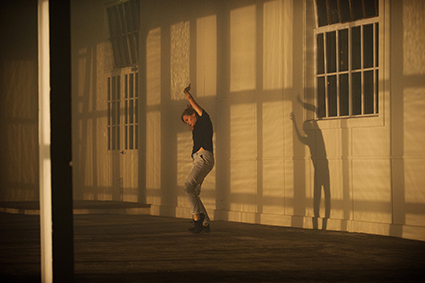
Rosalind Crisp, Boom Project, Dance Massive
photo Sarah Walker
Rosalind Crisp, Boom Project, Dance Massive
Rosalind Crisp, The Boom Project
Rosalind Crisp has a very distinctive way of improvising. It is as if she turns to her body as a source of movement material, to be played out for an observational consciousness (Crisp herself). This consciousness has no idea what will emerge but it is the viewer, the first audience for her dancing. So there is a naivety or freshness in Crisp, a beginner’s mind with respect to the dance. Her face is open, agnostic, unknowing. She looks at the audience, surprised that we are here. It is not that she is lost, rather she is absorbed in the ongoing corporeal revelations found in the dance. It is the dancing which leads her and not vice-versa. This manner of witnessing is enhanced in The Boom Project by the inclusion of a second witness and sometime dancer (Helen Herbertson). Together, that part of Crisp which watches and does not know and Herbertson who mostly watches, make space for new movement to arise. An unfamiliar space enhances this sense of unfolding serendipity. The large warehouse, a woodworking atelier, does not have a history of performance. The building is itself witness to something new. Designer Ben Cobham insinuates white, clear, cold light, in shafts, lines, creating spillage from another room. It’s delicate, like lace, the dance as lacemaking.
Shelley Lasica, Solos for Other People
It’s odd to think of a group work in solo terms but there is something about Shelley Lasica’s Solos for Other People that draws the gaze towards the singular dancer. This is in part because the choreography refers to Lasica’s own body. Even when others dance her material, it more or less looks like her. Some of these dancers have worked with Lasica for years. It shows. The dancing merges with who they are. Perhaps who they are is partly the result of working in this way.
So there is a strand of sameness or identity running throughout. And yet, after watching 10 people dance simultaneously, differences start to emerge; performative differences, in timing, attack, investment in the material, in the relation between the material and one’s own body. Clearly, nothing is guaranteed in the transmission of work from body to body. A body has to adapt itself to the material or the material adapts itself to the body. We see both.
The vastness of the space (a basketball court) means that one gaze cannot take in all that happens. The viewer is forced to make choices and thereby make do with an incomplete perception. There is always more than can be seen. I am surprised when the dancers circle the space and run out the door, as if the work is surely not over. There is a sense that it has been going on for a long time and continues to do so.
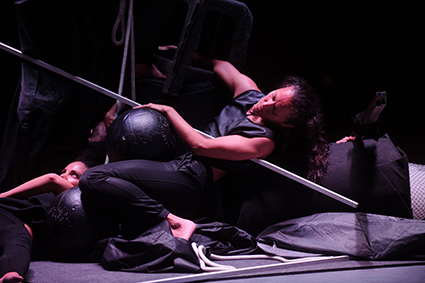
Antony Hamilton, Melanie Lane, Ashley McLellan and Sophia Ndaba, Merge, Dance Massive, Arts House
photo Sarah Walker
Antony Hamilton, Melanie Lane, Ashley McLellan and Sophia Ndaba, Merge, Dance Massive, Arts House
Melanie Lane, Merge
Melanie Lane’s Merge is uncanny, inhuman, odd to say the least. Ostensibly about our relation to the object, it seems to me to be an attempt to displace our sense of the human. The dancers are bent over, occupied by invisible concerns, quibbling over the space. The space is made and remade, via unexpected turns and twists. A simple square of carpet becomes a wall, turns a corner and becomes a labyrinth. Bodies become otherwise in partial obscurity. We don’t always know where one begins and another finishes. There is a great deal of play in Merge, of engagement with its material elements and among its four dancers. Towards the end, a plethora of objects is introduced, towards a monumental potlatch of destruction. Is this anarchy, hiatus, catharsis, apocalypse? The objects fail to produce an intensification of the action. Is this their ultimate revenge?
Dance Massive: Spaceproject, concept, direction: Prue Lang, choreography Lang and dancers, Dancehouse, 10-13 March; Rawcus, Catalogue, co-director: Kate Sulan, Ingrid Voorendt, deviser-performers Rawcus ensemble, Meat Market, 10-14 March; The Boom Project, dancer, choreographer Rosalind Crisp, companion, provocateur: Helen Herbertson, Blueprint Showroom, 13-21 March; Solos for other People, choreographer, director Shelley Lasica; Merge, choreographer Melanie Lane, Arts House, 18-22
RealTime issue #126 April-May 2015 pg. 22
© Philipa Rothfield; for permission to reproduce apply to realtime@realtimearts.net














































 Artfilms is a treasure house of interviews, documentaries and recorded performances. It’s now available for home streaming for artists and art lovers. Artfilms-digital has 750+ inspirational interviews, training and performance films in theatre, dance, music, design, visual and digital arts.
Artfilms is a treasure house of interviews, documentaries and recorded performances. It’s now available for home streaming for artists and art lovers. Artfilms-digital has 750+ inspirational interviews, training and performance films in theatre, dance, music, design, visual and digital arts.














































